A Review of Ontario’s Municipal Infrastructure and an Assessment of the State of Repair
1 | Summary
Overview and Background
- This report reviews the infrastructure assets owned by Ontario municipalities, estimates their current replacement value (CRV) and current condition, and estimates the costs to bring municipal assets into a state of good repair in 2020.
- Ontario’s 444 municipalities own and manage the majority of public infrastructure in the province, more than both the federal and provincial governments combined.
- Despite the importance of municipal infrastructure, a comprehensive municipal asset dataset does not exist. While Ontario’s municipalities are in the process of improving their asset data, current data varies in quality and availability. The results presented in this report are based on an asset inventory compiled by the FAO from currently available data sources and are subject to the FAO’s methodology.[1]
The Composition and Value of Municipal Infrastructure
- Ontario’s municipalities[2] own a wide range of infrastructure assets. This report focuses on roads and bridges, potable water, storm water and wastewater systems, parks and recreational facilities, social housing, solid waste disposal facilities, police stations, fire stations, public transit and other buildings.[3]
- The FAO estimates that the CRV of municipal infrastructure was $484 billion in 2020. CRV is the current cost of rebuilding an asset with the equivalent capacity, functionality and performance.
- Municipal roads and bridges are valued at almost $171 billion (35 per cent of total municipal CRV).
- Municipal water infrastructure, including potable water, storm water and wastewater, is valued at $229 billion (47 per cent of total CRV).
- The remaining $84 billion of assets (about 17 per cent) include transit sector infrastructure and buildings and facilities in other sectors.
State of Repair and the Municipal Infrastructure Backlog
- Keeping assets in a state of good repair[4] helps to maximize the benefits of public infrastructure, and ensures assets are delivering their intended services in a condition that is considered acceptable from both an engineering and a cost management perspective.
- The FAO was able to assess the condition of about 90 per cent of municipal assets in Ontario, representing about $437 billion (in CRV) of assets.
- For municipal assets with condition data, the FAO estimates that 54.7 per cent are in a state of good repair. However, given the uncertainty around actual asset conditions, this share could be approximately five percentage points higher or lower. The remaining 45.3 per cent of assets (+/- five percentage points) are estimated to be not in a state of good repair.[5]
- Generally, when an asset is no longer in a state of good repair, asset managers endeavor to bring the asset back into a state of good repair where appropriate and possible. The capital spending required to bring assets up to a state of good repair is defined in this report as the infrastructure backlog.[6] These costs do not include ongoing operations and maintenance expenses or any repair or replacement costs over the lifecycle of assets.
- The FAO estimates that the current municipal infrastructure backlog is about $52 billion. This would be the cost to bring municipal assets that require capital spending into a state of good repair in 2020.
- However, there is uncertainty on the precise condition of many municipal assets. The FAO estimates that the backlog could range from $45 billion to $59 billion.
- On a sector level, municipal roads represent the largest share of the infrastructure backlog at $21.1 billion, followed by ‘other’ buildings and facilities ($9.5 billion), wastewater ($7.3 billion), potable water ($5.3 billion), bridges and culverts ($4.3 billion), storm water ($3.8 billion) and transit ($1.0 billion).
- In addition, there is $47 billion of municipal assets whose condition is unknown. These assets are not included in the FAO’s infrastructure backlog estimates. If these assets were incorporated the size of the backlog would be larger.
- Maintaining public infrastructure in a state of good repair is generally the most cost-effective strategy over an asset’s life cycle but is not the only consideration for asset managers with multiple budgetary priorities. However, further postponing repairs raises the risk of service disruption and increases the costs associated with municipal infrastructure over time.
- For information on the state of repair and infrastructure backlog by economic region, see Appendix A. For a complete sectoral and asset-type breakdown of the state of repair and infrastructure backlog, see Appendix B. For a comparison between the state of repair of Ontario’s provincial infrastructure and municipal infrastructure, see Appendix C. For a description of FAO’s data and methodology, see Appendix D.
Figure 1‑1 Municipal infrastructure, the state of repair and the infrastructure backlog, 2020

Notes: The estimates presented under the state of repair of municipal infrastructure, type of repair required, cost of repair and infrastructure backlog are the average values from the FAO’s Monte Carlo analysis.
* Rehabilitation is the repair of all or part of an asset, extending its life beyond that of the original asset, without adding to its capacity, functionality or performance.
Renewal is the replacement of an existing asset, resulting in a new or as-new asset with an equivalent capacity, functionality and performance as the original asset. Renewal is different from rehabilitation, as renewal rebuilds the entire asset.
** This box represents older assets that will be left to deteriorate for several years before being completely replaced.
Source: FAO analysis of municipal data as detailed in Appendix D.
Accessible version
| ($ Billions) | Total Municipal Infrastructure | Condition Data Availability | State of Repair of Municipal Infrastructure | Type of Repair Required | Infrastructure Backlog |
|---|---|---|---|---|---|
| Current Replacement Value (CRV) | 484.2 | ||||
| Condition Data Available | 437 | ||||
| No Condition Data Available | 47.2 | ||||
| CRV of Assets in a State of Good Repair | 239.2 | ||||
| CRV of Assets Not in a State of Good Repair | 197.8 | ||||
| CRV of Assets in Need of Rehabilitation | 171.2 | ||||
| CRV of Assets in Need of Renewal | 24.3 | ||||
| CRV of Assets Not Currently in Need of Rehabilitation/Renewal | 2.4 | ||||
| Cost of Rehabilitation | 27.9 | ||||
| Cost of Renewal | 24.3 | ||||
| Total Infrastructure Backlog | 52.1 |
2 | Introduction and Background
Overview of Public Infrastructure
Public infrastructure and its state of repair has a direct impact on communities, facilitating the day-to-day operation of the economy and society, as well as providing capacity to deal with economic and social challenges that arise.[7]
Infrastructure assets are generally capital intensive, require extended development periods, and tend to have long useful lives.[8] Public infrastructure assets in Ontario include buildings, such as schools and hospitals; engineering infrastructure, such as the highway network and sewage and water systems; and machinery and equipment (M&E), such as transit buses and hospital equipment. Ownership of public infrastructure varies by the type of asset. For example, sewage infrastructure is largely owned by municipalities, while ownership of transportation infrastructure (road and highway networks and transit assets) is distributed largely between the Province and municipalities.[9]
Ontario’s 444 municipalities own the majority of public infrastructure assets in the province, a larger share of assets than both the provincial and federal governments combined.[10] Funds for municipal infrastructure come largely from municipal own-source revenues (51 per cent), although significant funding is also provided by federal (11 per cent) and provincial government transfers (8 per cent), along with government and private donations (11 per cent) and debt issuance (18 per cent).[11]
Despite the importance of municipal infrastructure, a comprehensive dataset of these assets is not available. In 2017, the Province passed Ontario Regulation 588/17,[12] mandating that municipalities must develop detailed asset inventories for their core infrastructure assets and eventually expand these inventories to cover all municipal assets. The deadline for municipalities to fulfill these requirements is July 1, 2022 for core infrastructure and July 1, 2024 for all assets. As these data sets are still in development, current municipal infrastructure data varies in quality and availability. To assess municipal infrastructure, the FAO compiled a municipal asset inventory from currently available sources.[13]
State of Repair and Infrastructure Backlog
Assessing the state of repair of public infrastructure, and keeping assets in a state of good repair[14] helps to maximize the benefits of public infrastructure and ensures assets are delivering their intended services in a condition that is considered acceptable from both an engineering and a cost management perspective.[15]
New assets enter service in a state of good repair. However, over time an asset deteriorates due to aging and ongoing use and eventually falls out of a state of good repair, at which point capital rehabilitation projects could be undertaken to maximize the service life of the asset. Falling out of a state of good repair does not necessarily mean that the asset is unsafe for use or is not functioning adequately.
Generally, when an asset is no longer in a state of good repair, asset managers endeavor to bring it back into a state of good repair when appropriate and possible. The cost required to bring assets into a state of good repair is defined in this report as the infrastructure backlog.[16] This cost includes both rehabilitating[17] assets that have fallen out of a state of good repair and renewing[18] assets that have fallen out of a state of good repair but cannot or should not be rehabilitated. These costs do not include ongoing operations and maintenance expenses or any repair or replacement costs over the lifecycle of assets. The estimates presented in this report are largely based on data standardization and forecasting methodology developed by Ontario’s Ministry of Infrastructure and further refined by the FAO.[19]
Purpose of this Report
The purpose of this report is to provide an overview of the infrastructure assets owned by Ontario’s municipalities, estimate their current replacement value, and assess their state of repair. The first section of this report reviews the infrastructure owned by municipalities and estimates their value. The second section assesses the state of repair of municipal infrastructure and provides an estimate of the infrastructure backlog.
This report does not analyze the fiscal capacity of municipalities to undertake the amount of capital investment required to eliminate the infrastructure backlog, nor does it assess the stock of municipal infrastructure against current demand and future expansion needs. This report does not provide any comparisons with other reports[20] on the state of repair of municipal infrastructure within Ontario or outside the province because of differences in definitions and methodologies which could cause inaccurate comparisons. Appendix A assesses municipal infrastructure’s state of repair by Economic Region. Appendix B lists the state of repair of municipal infrastructure by sector. Appendix C compares the state of repair of Ontario’s Provincial infrastructure with that of Ontario’s municipalities, while Appendix D describes the FAO’s data and methodology.
3 | Municipal Infrastructure
What Infrastructure do Municipalities Own?
Ontario’s 444 municipalities own more public infrastructure than both the provincial and federal government combined.[21] Municipal infrastructure includes a wide range of assets such as: potable water; storm water and wastewater systems; parks and recreational facilities; social housing, solid waste disposal; roads and bridges; police stations; fire stations; and public transit, among others.[22] These municipal assets are essential to economic and social activity in Ontario.
Data and Scope
There is no single data source that provides a complete picture of the value and condition of all infrastructure assets owned by Ontario’s municipalities. While work is underway by municipalities to document assets either through their own municipal datasets or Asset Management Plans (AMP), as required by Ontario Regulation 588/17,[23] publicly available asset data varies in quality and coverage.
Apart from individual municipal datasets and AMPs, there are also several other datasets that compile municipal infrastructure information, including:
- Statistics Canada’s Canadian Core Public Infrastructure (CCPI) survey
- Ontario Ministry of Municipal Affairs’ Financial Information Return (FIR)
- Ontario Ministry of Infrastructure’s (MOI) Municipal Asset Inventory.
These datasets present different types of information. For example, Statistics Canada’s CCPI dataset includes detailed information of municipal asset composition, condition and age, but not estimates of asset value, while the FIR presents accounting information reported by municipalities. Ontario Ministry of Infrastructure’s Municipal Asset Inventory provides condition and CRV estimates for the majority of municipal infrastructure. However, many of the sources used in MOI’s inventory have since been updated. As a result, the FAO compiled data from all these sources to develop an updated Municipal Asset Inventory (MAI). See Appendix D for additional details.
Due to data limitations, this report focusses on all “core” municipal assets[24] as well as some “non-core” assets including many types of municipal buildings. Excluded from the analysis were land, forestry, information technology, machinery and equipment and specific types of non-linear engineering infrastructure, such as artificial turf sports fields or playgrounds.
Table 3-1 summarizes the scope of municipal infrastructure assets examined in this report. For each sector, the table shows the different types of infrastructure assets included – buildings and facilities or engineering infrastructure – and provides a brief description of those assets.
| Sector | Asset-Types | Description |
|---|---|---|
Transit |
Buildings and Facilities Linear Engineering |
|
Roads |
Linear Engineering |
|
Bridges and Culverts |
Linear Engineering |
|
Potable Water |
Buildings and Facilities Linear Engineering |
|
Wastewater |
Buildings and Facilities Linear Engineering |
|
Storm water |
Buildings and Facilities Linear Engineering |
|
Other Facilities and Buildings |
Buildings and Facilities |
|
The Value of Municipal Infrastructure
To measure the value of infrastructure, asset managers use the concept of current replacement value (CRV). CRV is the current cost of rebuilding an asset with the equivalent capacity, functionality and performance as the original asset. CRV is adjusted for inflation and provides an estimate of asset value in today’s dollars.[25]
Based on the FAO’s analysis, the total CRV of municipal infrastructure in Ontario was approximately $484 billion, as of 2020. This represents the CRV of municipal buildings and facilities and linear engineering infrastructure in the province. Figure 3‑1 and Table 3-2 provide additional information on the breakdown of these assets.
Figure 3‑1 The current replacement value of municipal infrastructure in Ontario is about $484 billion in 2020

Source: FAO analysis of municipal data as detailed in Appendix D.
Accessible version
| Sector | ($ Billions) | Per Cent |
|---|---|---|
| Transit | 9.3 | 2 |
| Roads | 130.1 | 27 |
| Bridges and culverts | 40.4 | 8 |
| Potable water | 81.5 | 17 |
| Wastewater | 94.3 | 20 |
| Storm water | 53.6 | 11 |
| Other buildings and facilities | 74.9 | 15 |
| Sector | Total CRV ($ Billions) |
Description |
|---|---|---|
| Transit | $9.3 |
|
| Roads | $130.1 |
|
| Bridges and Culverts | $40.4 |
|
| Potable water | $81.5 |
|
| Wastewater | $94.3 |
|
| Storm water | $53.6 |
|
| Other buildings and facilities | $74.9 |
|
4 | The State of Repair of Municipal Infrastructure
Why State of Repair is Important
The state of repair of public infrastructure has a direct impact on the communities that the assets serve. Assessing the state of repair of Ontario’s municipal infrastructure, and determining the capital investment needed for those assets, provides an estimate of the costs to ensure that the infrastructure operates as intended.[26]
Keeping assets in a state of good repair[27] helps to maximize the benefits of public infrastructure, and ensures assets are delivering their intended services in a condition that is considered acceptable from both an engineering and a cost management perspective.[28]
New assets enter service in a state of good repair. However, over time an asset deteriorates due to aging and ongoing use and eventually falls out of a state of good repair, at which point capital rehabilitation projects could be undertaken to maximize the service life of the asset. Falling out of a state of good repair does not necessarily mean that the asset is unsafe for use or is not adequately fulfilling its function.
To assess whether assets are in a state of good repair, each asset’s condition was compared against standardized performance targets provided by the Ontario Ministry of Infrastructure and further developed by the FAO.[29] For each asset, these performance standards include repair targets, failure thresholds and useful life assumptions.[30]
For a detailed discussion on the methodology used in this report to measure state of repair see Appendix D.
Details on the State of Repair of Municipal Infrastructure
Ontario’s municipalities manage $484 billion of infrastructure assets. These assets can be grouped into five condition categories ranging from ‘Very Good’ to ’Very Poor’. Figure 4‑1 presents the reported condition data of all municipal assets examined in this report. Overall, 54.5 per cent of the assets are in ‘Good’ or better condition, while 35.8 per cent of the assets are in ‘Fair’ or worse condition. The remaining 10 per cent of assets had no condition data.
Figure 4‑1 The reported condition of municipal infrastructure by sector

Source: FAO analysis of municipal data as detailed in Appendix D.
Accessible version
| Sector | Very Good (Per Cent) |
Good (Per Cent) |
Fair (Per Cent) |
Poor (Per Cent) |
Very Poor (Per Cent) |
Unknown Condition (Per Cent) |
|---|---|---|---|---|---|---|
| Transit | 27.3 | 43.7 | 20.6 | 6.4 | 0.0 | 2.0 |
| Bridges and culverts | 12.8 | 52.9 | 21.3 | 6.2 | 2.6 | 4.2 |
| Roads | 17.4 | 28.7 | 29.0 | 15.6 | 3.5 | 5.7 |
| Potable water | 24.5 | 36.8 | 23.8 | 3.9 | 2.7 | 8.4 |
| Storm water | 23.0 | 25.8 | 14.1 | 6.8 | 2.3 | 28.0 |
| Wastewater | 37.6 | 25.1 | 17.1 | 5.6 | 2.7 | 11.9 |
| Other buildings and facilities | 18.8 | 28.4 | 37.8 | 5.3 | 3.3 | 6.4 |
| Total | 23.2 | 31.3 | 24.7 | 8.2 | 2.9 | 9.8 |
There is a considerable degree of uncertainty associated with the reported condition data. In some cases, reported condition data was based on engineering site inspections, while in other cases the data may be imputed based on the asset’s age, or may simply reflect the municipality’s judgement in the absence of a site inspection.
Additional uncertainty comes from the standards by which condition is assessed across municipalities. For example, an asset assessed to be in ‘Good’ condition in one municipality might be assessed as ‘Fair’ based on another municipality’s framework.
To account for this uncertainty, the FAO defined a broader boundary for the condition of each asset. For instance, an asset reported as ‘Good’ could take on a condition from ‘Very Good’ to ‘Fair’. [31] Based on this approach, the FAO developed a range of condition estimates.
On average, the FAO estimates that 54.7 per cent of municipal assets are in a state of good repair ($239.2 billion of infrastructure). However, given the uncertainty this share could range from 59 per cent in a best-case scenario to 50 per cent of assets at worst. On average, the remaining 45.3 per cent of assets are estimated to be not in a state of good repair ($197.8 billion of infrastructure), with a range of 41 to 50 per cent.
There is considerable variation in the state of repair of municipal infrastructure among sectors. Based on the results from the FAO’s analysis, the potable water sector has a relatively higher share of assets in a state of good repair compared to the overall average of 54.7 per cent, followed by wastewater and storm water. In contrast, the share of assets in a state of good repair in the transit, bridges and culverts, other buildings and facilities and roads sectors was below the overall average.
Figure 4‑2 State of repair of municipal infrastructure by sector

Note: The estimates presented are the average values from the FAO’s Monte Carlo analysis.
Source: FAO analysis of municipal data as detailed in Appendix D.
Accessible version
| Sector | Share of Assets in a State of Good Repair with Known Condition (Per Cent) |
Share of Assets not in a State of Good Repair with Known Condition (Per Cent) |
|---|---|---|
| Transit | 42.3 | 57.7 |
| Bridges and culverts | 50.2 | 49.8 |
| Roads | 43.8 | 56.2 |
| Potable water | 68.5 | 31.5 |
| Storm water | 67.0 | 33.0 |
| Wastewater | 67.3 | 32.7 |
| Other buildings and facilities | 41.6 | 58.4 |
| Total | 54.7 | 45.3 |
However, there is $47 billion of municipal assets whose condition is unknown. These assets were excluded from the assessment above and could materially shift the estimated percentage of assets considered in a state of good repair.
In addition, the storm water and wastewater sectors have a significantly higher share of assets without any condition information — increasing the uncertainty associated with the state of repair of these assets. Depending on the state of assets with unknown condition, the condition results of these sectors could be significantly different.
The Municipal Infrastructure Backlog
Generally, when an asset is no longer in a state of good repair, asset managers endeavor to bring the asset back into a state of good repair where appropriate and possible. The cost required to bring assets up to a state of good repair is defined in this report as the infrastructure backlog.[32] This cost includes both rehabilitating[33] assets that have fallen out of a state of good repair and renewing[34] assets that have fallen out of a state of good repair but cannot or should not be rehabilitated. The infrastructure backlog does not include operations and maintenance expenses, or the future lifecycle cost of an asset.
Estimating the spending required to address the infrastructure backlog helps asset managers plan and budget accordingly. Importantly, while some assets may not be in a state of good repair, it may be a prudent asset management strategy to not immediately undertake rehabilitation or renewal. For example, older assets that are no longer in a state of good repair might be left to deteriorate for several years before being completely replaced. Optimal asset management strategies will focus on maximizing the use of an asset, minimizing related costs, and balancing these needs against other priorities.
The calculations for the infrastructure backlog presented in this report are largely based on a modelling framework provided by the Ontario Ministry of Infrastructure and further developed by the FAO. This framework evaluates infrastructure data through a series of simplified asset management decisions to estimate the infrastructure backlog.[35]
To account for the uncertainty associated with the condition of municipal infrastructure, the FAO conducted a Monte Carlo analysis with 5,000 simulations. In each simulation, the model randomly selected the condition of each asset from the condition range described in Appendix D. The results of all simulations are then averaged to determine the average size of the municipal infrastructure backlog. Figure 4-3 shows the results for all 5,000 simulations of the municipal infrastructure backlog.
Figure 4‑3 Range of total municipal infrastructure backlog in Ontario ($ Billions)

Note: The chart represents the histogram of 5,000 Monte Carlo estimates of total infrastructure backlog. The height of each bar shows the number of times estimates from the simulations fall into the range of infrastructure backlog specified by the horizontal axis.
Source: FAO based on data and methodology described in Appendix D.
Accessible version
This figure presents the range of infrastructure backlog. The backlog could range from $44.8 billion to $58.7 billion, with an average value of $52.1 billion.
Based on the simulations, the FAO estimates that the municipal infrastructure backlog in Ontario could range from $44.8 billion to $58.7 billion, with an average value of $52.1 billion. The $52.1 billion backlog estimate is comprised of:
- $27.9 billion in rehabilitation costs, which are required to bring the $171.2 billion of assets in need of rehabilitation back to a state of good repair; and
- $24.3 billion in renewal costs, which are required for $24.3 billion of assets in need of replacement.
Of the $197.8 billion in municipal assets that are not in a state of good repair, about 99 per cent ($195.5 billion) currently require capital spending on rehabilitation or renewal. The remaining one per cent of assets ($2.4 billion) that are not in a state of good repair are older assets that will be left to deteriorate before eventually being replaced entirely. These assets are not included in the current infrastructure backlog estimate.
The $52.1 billion infrastructure backlog does not include any assets that have unknown conditions. Since some of these assets would likely be in need of rehabilitation or renewal, the FAO’s estimated backlog represents the lower bound of the municipal infrastructure backlog in Ontario.
Figure 4‑4 State of repair and the infrastructure backlog

Notes: The estimates presented under the state of repair of municipal infrastructure, type of repair required, cost of repair and infrastructure backlog are the average values from the FAO’s Monte Carlo analysis.
* Rehabilitation is the repair of all or part of an asset, extending its life beyond that of the original asset, without adding to its capacity, functionality or performance.
Renewal is the replacement of an existing asset, resulting in a new or as-new asset with an equivalent capacity, functionality and performance as the original asset. Renewal is different from rehabilitation, as renewal rebuilds the entire asset.
** This box represents older assets that will be left to deteriorate for several years before being completely replaced.
Source: FAO analysis of municipal data as detailed in Appendix D.
Accessible version
| ($ Billions) | Total Municipal Infrastructure | Condition Data Availability | State of Repair of Municipal Infrastructure | Type of Repair Required | Infrastructure Backlog |
|---|---|---|---|---|---|
| Current Replacement Value (CRV) | 484.2 | ||||
| Condition Data Available | 437 | ||||
| No Condition Data Available | 47.2 | ||||
| CRV of Assets in a State of Good Repair | 239.2 | ||||
| CRV of Assets Not in a State of Good Repair | 197.8 | ||||
| CRV of Assets in Need of Rehabilitation | 171.2 | ||||
| CRV of Assets in Need of Renewal | 24.3 | ||||
| CRV of Assets Not Currently in Need of Rehabilitation/Renewal | 2.4 | ||||
| Cost of Rehabilitation | 27.9 | ||||
| Cost of Renewal | 24.3 | ||||
| Total Infrastructure Backlog | 52.1 |
On a sector level, municipal roads represent the largest share of the infrastructure backlog at $21.1 billion, followed by other buildings and facilities ($9.5 billion), wastewater ($7.3 billion), potable water ($5.3 billion), bridges and culverts ($4.3 billion), storm water ($3.8 billion) and transit ($1.0 billion).
Figure 4‑5 Ontario municipalities’ $52.1 billion infrastructure backlog by sector
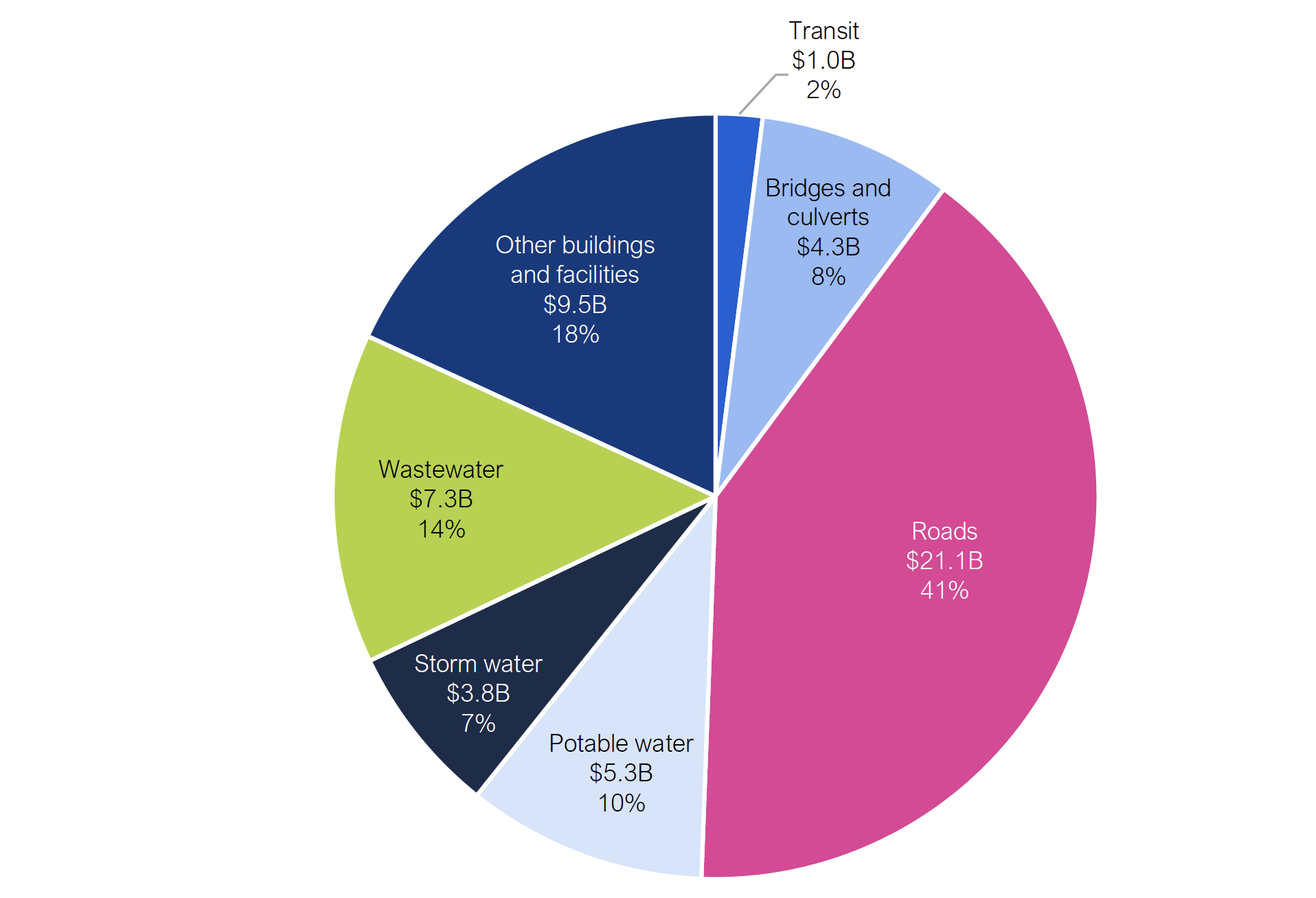
Note: The estimates presented are the average values from the FAO’s Monte Carlo analysis.
Source: FAO analysis of municipal data as detailed in Appendix D.
Accessible version
| Sector | ($ Billions) | Per Cent |
|---|---|---|
| Transit | 1.0 | 2 |
| Bridges and culverts | 4.3 | 8 |
| Roads | 21.1 | 41 |
| Potable water | 5.3 | 10 |
| Storm water | 3.8 | 7 |
| Wastewater | 7.3 | 14 |
| Other buildings and facilities | 9.5 | 18 |
The municipal infrastructure backlog can also be presented as a share of CRV. This ratio provides a measurement of average asset condition[36] and allows for comparisons across sectors, asset-types and regions. Overall, the municipal infrastructure backlog of $52.1 billion represents 11.9 per cent of the CRV of the municipal infrastructure with a known condition.
Figure 4‑6 Infrastructure backlog relative to the CRV of each sector
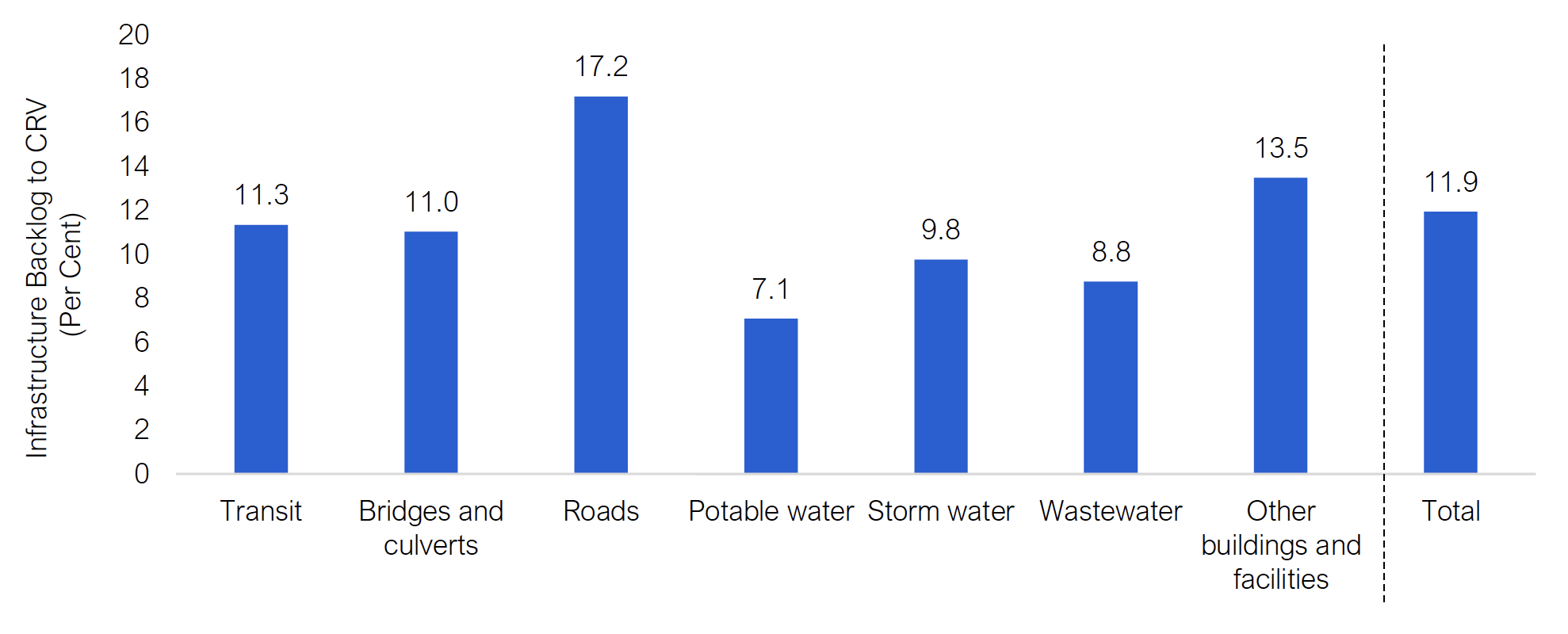
Note: The backlog to CRV presented in this chart only represents the CRV of assets with known conditions. The estimates presented are the average values from the FAO’s Monte Carlo analysis.
Source: FAO analysis of municipal data as detailed in Appendix D.
Accessible version
| Sector | Infrastructure Backlog as a Share of CRV (Per cent) |
|---|---|
| Transit | 11.3 |
| Bridges and culverts | 11.0 |
| Roads | 17.2 |
| Potable water | 7.1 |
| Storm water | 9.8 |
| Wastewater | 8.8 |
| Other buildings and facilities | 13.5 |
| Total | 11.9 |
- Municipal roads, which represent the largest share of total backlog, also have a relatively high backlog to CRV ratio (17.2 per cent). The backlog is mostly driven by local and arterial roads.
- Other buildings and facilities, which represent nearly 18 per cent of total backlog, have an infrastructure backlog to CRV ratio of 13.5 per cent. The backlog in this sector is driven by municipally owned tourism, culture and sport facilities.
- Potable water (7.1 per cent), wastewater (8.8 per cent), storm water (9.8 per cent), bridges and culverts (11.0 per cent), and transit (11.3 per cent) have relatively lower backlog to CRV ratios, implying that these assets are in relatively better condition compared to other sectors.
Addressing the Backlog
The estimated $52.1 billion municipal infrastructure backlog represents the current capital spending required to bring municipal assets into a state of good repair in 2020. However, it is not practically feasible to repair and replace all these assets in a single year. In addition, maintaining assets in a state of good repair is only one aspect of municipal asset management and may conflict with other budgetary priorities. Nonetheless, each year the backlog is not addressed, the cost of bringing assets into a state of good repair increases. This occurs because assets continue to deteriorate each year, while construction prices generally increase. Further postponing infrastructure repairs could raise the risk of service disruption and will increase the costs associated with municipal infrastructure over time.
State of Repair and Infrastructure Backlog by Region, Sector and Level of Government
For information on the state of repair and infrastructure backlog by economic region see Appendix A. For a complete sectoral and asset-type breakdown of the state of repair and infrastructure backlog see Appendix B. For a comparison of the state of repair of municipal and provincial infrastructure see Appendix C.
5 | Appendices
Appendix A : State of Repair by Economic Region
This section examines the state of repair of municipal infrastructure by economic region.[37] Each economic region encompasses all the municipalities within it.[38] For example, the Toronto economic region includes 24 different municipalities including the City of Toronto. The assets presented in this section include only those for which geographic and condition information[39] was available (90.0 per cent of municipal assets by CRV). The remaining 10 per cent of assets have either no geographic information or no condition information and are excluded from this regional analysis. Importantly, the results presented in this section are subject to uncertainty, and reflect the FAO’s best estimate of the CRV, condition and costs to bring assets into a state of repair for each economic region.
Figure A-1 Share of municipal assets in a state of good repair by economic region

Notes: Geographic location and condition data are available for 90 per cent of municipal assets. The remaining asset data did not have geographic and condition information. The estimates presented are the average values from the FAO’s Monte Carlo analysis.
Source: FAO analysis of municipal data as detailed in Appendix D.
Accessible version
| Economic Region | Share of Assets in a State of Good Repair* (% CRV with condition data) |
|---|---|
| Hamilton-Niagara Peninsula | 52.2% |
| Kingston-Pembroke** | 44.4% |
| Kitchener-Waterloo-Barrie | 53.7% |
| London | 58.8% |
| Muskoka-Kawarthas | 50.0% |
| Northeast** | 45.8% |
| Northwest** | 51.4% |
| Ottawa | 38.7% |
| Stratford-Bruce Peninsula | 45.3% |
| Toronto | 62.3% |
| Windsor-Sarnia | 51.6% |
| Regional Subtotal | 54.7% |
There is a large variation in the state of repair of municipal infrastructure across Ontario’s economic regions. The region with the largest share of assets in a state of good repair is the Toronto economic region at 62.3 per cent, which is 7.6 percentage points higher than the provincewide average. In contrast, the Ottawa economic region has the lowest share of assets in a state of good repair at 38.7 percent, 16.1 percentage points lower than the provincewide average.
The infrastructure backlog can also be presented as a share of total current replacement value, which allows for comparisons across regions. The regions of Toronto (9.0 per cent) and London (10.9 per cent) have the lowest shares, implying that their assets are in better condition compared to other regions. In contrast, the region with the largest infrastructure backlog relative to its total CRV is Kingston-Pembroke, at 19.7 per cent, followed by Stratford-Bruce Peninsula at 17.9 per cent.
Figure A-2 Infrastructure backlog as a share of current replacement value by economic region
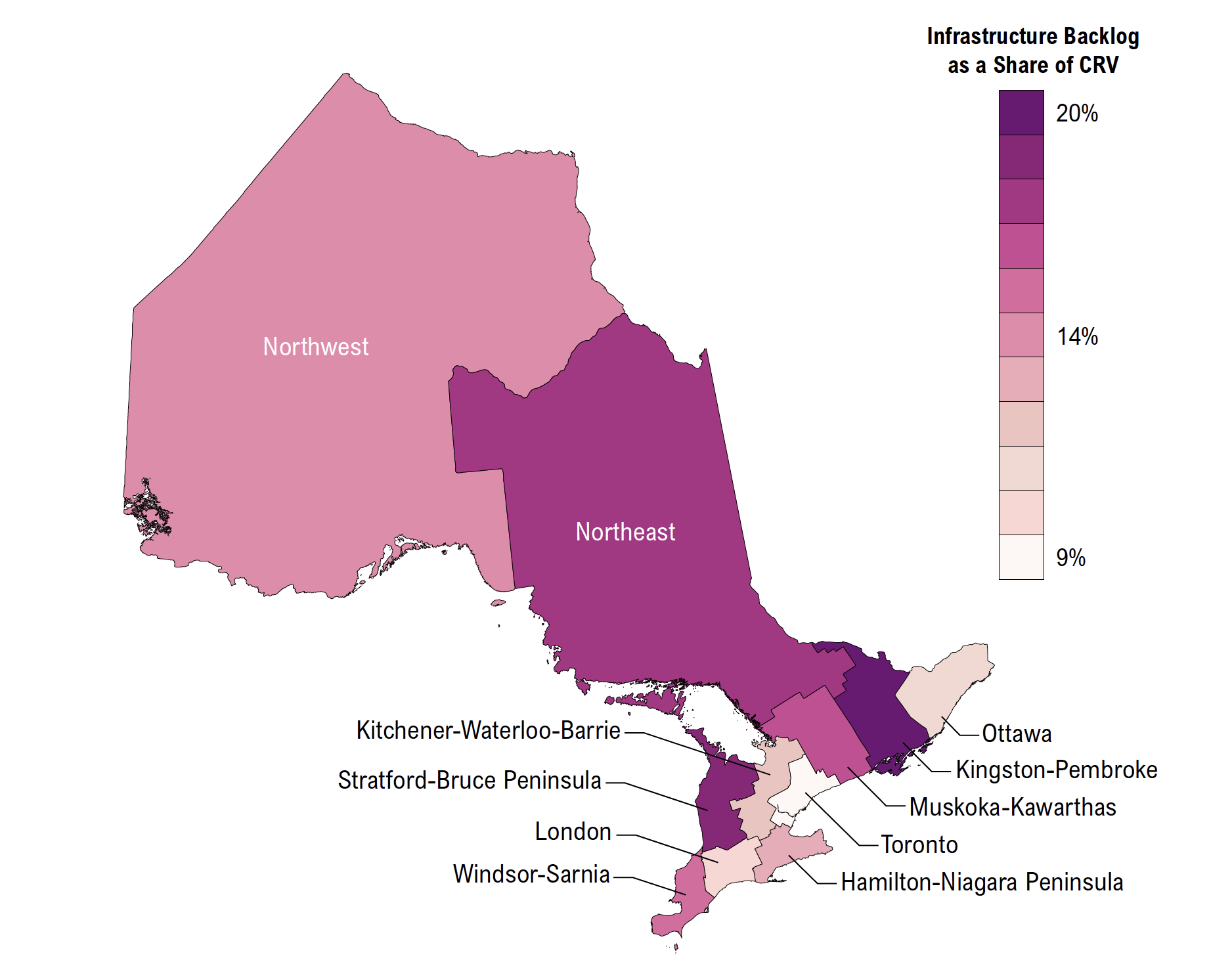
Notes: Geographic location and condition data are available for 90 per cent of municipal assets. The remaining asset data did not have geographic and condition information. The estimates presented are the average values from the FAO’s Monte Carlo analysis.
Source: FAO analysis of municipal data as detailed in Appendix D.
Accessible version
| Economic Region | Infrastructure Backlog as a Share of CRV* (% CRV with condition data) |
|---|---|
| Hamilton-Niagara Peninsula | 14.1% |
| Kingston-Pembroke** | 19.7% |
| Kitchener-Waterloo-Barrie | 12.6% |
| London | 10.9% |
| Muskoka-Kawarthas | 15.4% |
| Northeast** | 17.2% |
| Northwest** | 14.3% |
| Ottawa | 11.5% |
| Stratford-Bruce Peninsula | 17.9% |
| Toronto | 9.0% |
| Windsor-Sarnia | 14.5% |
| Regional Subtotal | 11.9% |
| Economic Region | Current Replacement Value (CRV) ($ Billions) |
CRV of Assets with Condition Data ($ Billions) |
CRV of Assets in a State of Good Repair ($ Billions) |
Share of Assets in a State of Good Repair* (% CRV with condition data) |
CRV of Assets Not in a State of Good Repair ($ Billions) |
Share of Assets Not in a State of Good Repair* (% CRV with condition data) |
Infrastructure Backlog ($ Billions) |
Infrastructure Backlog as a Share of CRV* (% CRV with condition data) |
|---|---|---|---|---|---|---|---|---|
| Hamilton-Niagara Peninsula | 62.2 | 56.3 | 29.4 | 52.2% | 26.9 | 47.8% | 7.9 | 14.1% |
| Kingston-Pembroke** | 18.3 | 15.7 | 7.0 | 44.4% | 8.7 | 55.6% | 3.1 | 19.7% |
| Kitchener-Waterloo-Barrie | 47.5 | 41.1 | 22.1 | 53.7% | 19.0 | 46.3% | 5.2 | 12.6% |
| London | 40.9 | 38.3 | 22.5 | 58.8% | 15.8 | 41.2% | 4.2 | 10.9% |
| Muskoka-Kawarthas | 14.1 | 13.3 | 6.7 | 50.0% | 6.7 | 50.0% | 2.1 | 15.4% |
| Northeast** | 14.6 | 12.1 | 5.5 | 45.8% | 6.5 | 54.2% | 2.1 | 17.2% |
| Northwest** | 6.3 | 5.4 | 2.8 | 51.4% | 2.6 | 48.6% | 0.8 | 14.3% |
| Ottawa | 44.3 | 43.1 | 16.7 | 38.7% | 26.5 | 61.3% | 4.9 | 11.5% |
| Stratford-Bruce Peninsula | 16.8 | 15.1 | 6.8 | 45.3% | 8.3 | 54.7% | 2.7 | 17.9% |
| Toronto | 183.4 | 170.4 | 106.2 | 62.3% | 64.2 | 37.7% | 15.4 | 9.0% |
| Windsor-Sarnia | 29.7 | 26.2 | 13.5 | 51.6% | 12.7 | 48.4% | 3.8 | 14.5% |
| Regional Subtotal | 478.2 | 437.0 | 239.2 | 54.7% | 197.8 | 45.3% | 52.1 | 11.9% |
| No Geographical Information | 6.1 | |||||||
| Total | 484.2 | |||||||
The information presented below describes the state of repair and infrastructure backlog by sector for each of Ontario’s 11 economic regions.[40] This information includes:
- Land area, population, current replacement value of assets and infrastructure backlog as a share of the total municipal backlog.
- The share of assets in a state of good repair compared to the provincewide municipal average, which provides a measure of the relative condition of the region’s assets.
- The infrastructure backlog to current replacement value ratio compared to the provincewide municipal average, which indicates whether the assets in a region require higher or lower spending, relative to the municipal average.
Profile of Municipal Infrastructure: Hamilton-Niagara Peninsula
Key Facts
| Current Replacement Value (CRV, billions) | $62.2 |
|---|---|
| CRV share of municipal assets in Ontario | 12.8% |
| Municipal infrastructure backlog (billions) | $7.9 |
| Share of municipal Infrastructure backlog in Ontario | 15.2% |
| Population | 1,523,062 |
| Population share of Ontario | 10.5% |
| Land area (square km) | 7,145 |
| Land area share of Ontario | 0.8% |

$62.2 billion Current Replacement Value of Assets
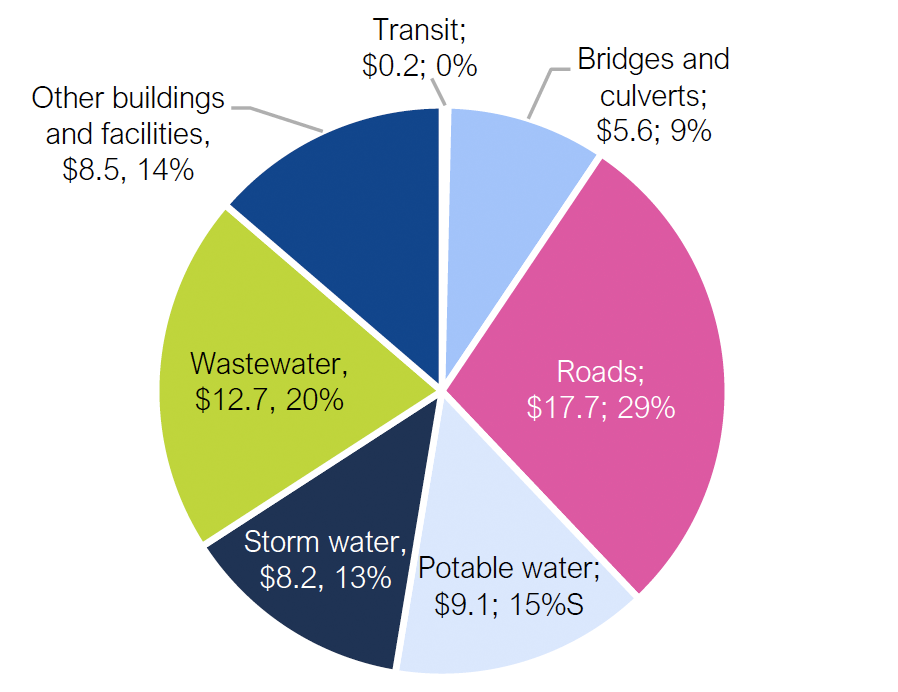
Share of Assets in a State of Good Repair*
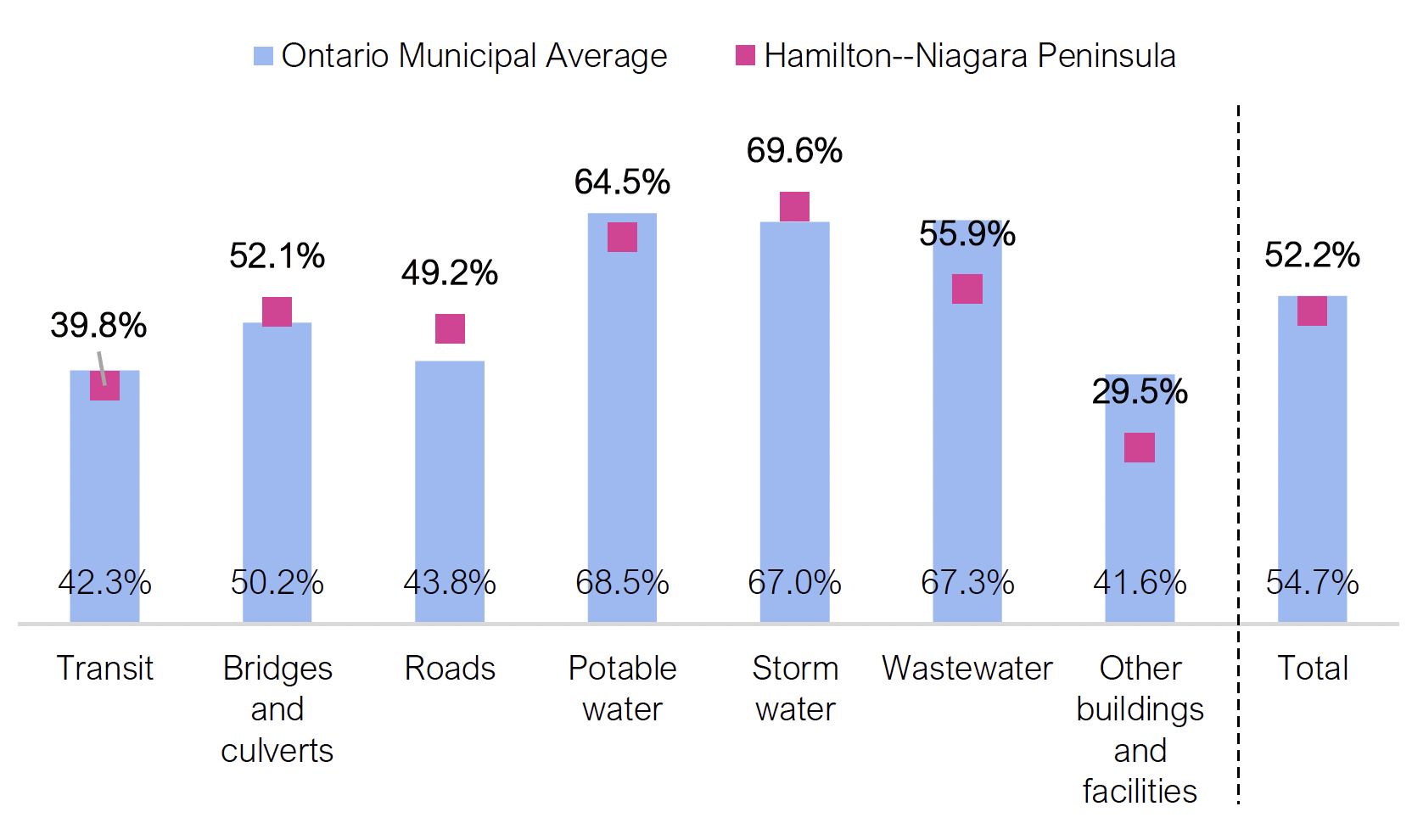
$7.9 billion Infrastructure Backlog
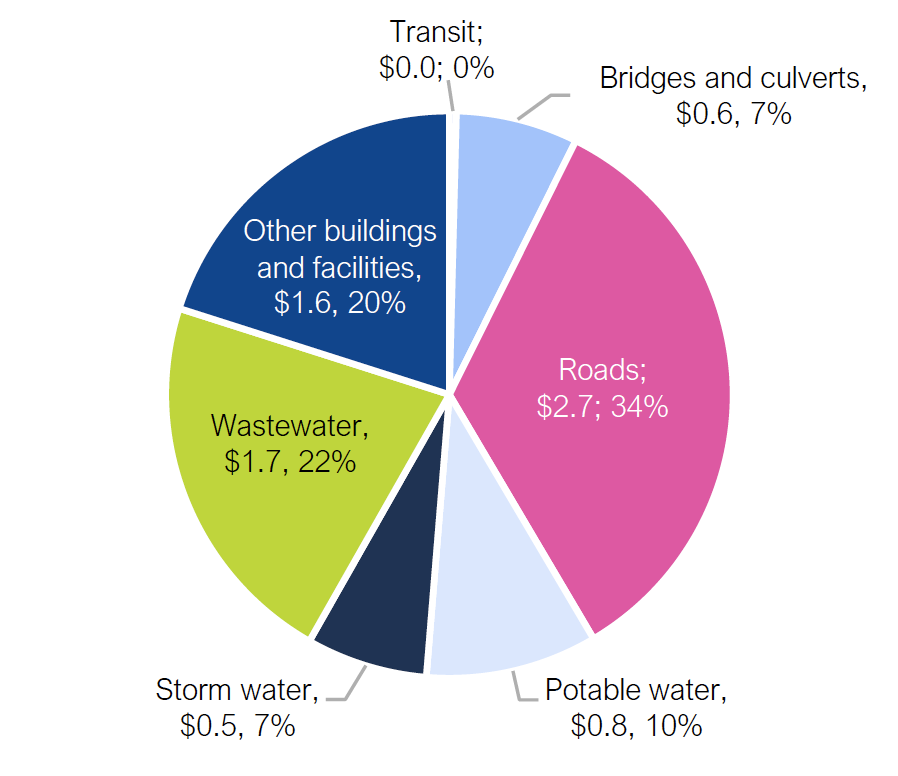
Infrastructure Backlog as a Share of CRV*
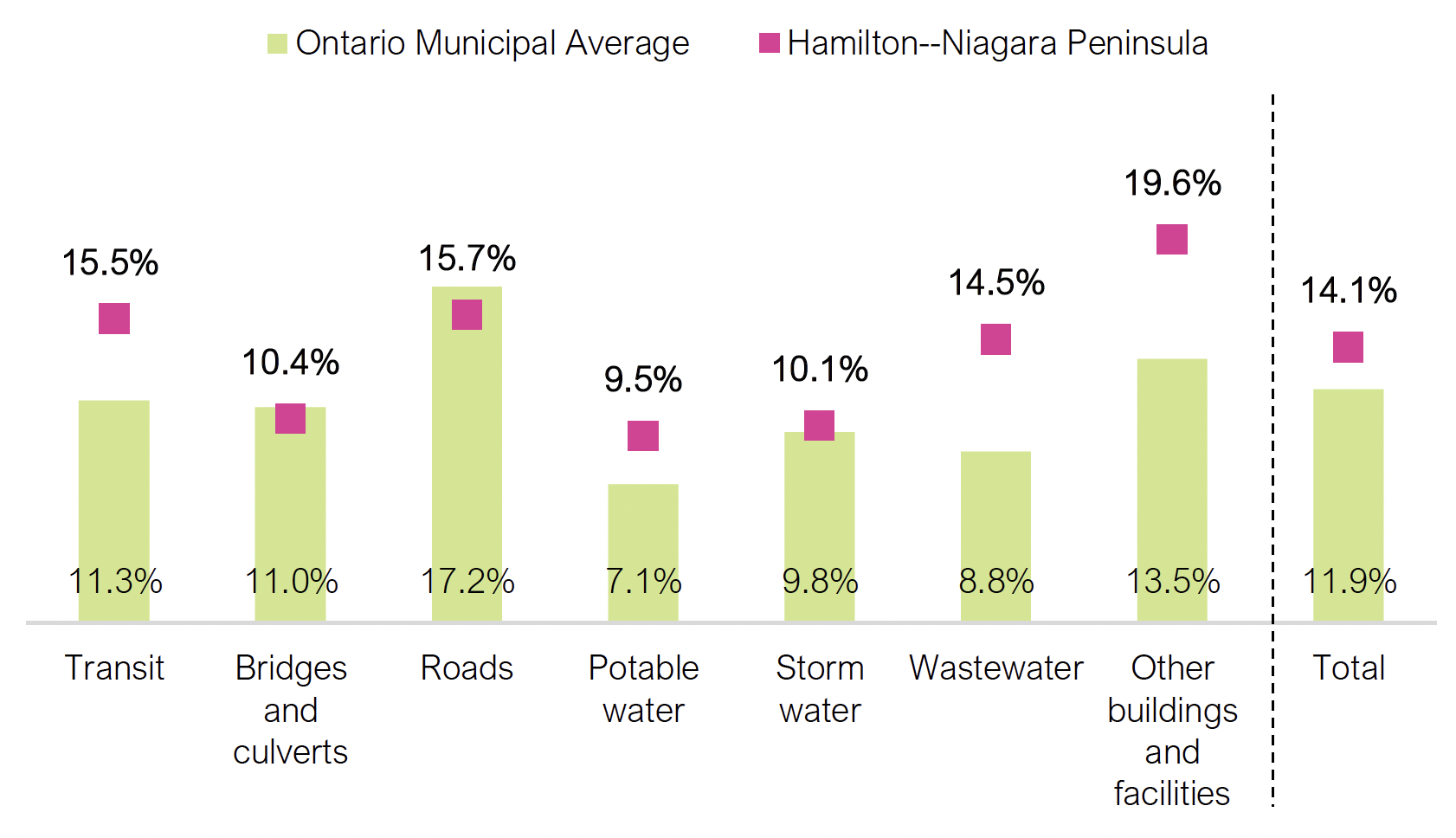
*Calculated as a share of the CRV of assets that have condition data.
Notes: The regional figures presented in these tables only encompass assets that have geolocations. The estimates presented under the state of repair and infrastructure backlog are the average values from the FAO’s Monte Carlo analysis.
Sources: Statistics Canada and FAO analysis of municipal data as detailed in Appendix D.
Accessible version
| Economic Region | Sector | Current Replacement Value of Assets ($ Billions) |
Infrastructure Backlog ($ Billions) |
Share of Assets in a State of Good Repair with Known Condition (Per Cent) |
Infrastructure Backlog as a Share of CRV with Known Condition (Per Cent) |
|---|---|---|---|---|---|
| Hamilton–Niagara Peninsula | Transit | 0.2 | 0.0 | 39.8 | 15.5 |
| Hamilton–Niagara Peninsula | Bridges and culverts | 5.6 | 0.6 | 52.1 | 10.4 |
| Hamilton–Niagara Peninsula | Roads | 17.7 | 2.7 | 49.2 | 15.7 |
| Hamilton–Niagara Peninsula | Potable water | 9.1 | 0.8 | 64.5 | 9.5 |
| Hamilton–Niagara Peninsula | Storm water | 8.2 | 0.5 | 69.6 | 10.1 |
| Hamilton–Niagara Peninsula | Wastewater | 12.7 | 1.7 | 55.9 | 14.5 |
| Hamilton–Niagara Peninsula | Other buildings and facilities | 8.5 | 1.6 | 29.5 | 19.6 |
| Hamilton–Niagara Peninsula | Total | 62.2 | 7.9 | 52.2 | 14.1 |
Profile of Municipal Infrastructure: Kingston-Pembroke
Key Facts
| Current Replacement Value (CRV, billions) | $18.3 |
|---|---|
| CRV share of municipal assets in Ontario | 3.8% |
| Municipal infrastructure backlog (billions) | $3.1 |
| Share of municipal Infrastructure backlog in Ontario | 5.9% |
| Population | 486,133 |
| Population share of Ontario | 3.3% |
| Land area (square km) | 21,230 |
| Land area share of Ontario | 2.3% |
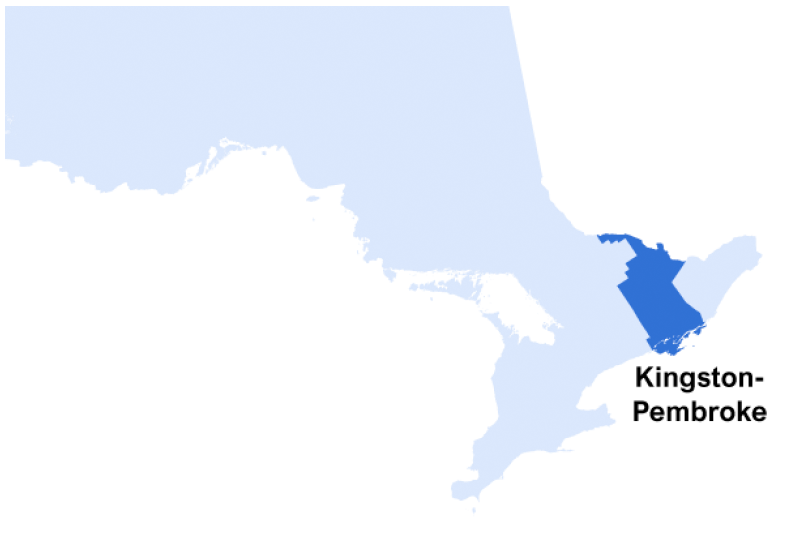
$18.3 billion Current Replacement Value of Assets
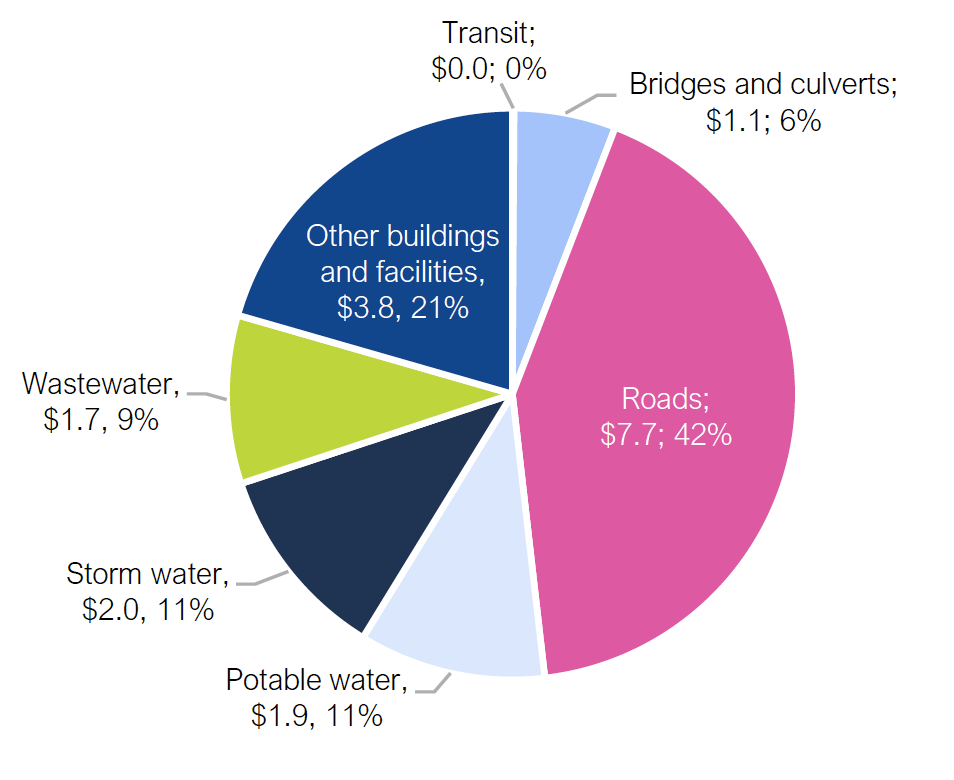
Share of Assets in a State of Good Repair*

$3.1 billion Infrastructure Backlog
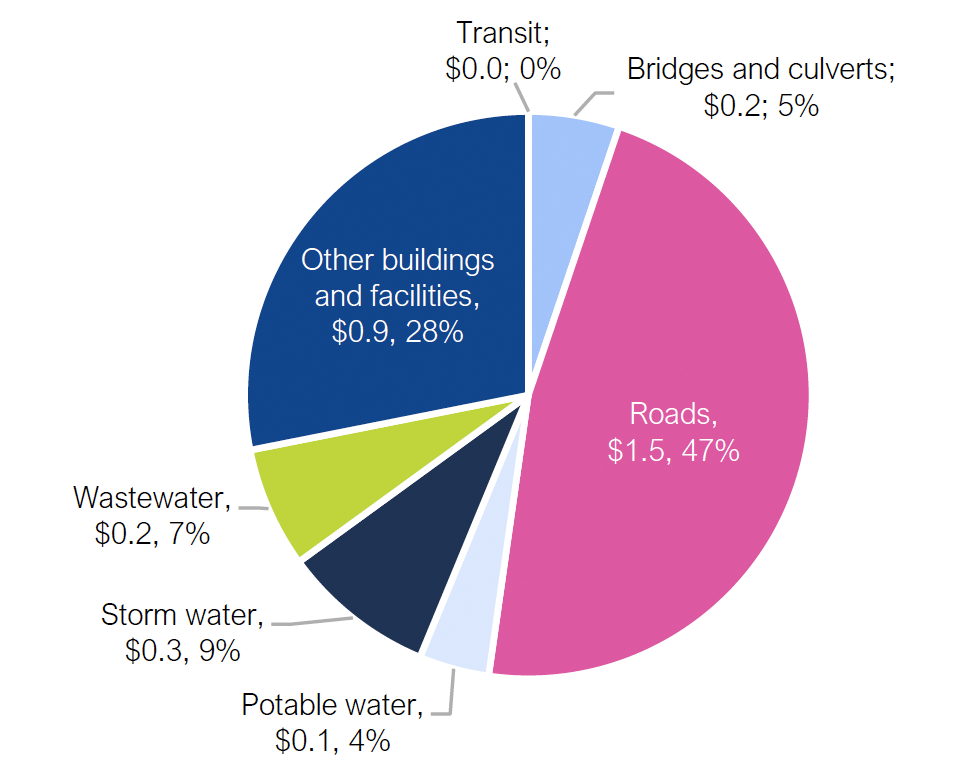
Infrastructure Backlog as a Share of CRV*
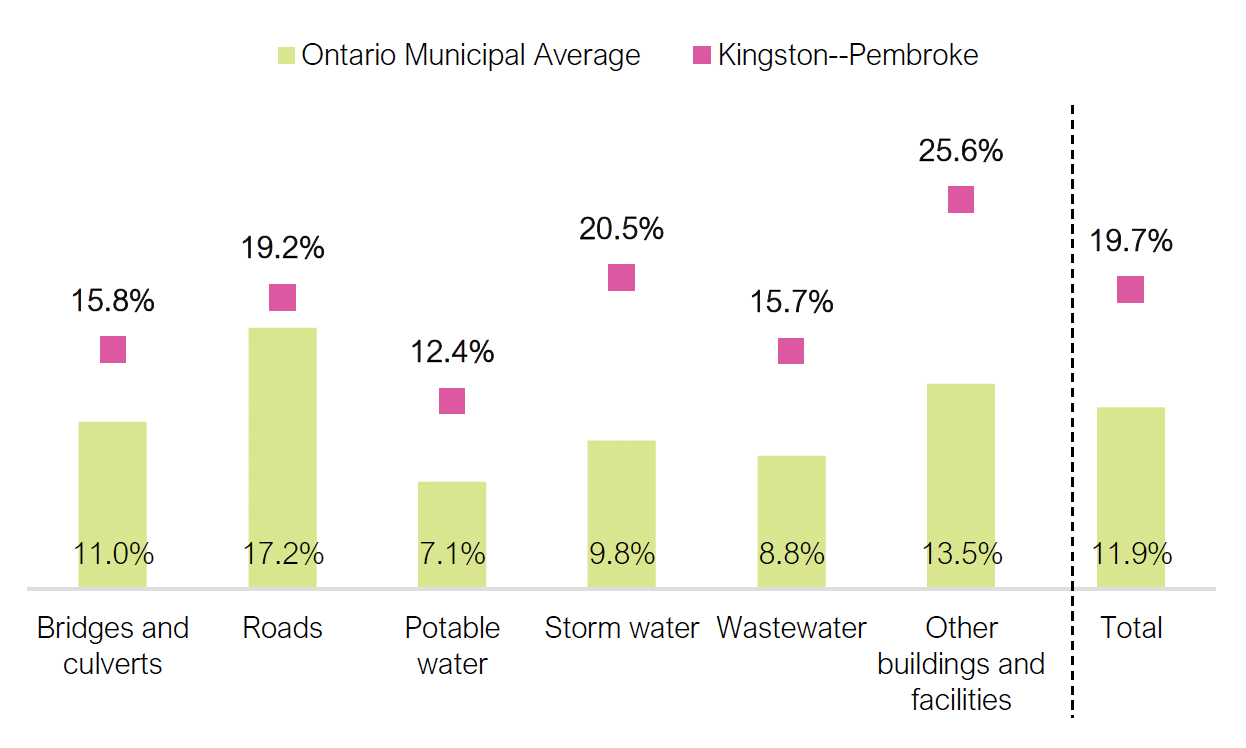
*Calculated as a share of the CRV of assets that have condition data.
Notes: The regional figures presented in these tables only encompass assets that have geolocations. Results of this economic region are subject to a higher degree of uncertainty. Some results for the transit sector are excluded. The estimates presented under the state of repair and infrastructure backlog are the average values from the FAO’s Monte Carlo analysis.
Sources: Statistics Canada and FAO analysis of municipal data as detailed in Appendix D.
Accessible version
| Economic Region | Sector | Current Replacement Value of Assets ($ Billions) | Infrastructure Backlog ($ Billions) | Share of Assets in a State of Good Repair with Known Condition (Per Cent) | Infrastructure Backlog as a Share of CRV with Known Condition (Per Cent) |
|---|---|---|---|---|---|
| Kingston–Pembroke | Bridges and culverts | 1.1 | 0.2 | 46.3 | 15.8 |
| Kingston–Pembroke | Roads | 7.7 | 1.5 | 43.9 | 19.2 |
| Kingston–Pembroke | Potable water | 1.9 | 0.1 | 55.3 | 12.4 |
| Kingston–Pembroke | Storm water | 2.0 | 0.3 | 47.3 | 20.5 |
| Kingston–Pembroke | Wastewater | 1.7 | 0.2 | 53.2 | 15.7 |
| Kingston–Pembroke | Other buildings and facilities | 3.8 | 0.9 | 36.8 | 25.6 |
| Kingston–Pembroke | Total | 18.3 | 3.1 | 44.4 | 19.7 |
Profile of Municipal Infrastructure: Kitchener-Waterloo-Barrie
Key Facts
| Current Replacement Value (CRV, billions) | $47.5 |
|---|---|
| CRV share of municipal assets in Ontario | 9.8% |
| Municipal infrastructure backlog (billions) | $5.2 |
| Share of municipal Infrastructure backlog in Ontario | 10.0% |
| Population | 1,432,654 |
| Population share of Ontario | 9.8% |
| Land area (square km) | 10,376 |
| Land area share of Ontario | 1.1% |
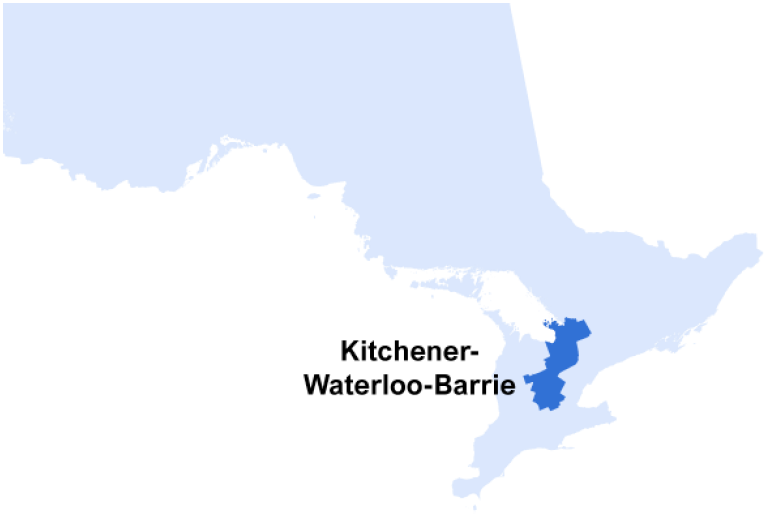
$47.5 billion Current Replacement Value of Assets
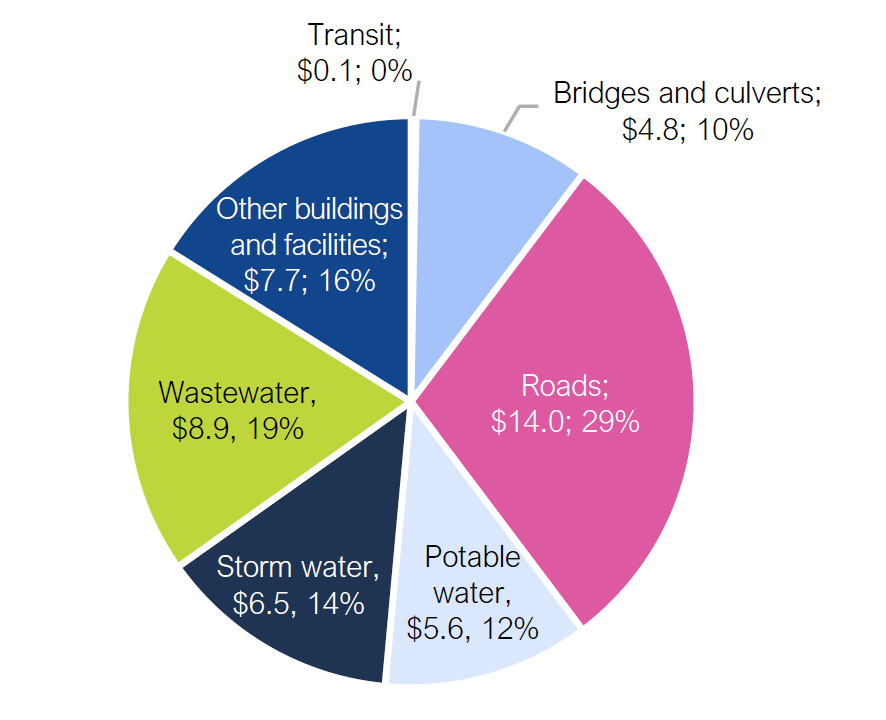
Share of Assets in a State of Good Repair*
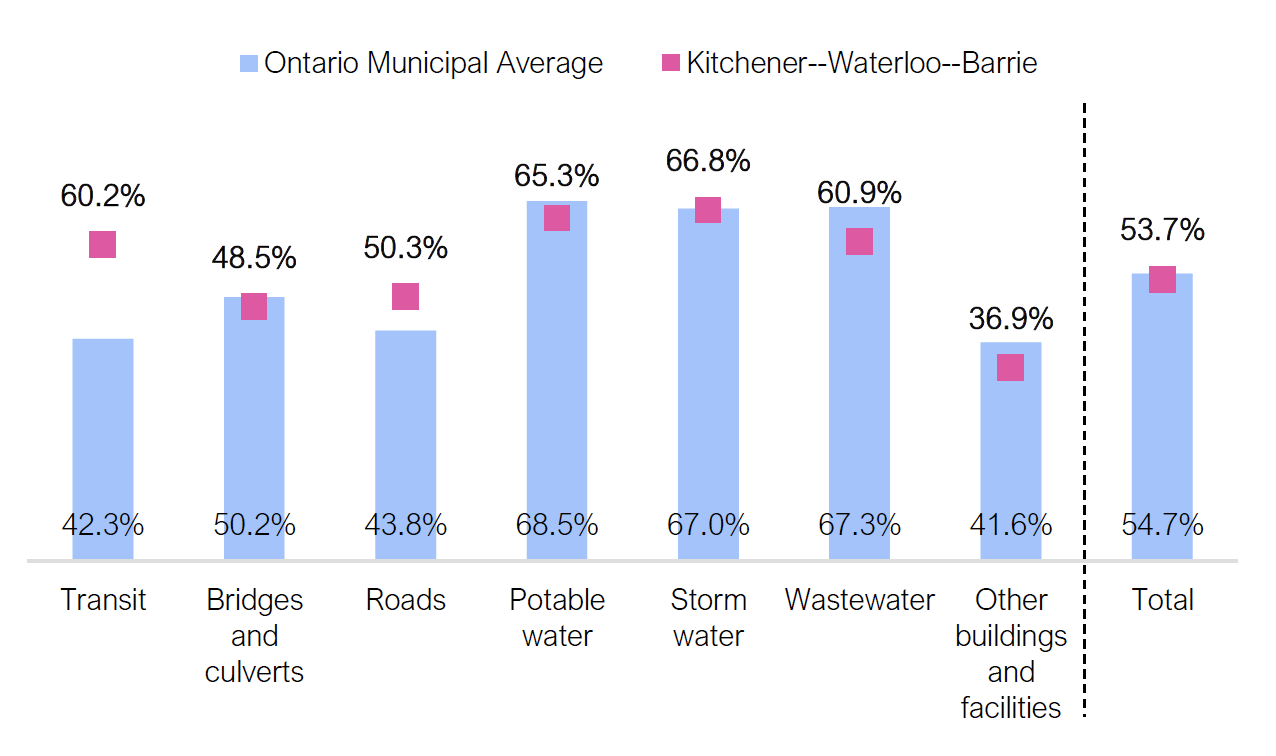
$5.2 billion Infrastructure Backlog
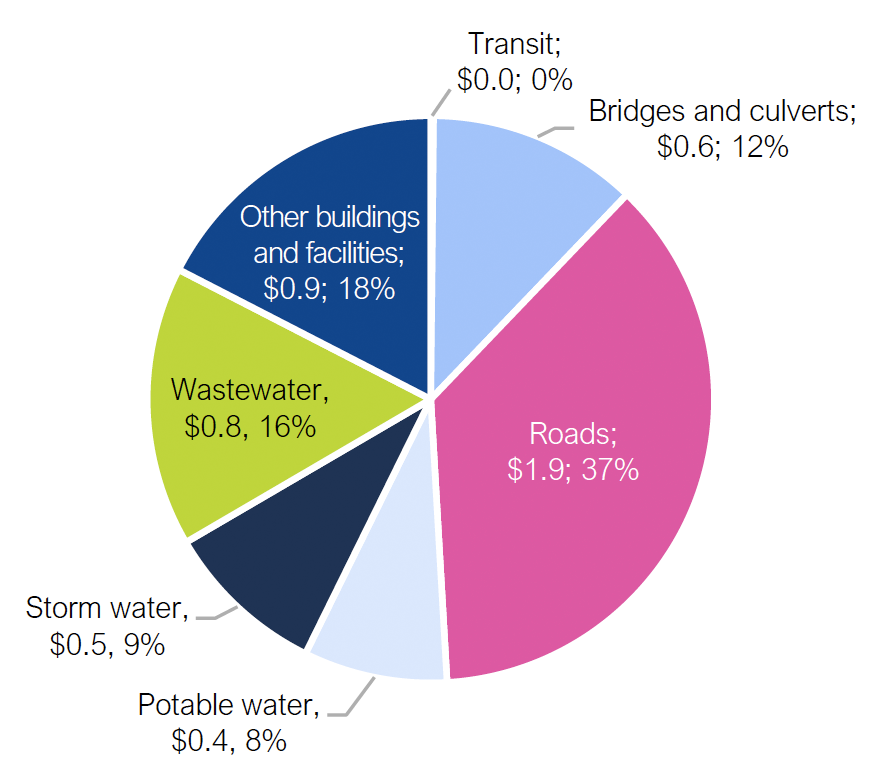
Infrastructure Backlog as a Share of CRV*
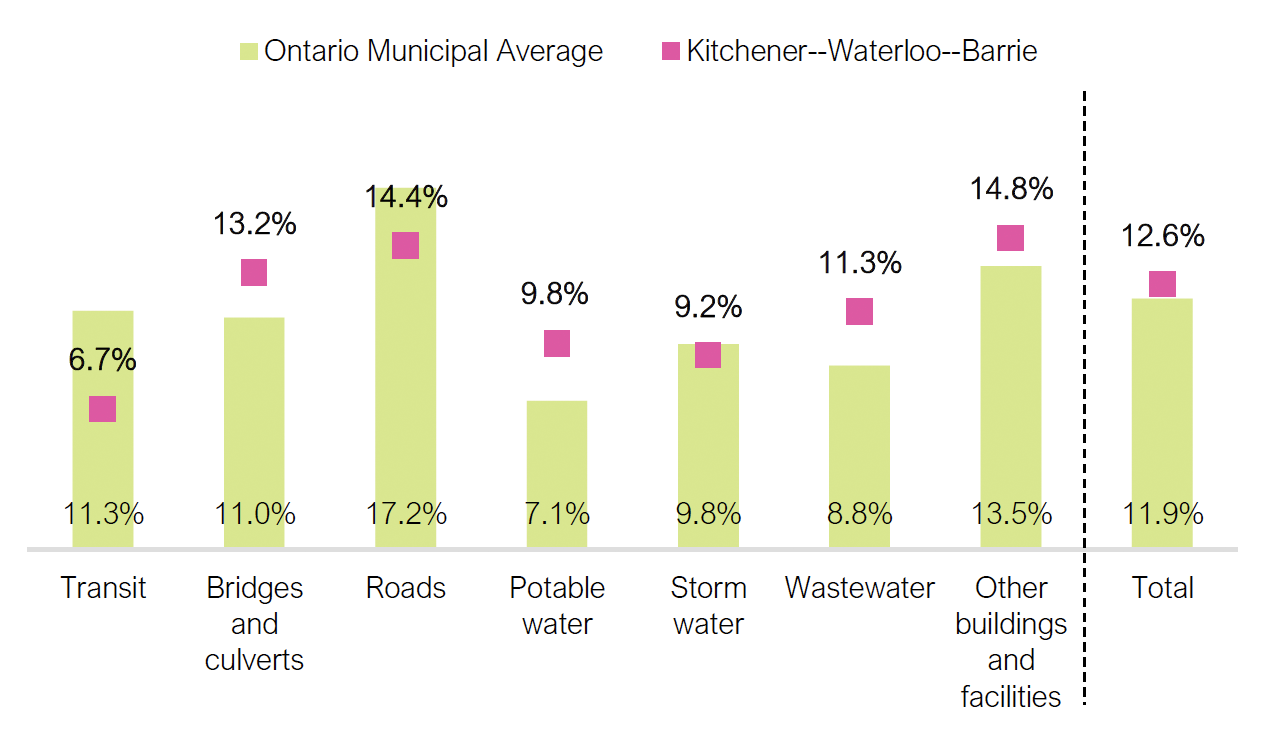
*Calculated as a share of the CRV of assets that have condition data.
Notes: The regional figures presented in these tables only encompass assets that have geolocations. The estimates presented under the state of repair and infrastructure backlog are the average values from the FAO’s Monte Carlo analysis.
Sources: Statistics Canada and FAO analysis of municipal data as detailed in Appendix D.
Accessible version
| Economic Region | Sector | Current Replacement Value of Assets ($ Billions) |
Infrastructure Backlog ($ Billions) |
Share of Assets in a State of Good Repair with Known Condition (Per Cent) |
Infrastructure Backlog as a Share of CRV with Known Condition (Per Cent) |
|---|---|---|---|---|---|
| Kitchener–Waterloo–Barrie | Transit | 0.1 | 0.0 | 60.2 | 6.7 |
| Kitchener–Waterloo–Barrie | Bridges and culverts | 4.8 | 0.6 | 48.5 | 13.2 |
| Kitchener–Waterloo–Barrie | Roads | 14.0 | 1.9 | 50.3 | 14.4 |
| Kitchener–Waterloo–Barrie | Potable water | 5.6 | 0.4 | 65.3 | 9.8 |
| Kitchener–Waterloo–Barrie | Storm water | 6.5 | 0.5 | 66.8 | 9.2 |
| Kitchener–Waterloo–Barrie | Wastewater | 8.9 | 0.8 | 60.9 | 11.3 |
| Kitchener–Waterloo–Barrie | Other buildings and facilities | 7.7 | 0.9 | 36.9 | 14.8 |
| Kitchener–Waterloo–Barrie | Total | 47.5 | 5.2 | 53.7 | 12.6 |
Profile of Municipal Infrastructure: London
Key Facts
| Current Replacement Value (CRV, billions) | $40.9 |
|---|---|
| CRV share of municipal assets in Ontario | 8.5% |
| Municipal infrastructure backlog (billions) | $4.2 |
| Share of municipal Infrastructure backlog in Ontario | 8.0% |
| Population | 721,409 |
| Population share of Ontario | 5.0% |
| Land area (square km) | 7,238 |
| Land area share of Ontario | 0.8% |
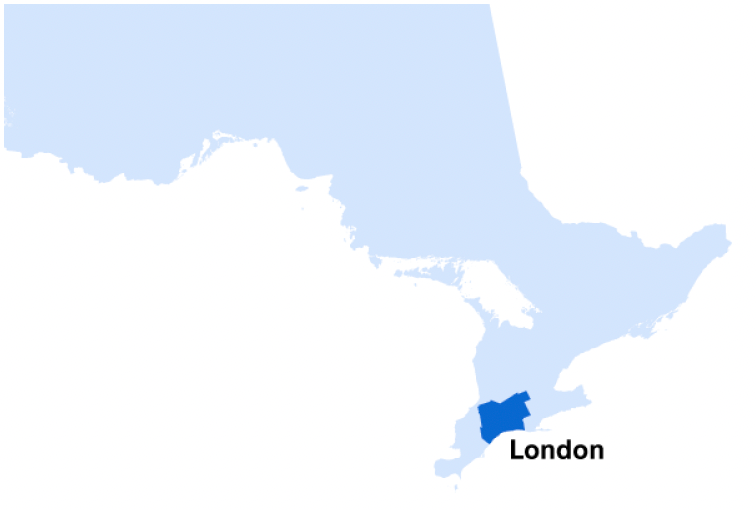
$40.9 billion Current Replacement Value of Assets
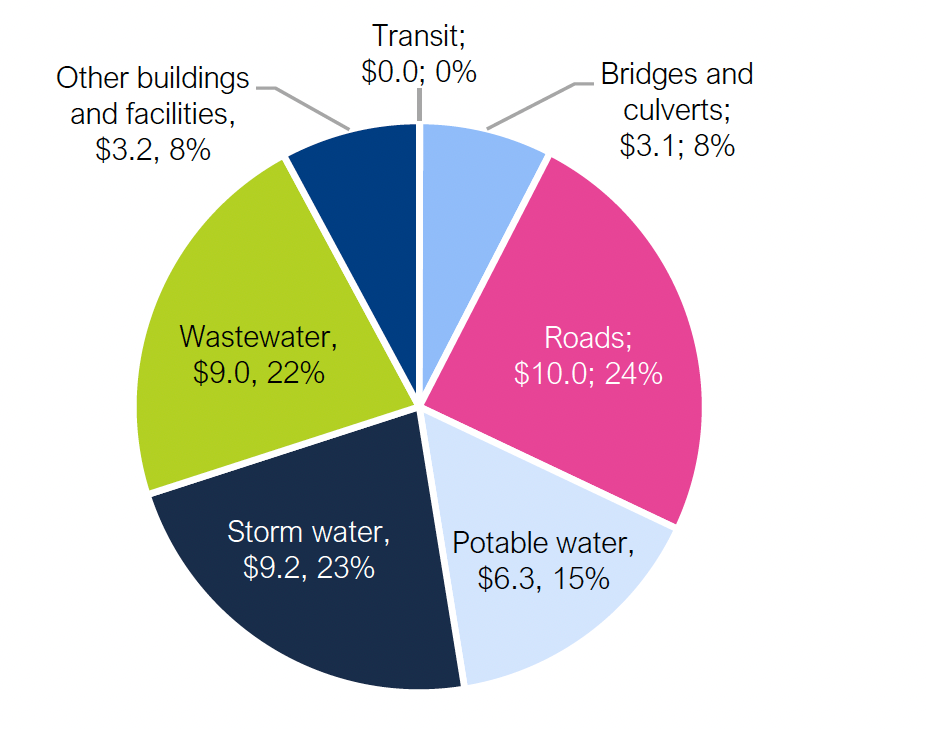
Share of Assets in a State of Good Repair*

$4.2 billion Infrastructure Backlog
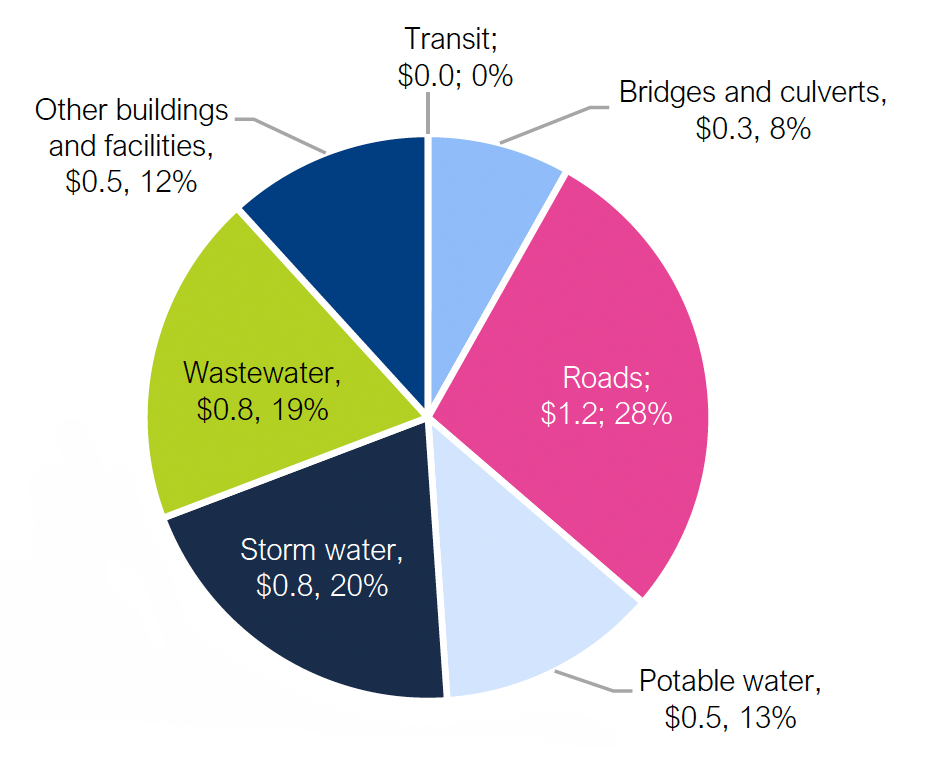
Infrastructure Backlog as a Share of CRV*
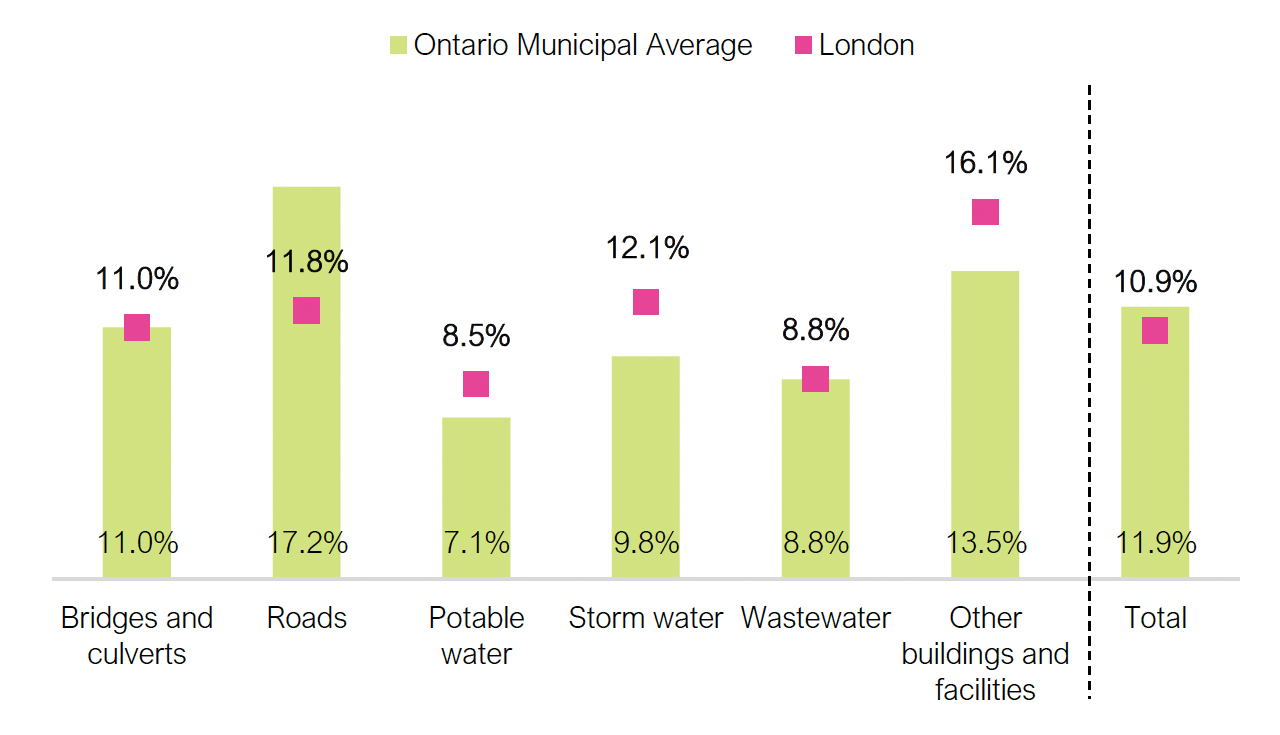
*Calculated as a share of the CRV of assets that have condition data.
Notes: The regional figures presented in these tables only encompass assets that have geolocations. Some results for the transit sector are excluded. The estimates presented under the state of repair and infrastructure backlog are the average values from the FAO’s Monte Carlo analysis.
Sources: Statistics Canada and FAO analysis of municipal data as detailed in Appendix D.
Accessible version
| Economic Region | Sector | Current Replacement Value of Assets ($ Billions) |
Infrastructure Backlog ($ Billions) |
Share of Assets in a State of Good Repair with Known Condition (Per Cent) |
Infrastructure Backlog as a Share of CRV with Known Condition (Per Cent) |
|---|---|---|---|---|---|
| London | Bridges and culverts | 3.1 | 0.3 | 48.1 | 11.0 |
| London | Roads | 10.0 | 1.2 | 55.9 | 11.8 |
| London | Potable water | 6.3 | 0.5 | 67.5 | 8.5 |
| London | Storm water | 9.2 | 0.8 | 62.6 | 12.1 |
| London | Wastewater | 9.0 | 0.8 | 67.1 | 8.8 |
| London | Other buildings and facilities | 3.2 | 0.5 | 28.7 | 16.1 |
| London | Total | 40.9 | 4.2 | 58.8 | 10.9 |
Profile of Municipal Infrastructure: Muskoka-Kawarthas
Key Facts
| Current Replacement Value (CRV, billions) | $14.1 |
|---|---|
| CRV share of municipal assets in Ontario | 2.9% |
| Municipal infrastructure backlog (billions) | $2.1 |
| Share of municipal Infrastructure backlog in Ontario | 3.9% |
| Population | 404,158 |
| Population share of Ontario | 2.8% |
| Land area (square km) | 16,854 |
| Land area share of Ontario | 1.9% |
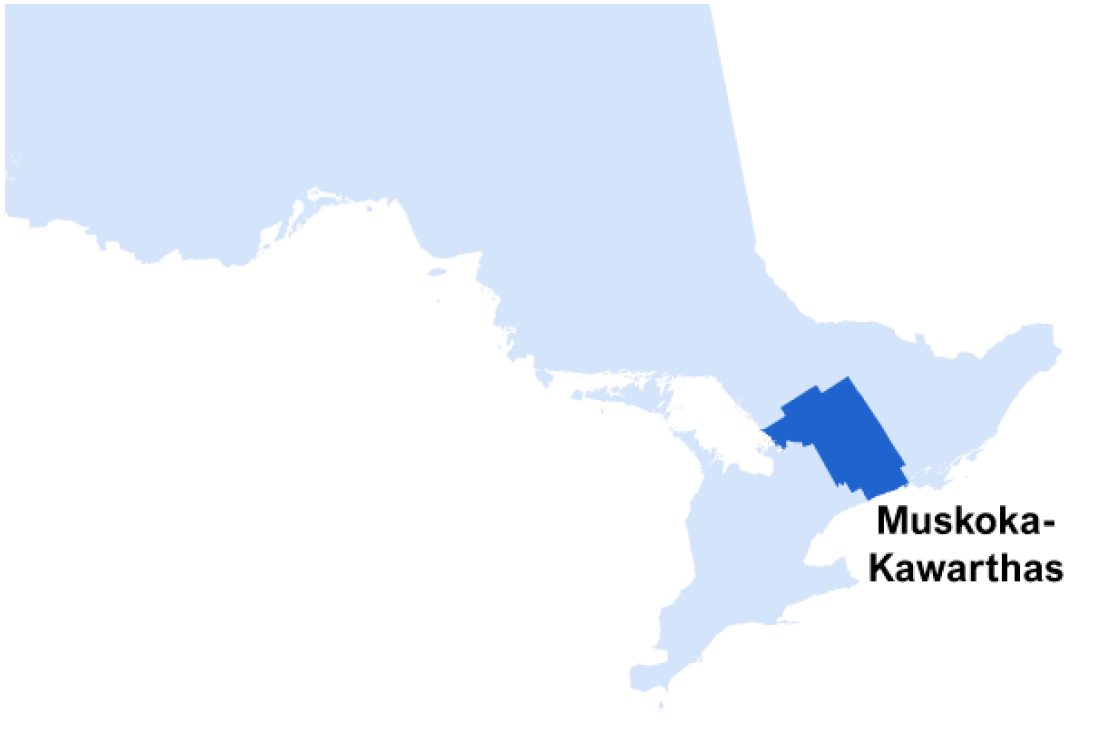
$14.1 billion Current Replacement Value of Assets
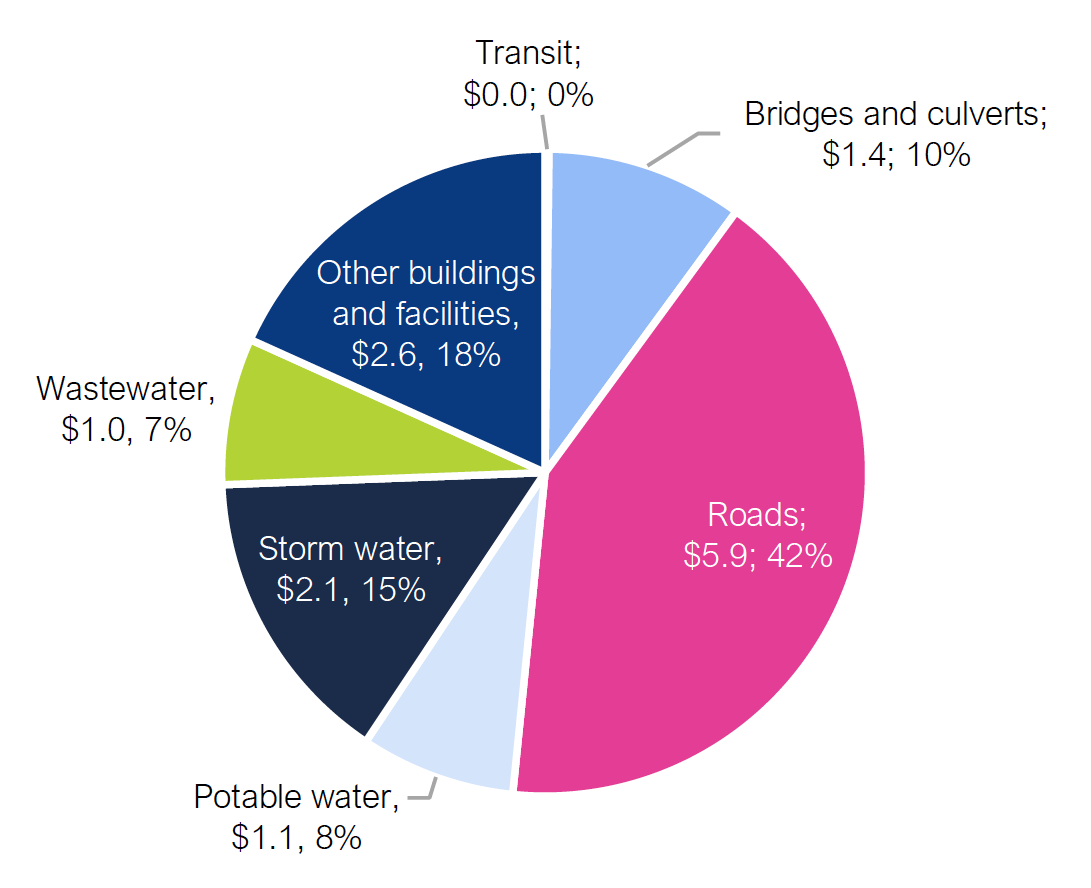
Share of Assets in a State of Good Repair*
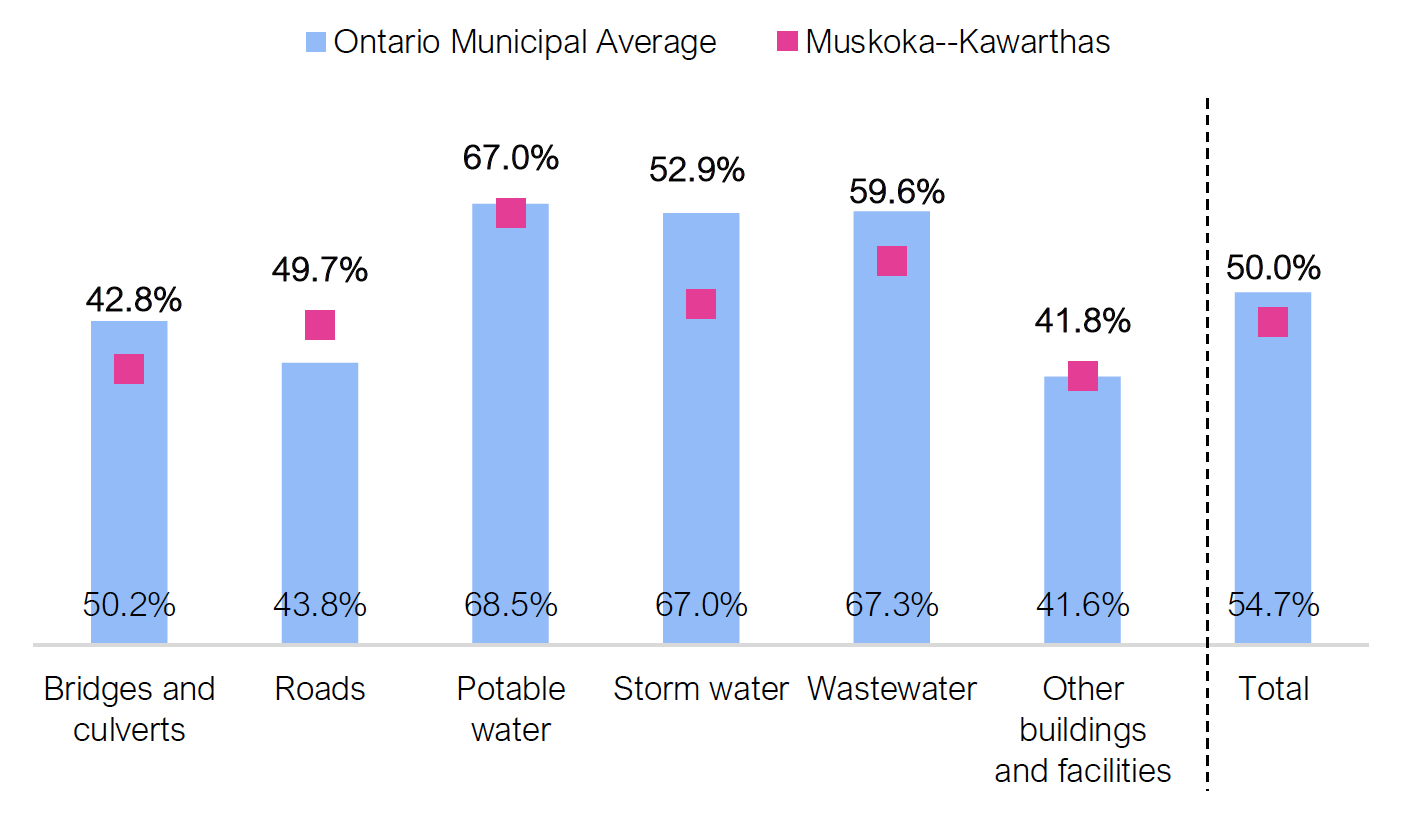
$2.1 billion Infrastructure Backlog
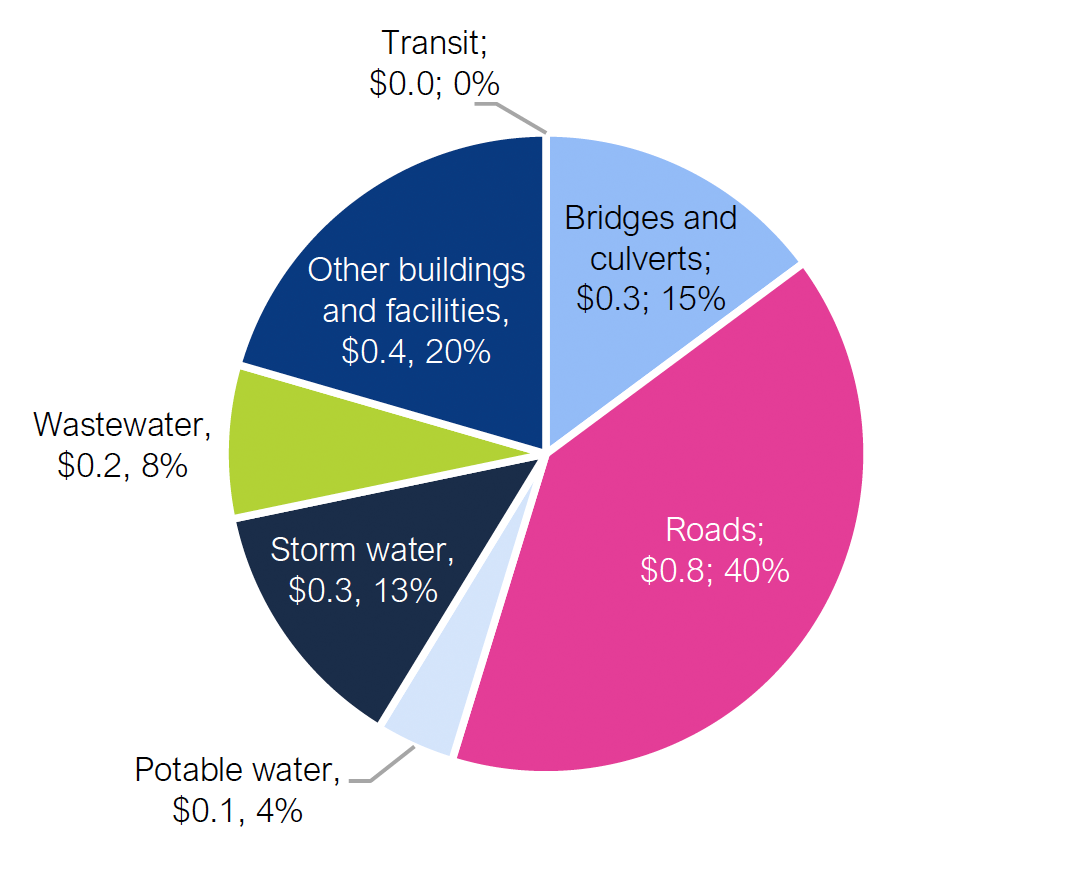
Infrastructure Backlog as a Share of CRV*
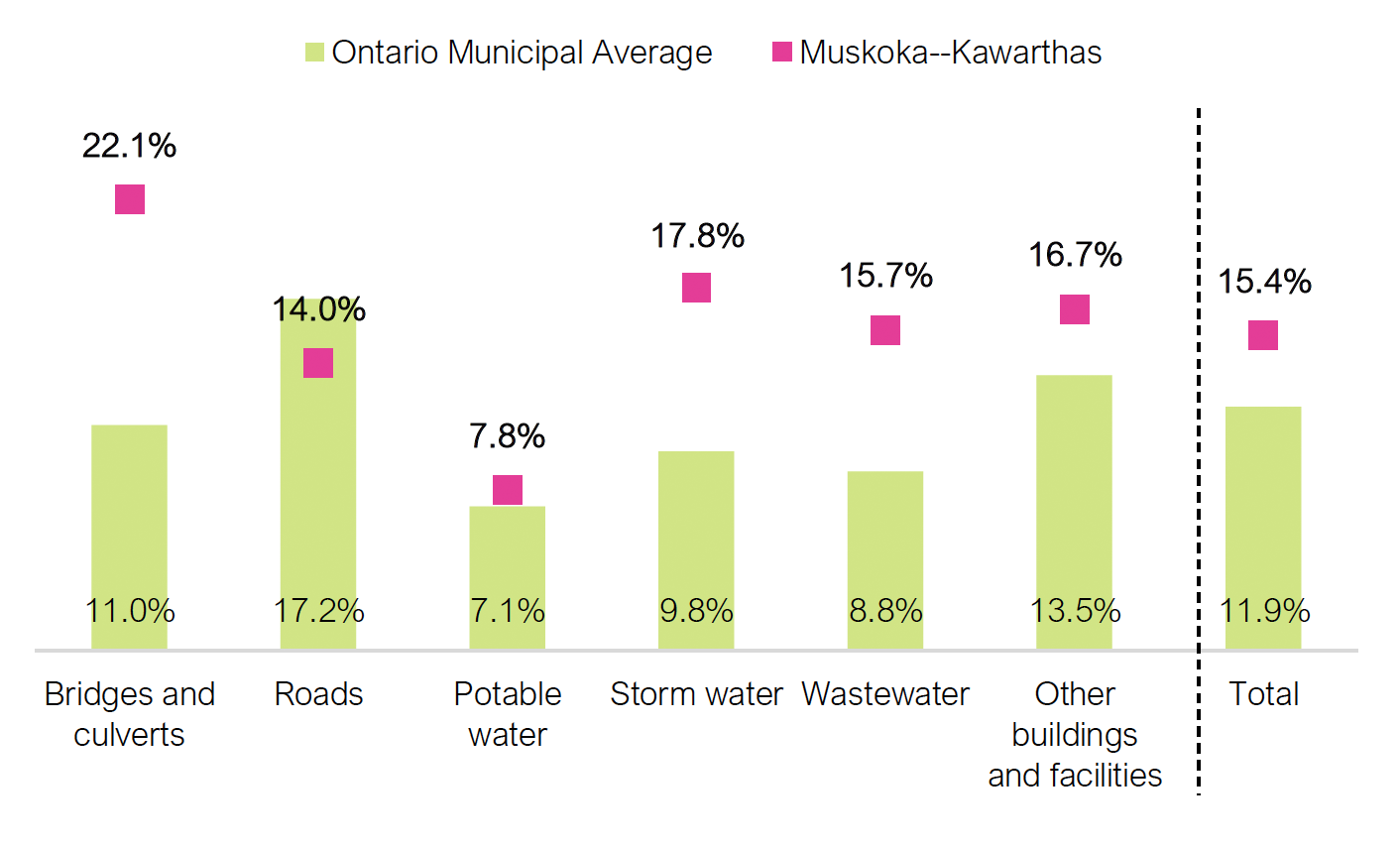
*Calculated as a share of the CRV of assets that have condition data.
Notes: The regional figures presented in these tables only encompass assets that have geolocations. Some results for the transit sector are excluded. The estimates presented under the state of repair and infrastructure backlog are the average values from the FAO’s Monte Carlo analysis.
Sources: Statistics Canada and FAO analysis of municipal data as detailed in Appendix D.
Accessible version
| Economic Region | Sector | Current Replacement Value of Assets ($ Billions) |
Infrastructure Backlog ($ Billions) |
Share of Assets in a State of Good Repair with Known Condition (Per Cent) |
Infrastructure Backlog as a Share of CRV with Known Condition (Per Cent) |
|---|---|---|---|---|---|
| Muskoka–Kawarthas | Bridges and culverts | 1.4 | 0.3 | 42.8 | 22.1 |
| Muskoka–Kawarthas | Roads | 5.9 | 0.8 | 49.7 | 14.0 |
| Muskoka–Kawarthas | Potable water | 1.1 | 0.1 | 67.0 | 7.8 |
| Muskoka–Kawarthas | Storm water | 2.1 | 0.3 | 52.9 | 17.8 |
| Muskoka–Kawarthas | Wastewater | 1.0 | 0.2 | 59.6 | 15.7 |
| Muskoka–Kawarthas | Other buildings and facilities | 2.6 | 0.4 | 41.8 | 16.7 |
| Muskoka–Kawarthas | Total | 14.1 | 2.1 | 50.0 | 15.4 |
Profile of Municipal Infrastructure: Northeast
Key Facts
| Current Replacement Value (CRV, billions) | $14.6 |
|---|---|
| CRV share of municipal assets in Ontario | 3.0% |
| Municipal infrastructure backlog (billions) | $2.1 |
| Share of municipal Infrastructure backlog in Ontario | 4.0% |
| Population | 568,361 |
| Population share of Ontario | 3.9% |
| Land area (square km) | 276,368 |
| Land area share of Ontario | 30.4% |
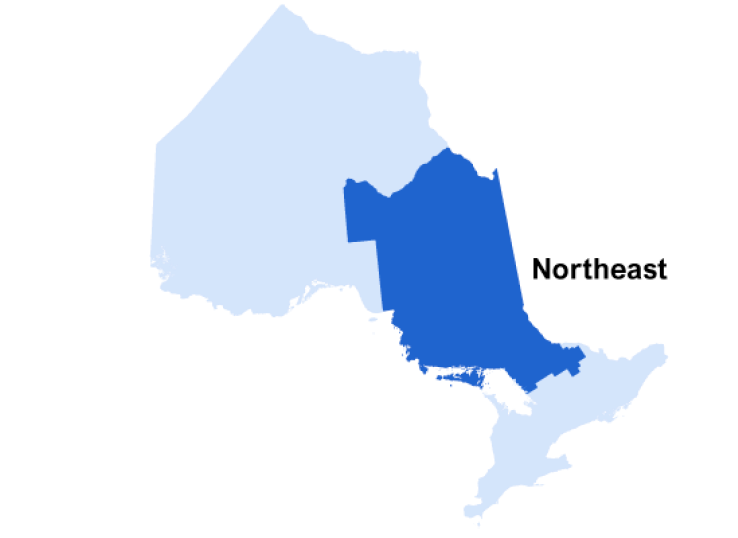
$14.6 billion Current Replacement Value of Assets
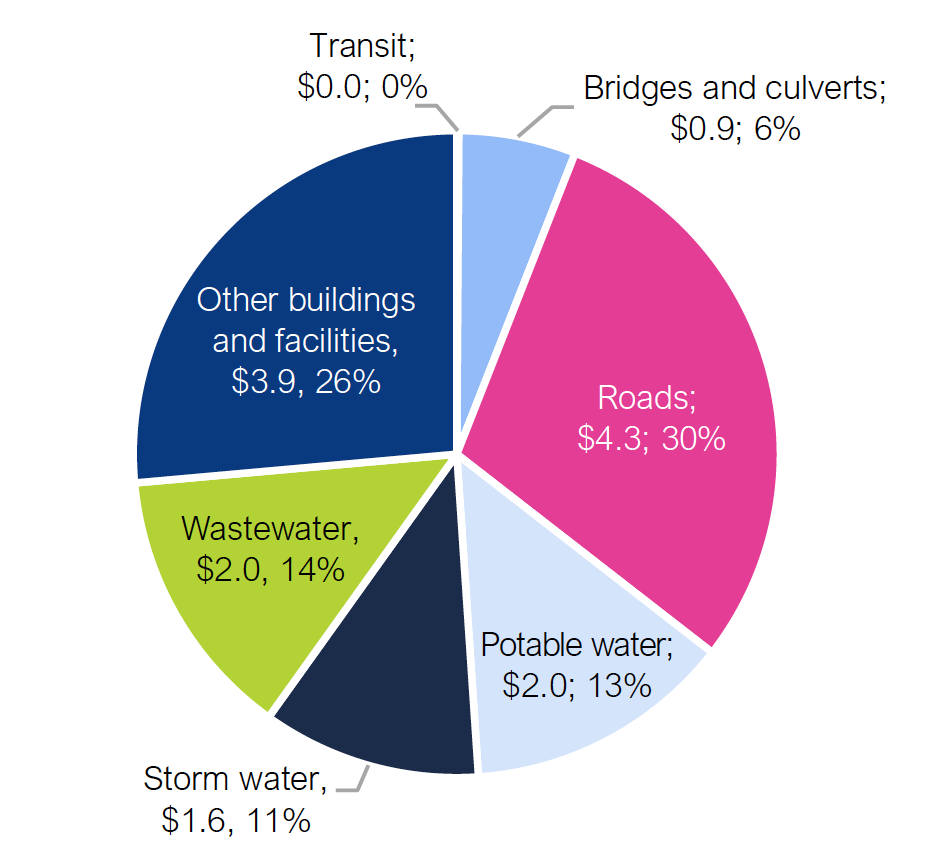
Share of Assets in a State of Good Repair*
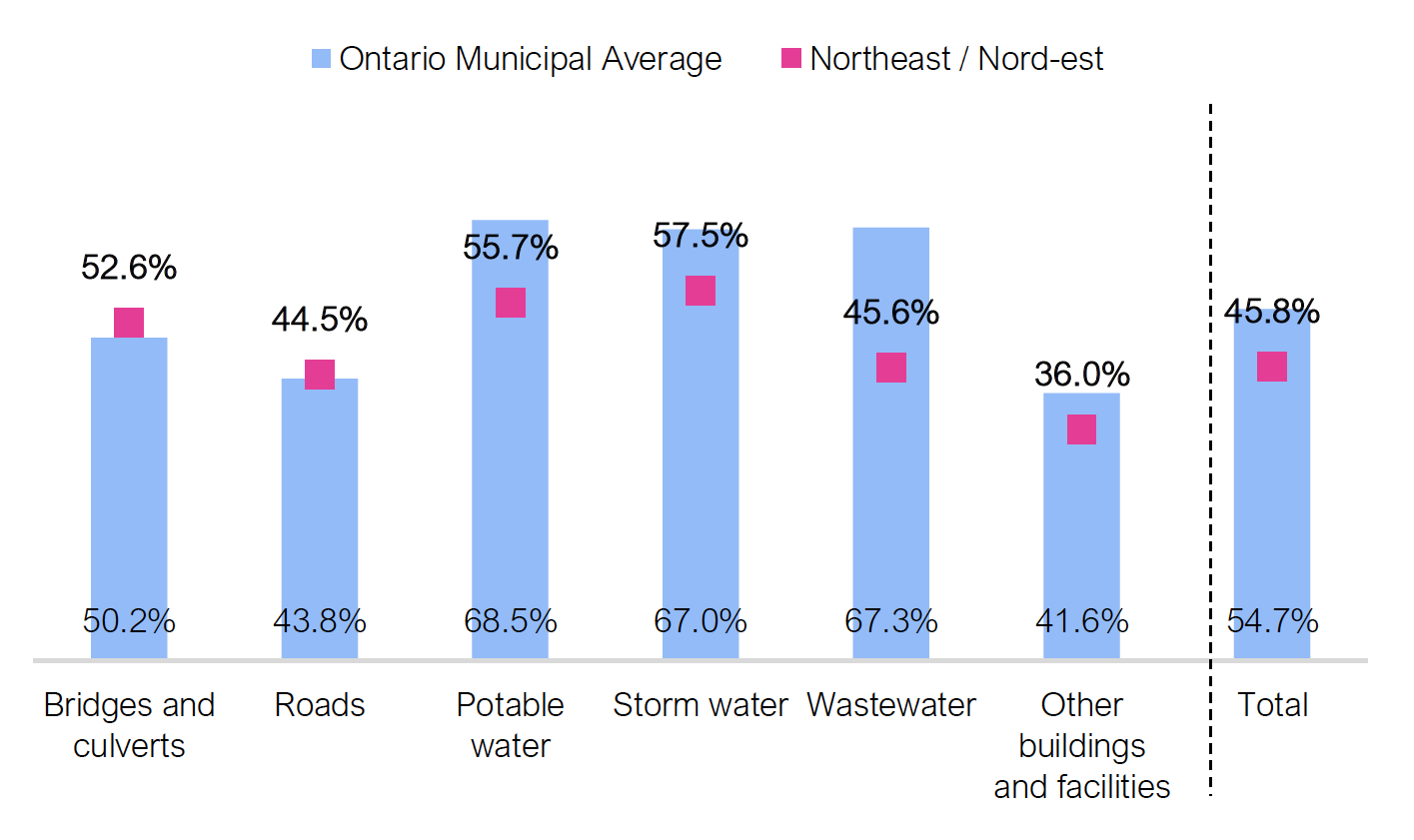
$2.1 billion Infrastructure Backlog
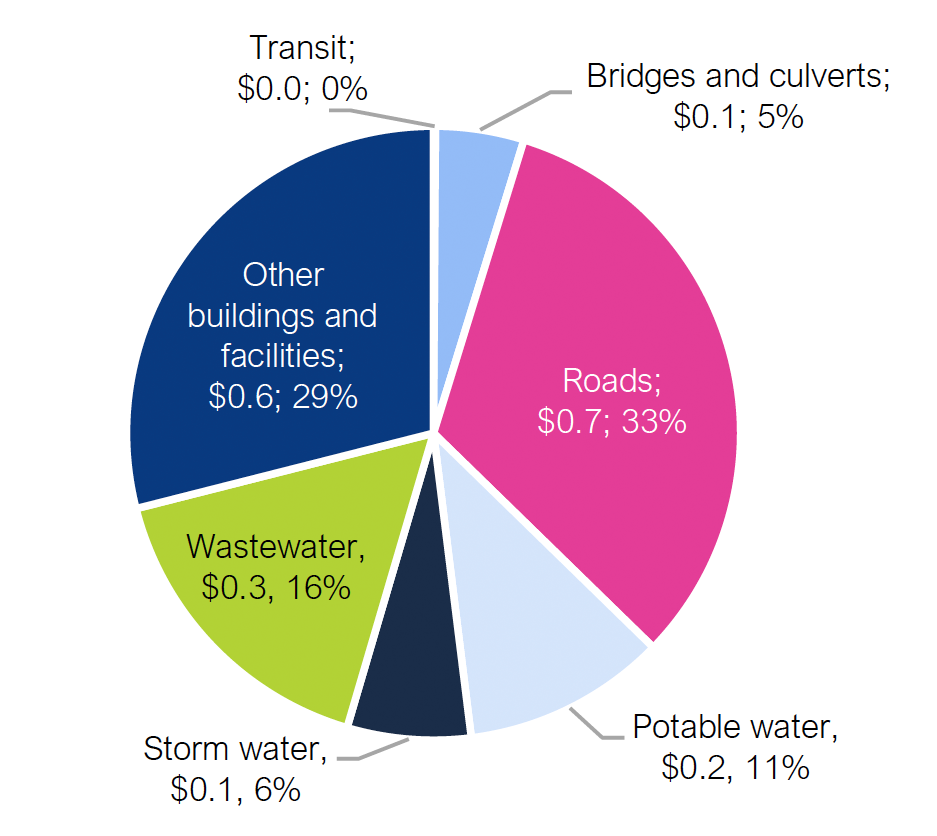
Infrastructure Backlog as a Share of CRV*
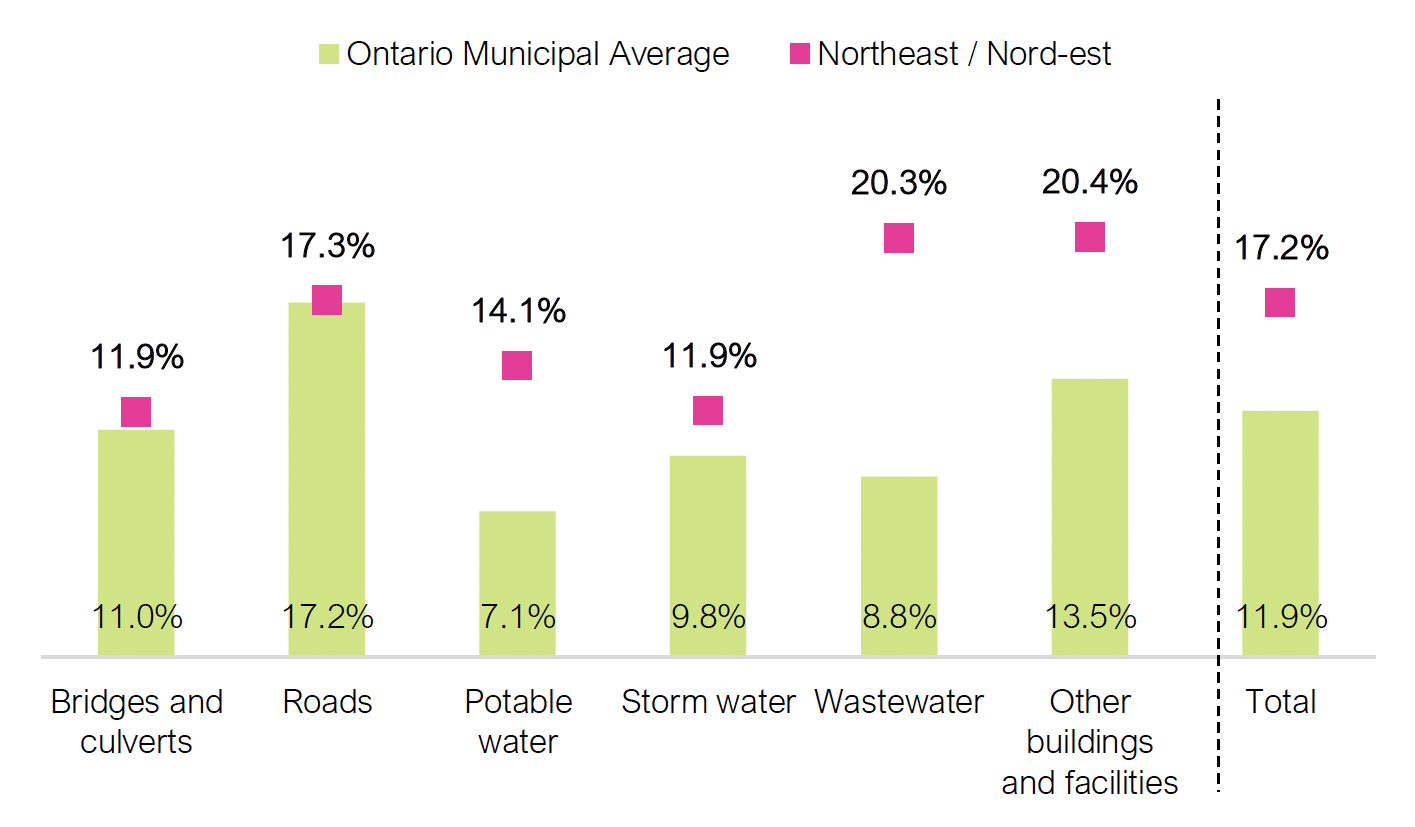
*Calculated as a share of the CRV of assets that have condition data.
Notes: The regional figures presented in these tables only encompass assets that have geolocations. Results of this economic region are subject to a higher degree of uncertainty. Some results for the transit sector are excluded. The estimates presented under the state of repair and infrastructure backlog are the average values from the FAO’s Monte Carlo analysis.
Sources: Statistics Canada and FAO analysis of municipal data as detailed in Appendix D.
Accessible version
| Economic Region | Sector | Current Replacement Value of Assets ($ Billions) |
Infrastructure Backlog ($ Billions) |
Share of Assets in a State of Good Repair with Known Condition (Per Cent) |
Infrastructure Backlog as a Share of CRV with Known Condition (Per Cent) |
|---|---|---|---|---|---|
| Northeast | Bridges and culverts | 0.9 | 0.1 | 52.6 | 11.9 |
| Northeast | Roads | 4.3 | 0.7 | 44.5 | 17.3 |
| Northeast | Potable water | 2.0 | 0.2 | 55.7 | 14.1 |
| Northeast | Storm water | 1.6 | 0.1 | 57.5 | 11.9 |
| Northeast | Wastewater | 2.0 | 0.3 | 45.6 | 20.3 |
| Northeast | Other buildings and facilities | 3.9 | 0.6 | 36.0 | 20.4 |
| Northeast | Total | 14.6 | 2.1 | 45.8 | 17.2 |
Profile of Municipal Infrastructure: Northwest
Key Facts
| Current Replacement Value (CRV, billions) | $6.3 |
|---|---|
| CRV share of municipal assets in Ontario | 1.3% |
| Municipal infrastructure backlog (billions) | $0.8 |
| Share of municipal Infrastructure backlog in Ontario | 1.5% |
| Population | 243,044 |
| Population share of Ontario | 1.7% |
| Land area (square km) | 526,478 |
| Land area share of Ontario | 57.9% |
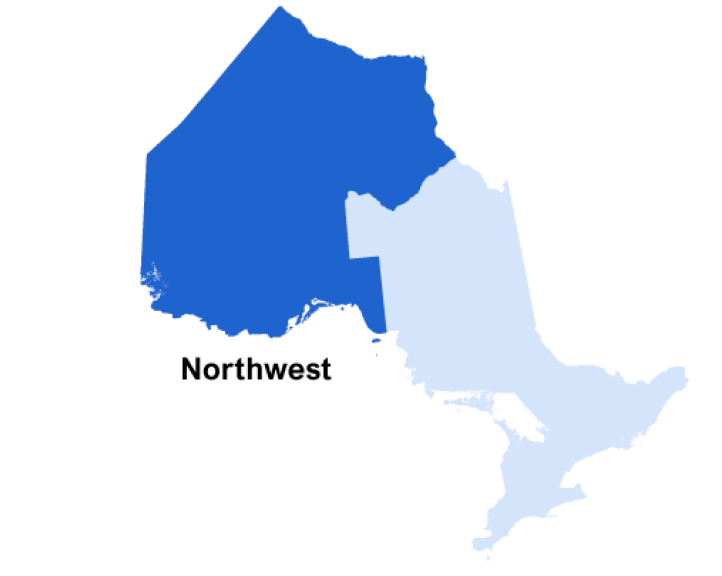
$6.3 billion Current Replacement Value of Assets
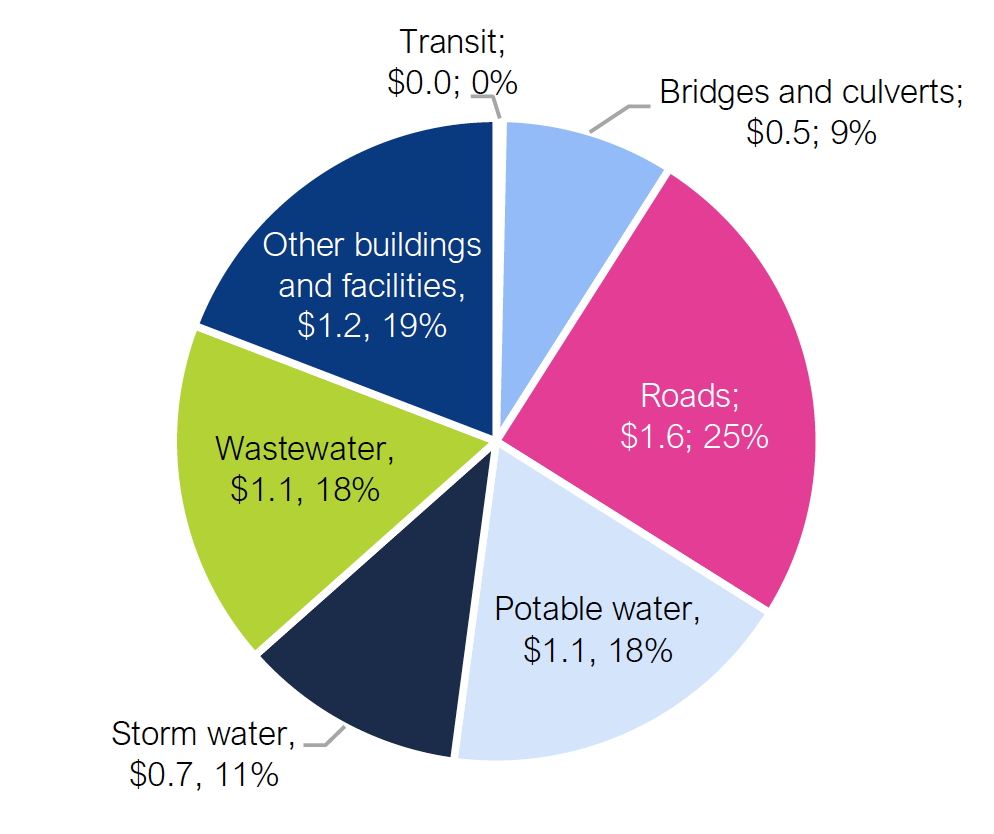
Share of Assets in a State of Good Repair*

$0.8 billion Infrastructure Backlog
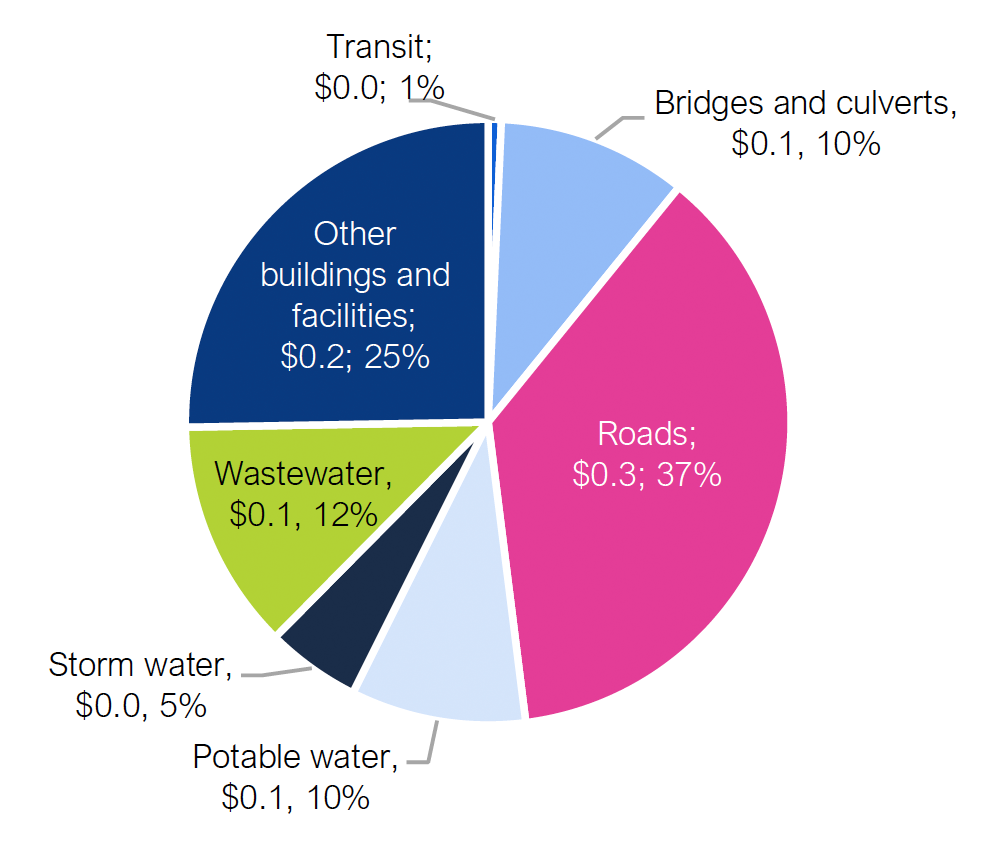
Infrastructure Backlog as a Share of CRV*
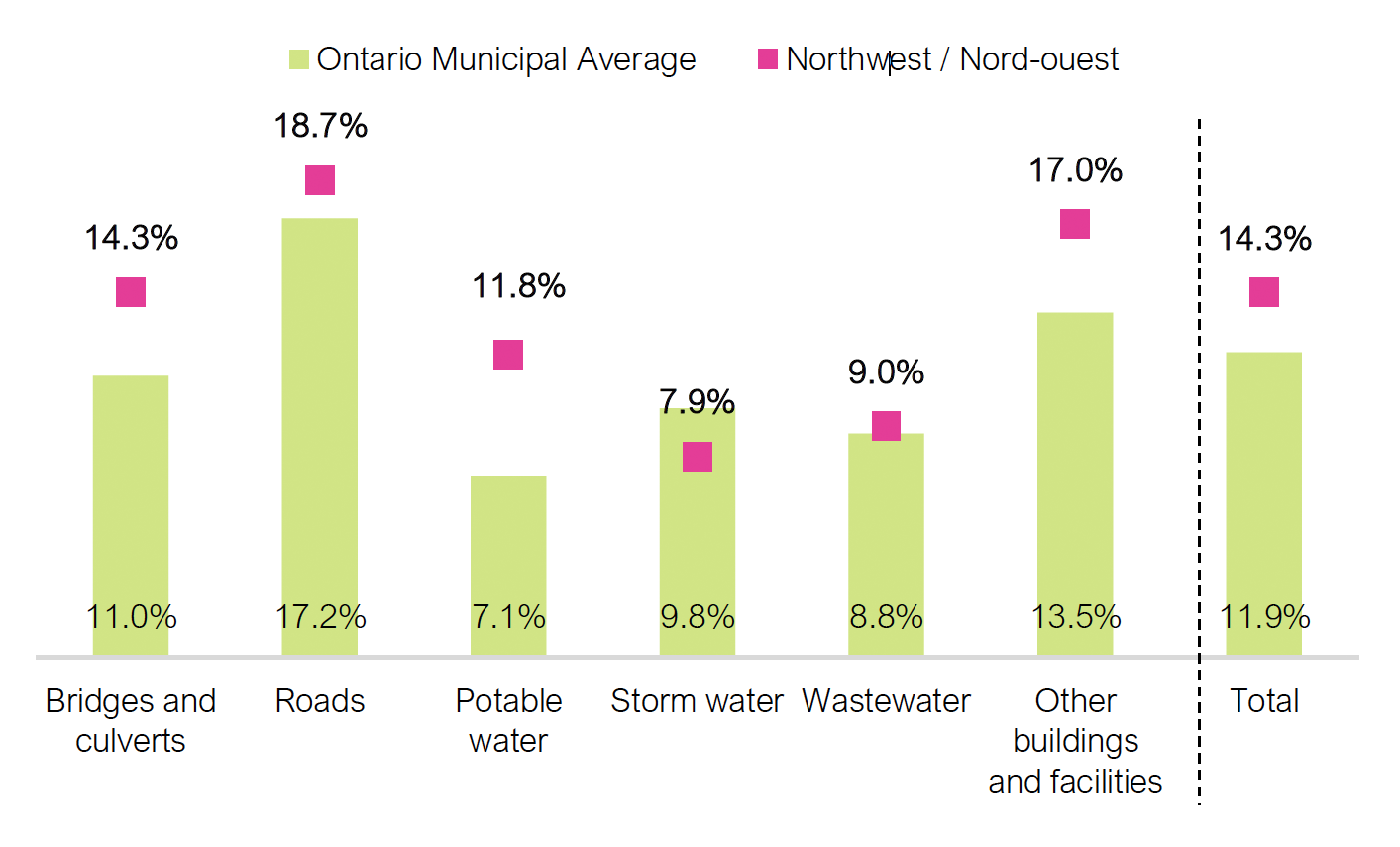
*Calculated as a share of the CRV of assets that have condition data.
Notes: The regional figures presented in these tables only encompass assets that have geolocations. Results of this economic region are subject to a higher degree of uncertainty. Some results for the transit sector are excluded. The estimates presented under the state of repair and infrastructure backlog are the average values from the FAO’s Monte Carlo analysis.
Sources: Statistics Canada and FAO analysis of municipal data as detailed in Appendix D.
Accessible version
| Economic Region | Sector | Current Replacement Value of Assets ($ Billions) |
Infrastructure Backlog ($ Billions) |
Share of Assets in a State of Good Repair with Known Condition (Per Cent) |
Infrastructure Backlog as a Share of CRV with Known Condition (Per Cent) |
|---|---|---|---|---|---|
| Northwest | Bridges and culverts | 0.5 | 0.1 | 50.2 | 14.3 |
| Northwest | Roads | 1.6 | 0.3 | 40.5 | 18.7 |
| Northwest | Potable water | 1.1 | 0.1 | 61.9 | 11.8 |
| Northwest | Storm water | 0.7 | 0.0 | 71.3 | 7.9 |
| Northwest | Wastewater | 1.1 | 0.1 | 71.9 | 9.0 |
| Northwest | Other buildings and facilities | 1.2 | 0.2 | 34.2 | 17.0 |
| Northwest | Total | 6.3 | 0.8 | 51.4 | 14.3 |
Profile of Municipal Infrastructure: Ottawa
Key Facts
| Current Replacement Value (CRV, billions) | $44.3 |
|---|---|
| CRV share of municipal assets in Ontario | 9.2% |
| Municipal infrastructure backlog (billions) | $4.9 |
| Share of municipal Infrastructure backlog in Ontario | 9.5% |
| Population | 1,419,183 |
| Population share of Ontario | 9.7% |
| Land area (square km) | 14,523 |
| Land area share of Ontario | 1.6% |
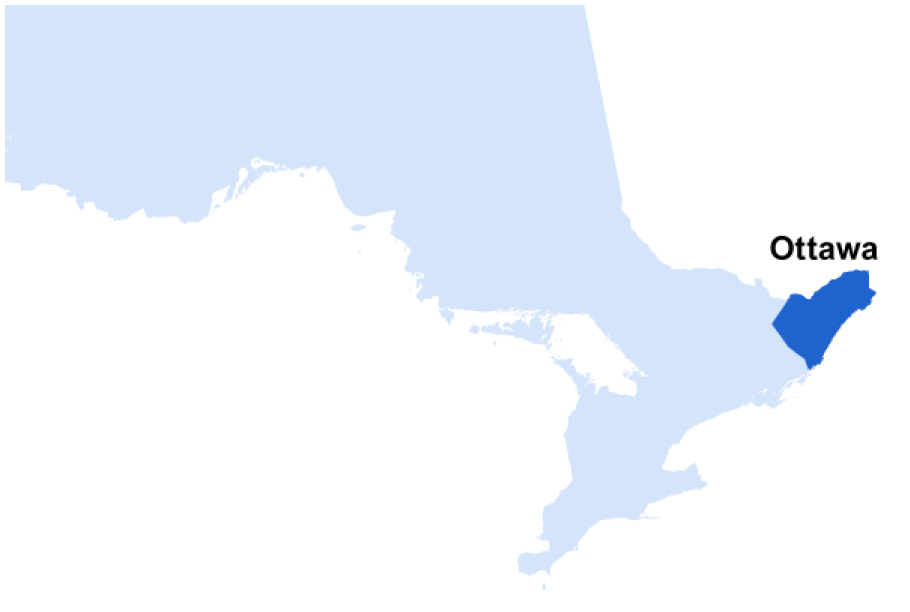
$44.3 billion Current Replacement Value of Assets
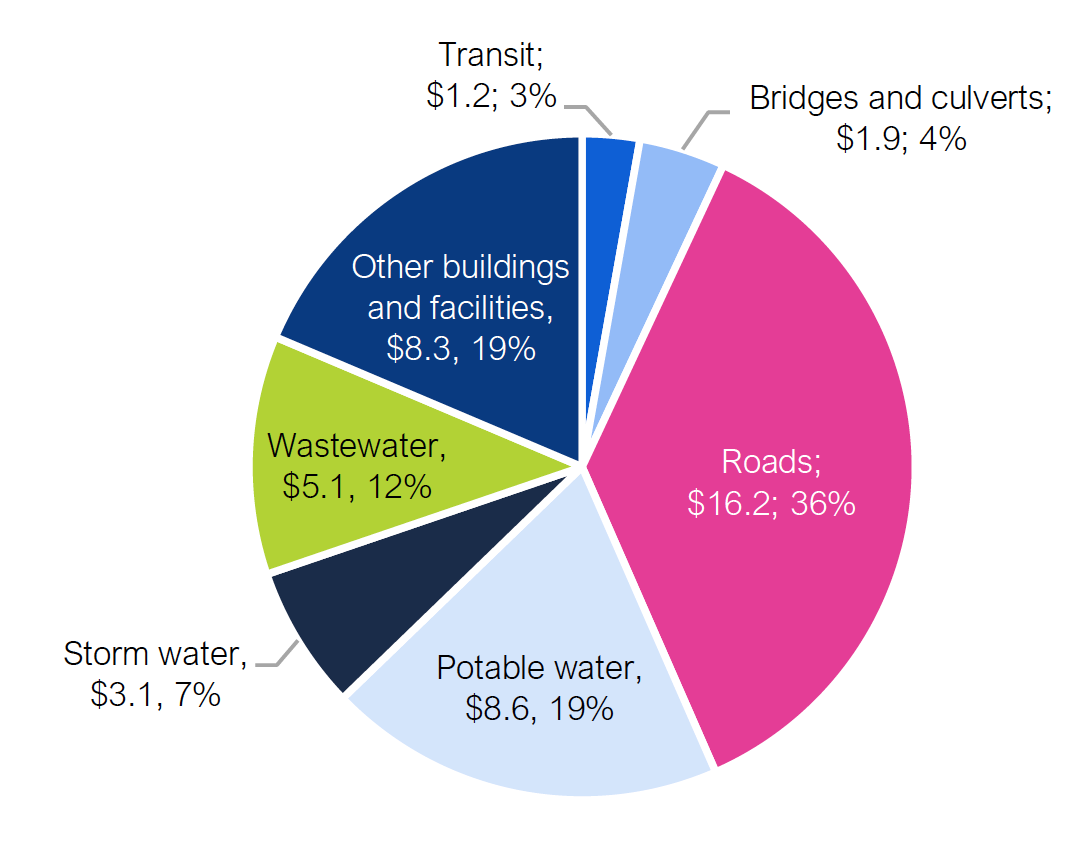
Share of Assets in a State of Good Repair*

$4.9 billion Infrastructure Backlog
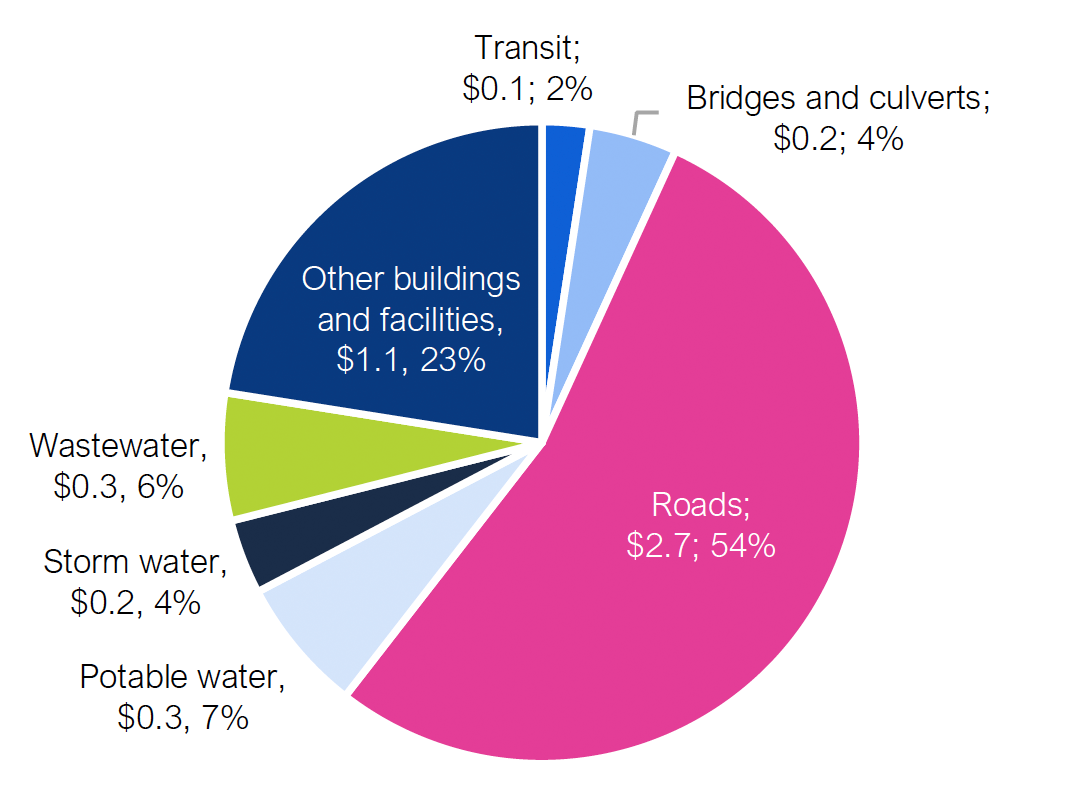
Infrastructure Backlog as a Share of CRV*
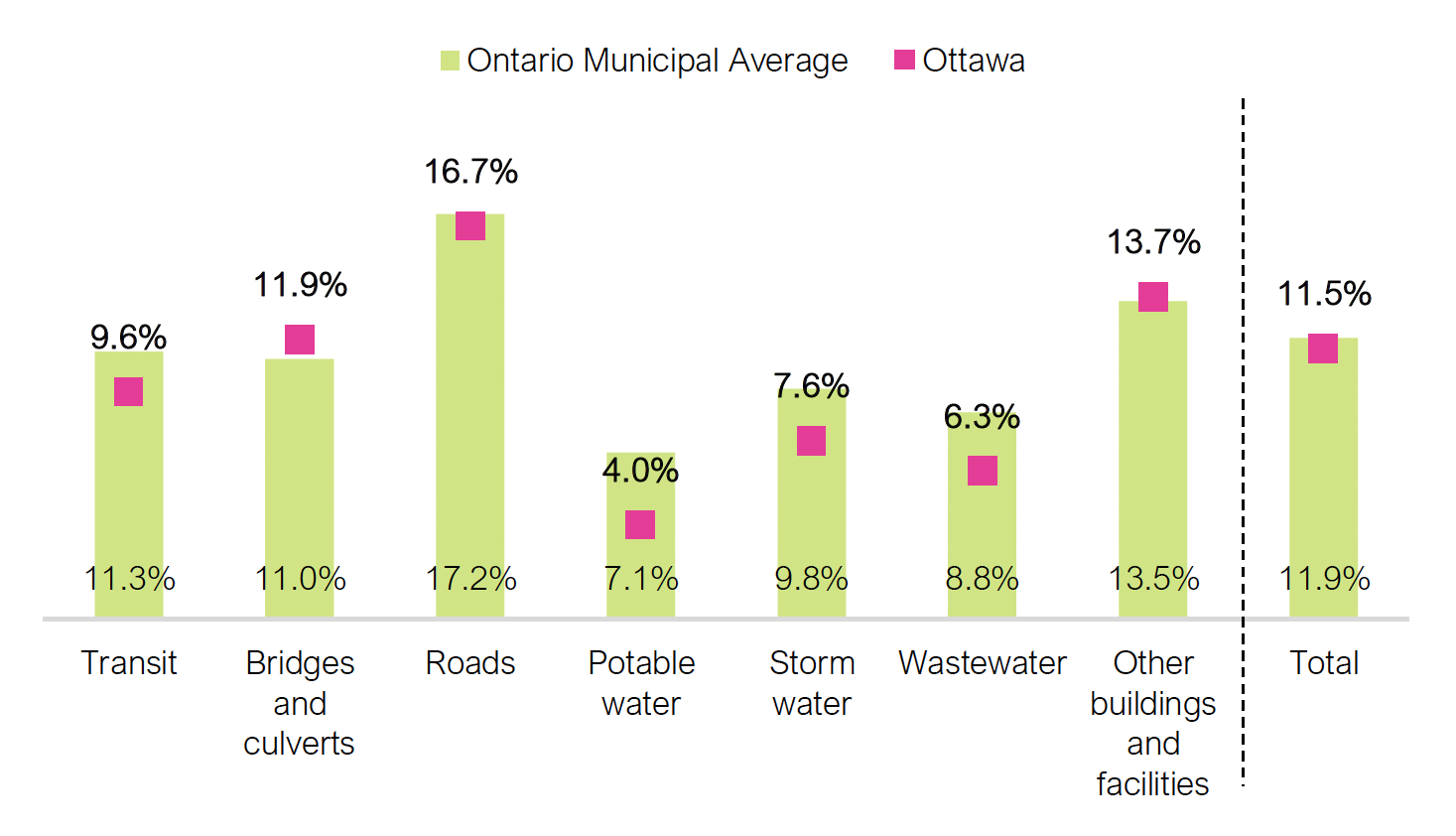
*Calculated as a share of the CRV of assets that have condition data.
Notes: The regional figures presented in these tables only encompass assets that have geolocations. The estimates presented under the state of repair and infrastructure backlog are the average values from the FAO’s Monte Carlo analysis.
Sources: Statistics Canada and FAO analysis of municipal data as detailed in Appendix D.
Accessible version
| Economic Region | Sector | Current Replacement Value of Assets ($ Billions) |
Infrastructure Backlog ($ Billions) |
Share of Assets in a State of Good Repair with Known Condition (Per Cent) |
Infrastructure Backlog as a Share of CRV with Known Condition (Per Cent) |
|---|---|---|---|---|---|
| Ottawa | Transit | 1.2 | 0.1 | 21.3 | 9.6 |
| Ottawa | Bridges and culverts | 1.9 | 0.2 | 32.1 | 11.9 |
| Ottawa | Roads | 16.2 | 2.7 | 27.4 | 16.7 |
| Ottawa | Potable water | 8.6 | 0.3 | 74.6 | 4.0 |
| Ottawa | Storm water | 3.1 | 0.2 | 71.5 | 7.6 |
| Ottawa | Wastewater | 5.1 | 0.3 | 40.6 | 6.3 |
| Ottawa | Other buildings and facilities | 8.3 | 1.1 | 16.5 | 13.7 |
| Ottawa | Total | 44.3 | 4.9 | 38.7 | 11.5 |
Profile of Municipal Infrastructure: Stratford-Bruce Peninsula
Key Facts
| Current Replacement Value (CRV, billions) | $16.8 |
|---|---|
| CRV share of municipal assets in Ontario | 3.5% |
| Municipal infrastructure backlog (billions) | $2.7 |
| Share of municipal Infrastructure backlog in Ontario | 5.2% |
| Population | 318,173 |
| Population share of Ontario | 2.2% |
| Land area (square km) | 14,221 |
| Land area share of Ontario | 1.6% |
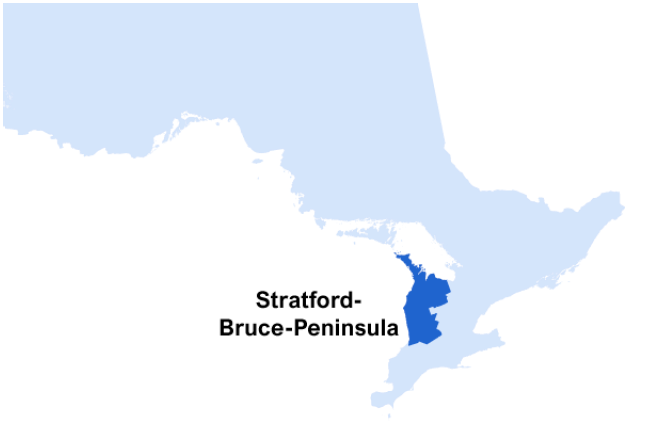
$16.8 billion Current Replacement Value of Assets

Share of Assets in a State of Good Repair*

$2.7 billion Infrastructure Backlog
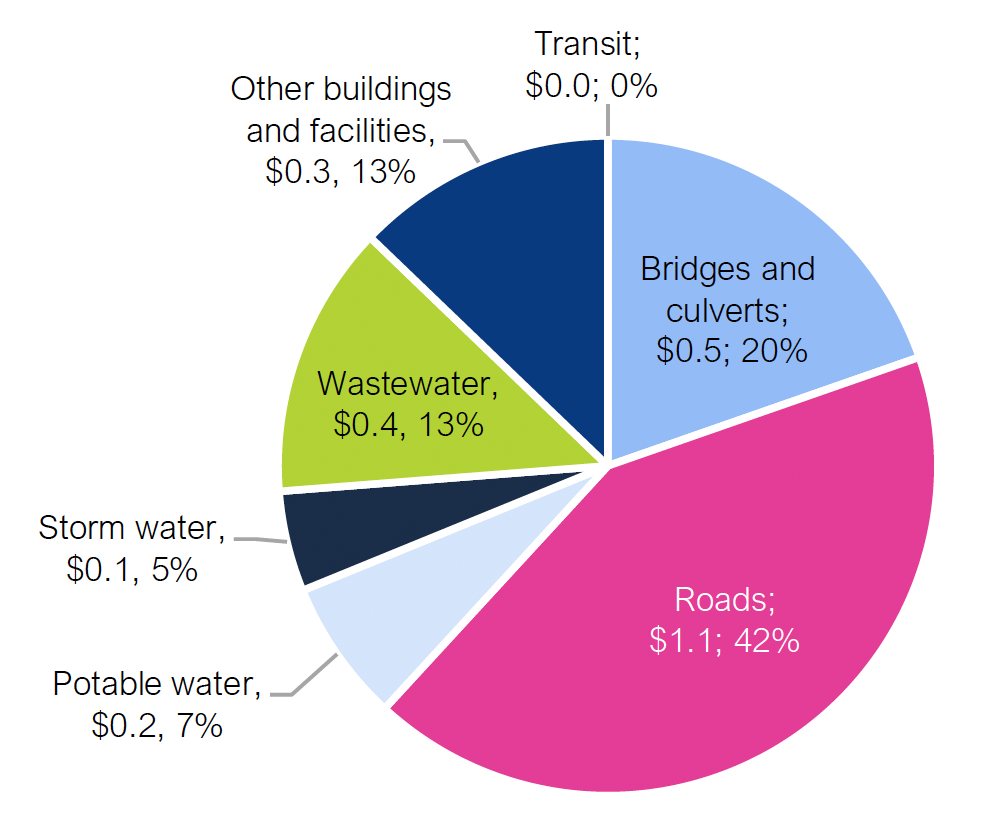
Infrastructure Backlog as a Share of CRV*

*Calculated as a share of the CRV of assets that have condition data.
Notes: The regional figures presented in these tables only encompass assets that have geolocations. Some results for the transit sector are excluded. The estimates presented under the state of repair and infrastructure backlog are the average values from the FAO’s Monte Carlo analysis.
Sources: Statistics Canada and FAO analysis of municipal data as detailed in Appendix D.
Accessible version
| Economic Region | Sector | Current Replacement Value of Assets ($ Billions) |
Infrastructure Backlog ($ Billions) |
Share of Assets in a State of Good Repair with Known Condition (Per Cent) |
Infrastructure Backlog as a Share of CRV with Known Condition (Per Cent) |
|---|---|---|---|---|---|
| Stratford–Bruce Peninsula | Bridges and culverts | 2.8 | 0.5 | 40.5 | 19.2 |
| Stratford–Bruce Peninsula | Roads | 7.0 | 1.1 | 46.8 | 17.9 |
| Stratford–Bruce Peninsula | Potable water | 1.4 | 0.2 | 51.8 | 15.0 |
| Stratford–Bruce Peninsula | Storm water | 2.0 | 0.1 | 62.6 | 10.1 |
| Stratford–Bruce Peninsula | Wastewater | 1.9 | 0.4 | 48.1 | 20.2 |
| Stratford–Bruce Peninsula | Other buildings and facilities | 1.7 | 0.3 | 24.8 | 22.0 |
| Stratford–Bruce Peninsula | Total | 16.8 | 2.7 | 45.3 | 17.9 |
Profile of Municipal Infrastructure: Toronto
Key Facts
| Current Replacement Value (CRV, billions) | $183.4 |
|---|---|
| CRV share of municipal assets in Ontario | 37.9% |
| Municipal infrastructure backlog (billions) | $15.4 |
| Share of municipal Infrastructure backlog in Ontario | 29.5% |
| Population | 6,783,480 |
| Population share of Ontario | 46.6% |
| Land area (square km) | 6,941 |
| Land area share of Ontario | 0.8% |

$183.4 billion Current Replacement Value of Assets
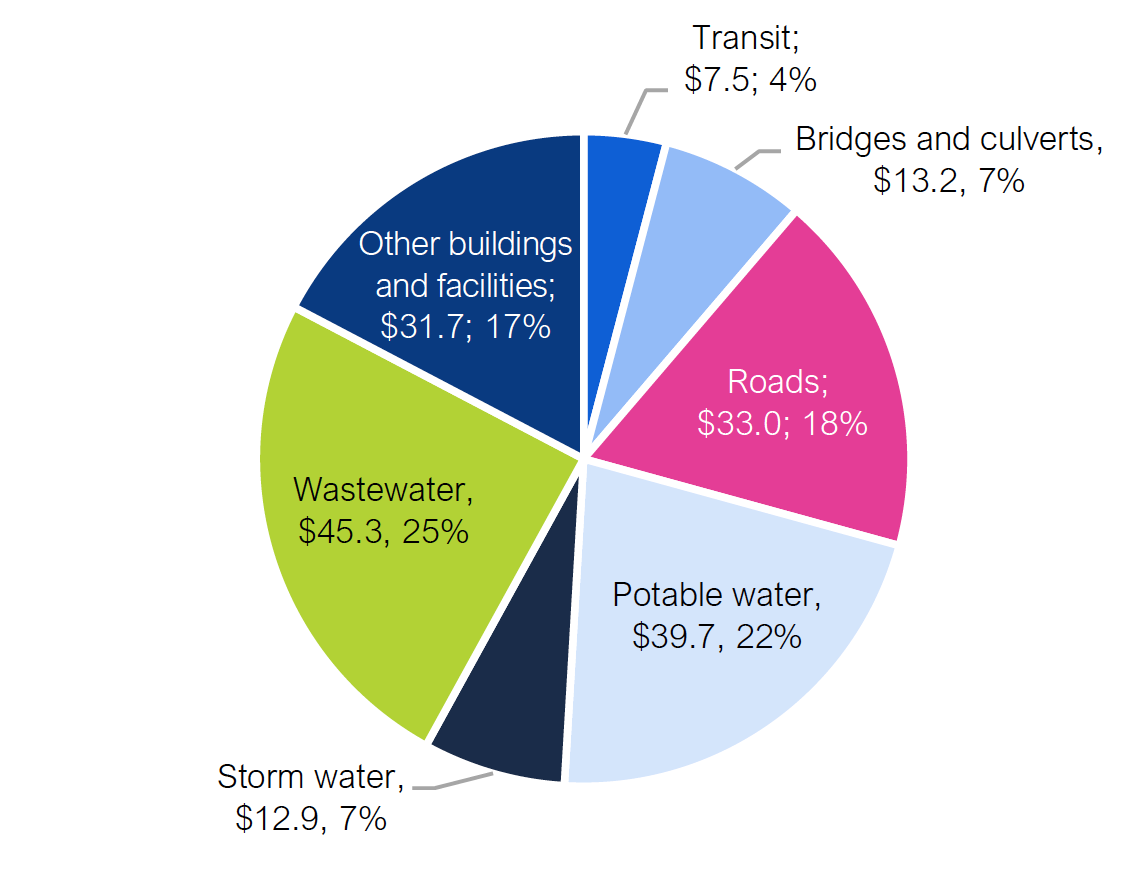
Share of Assets in a State of Good Repair*

$15.4 billion Infrastructure Backlog
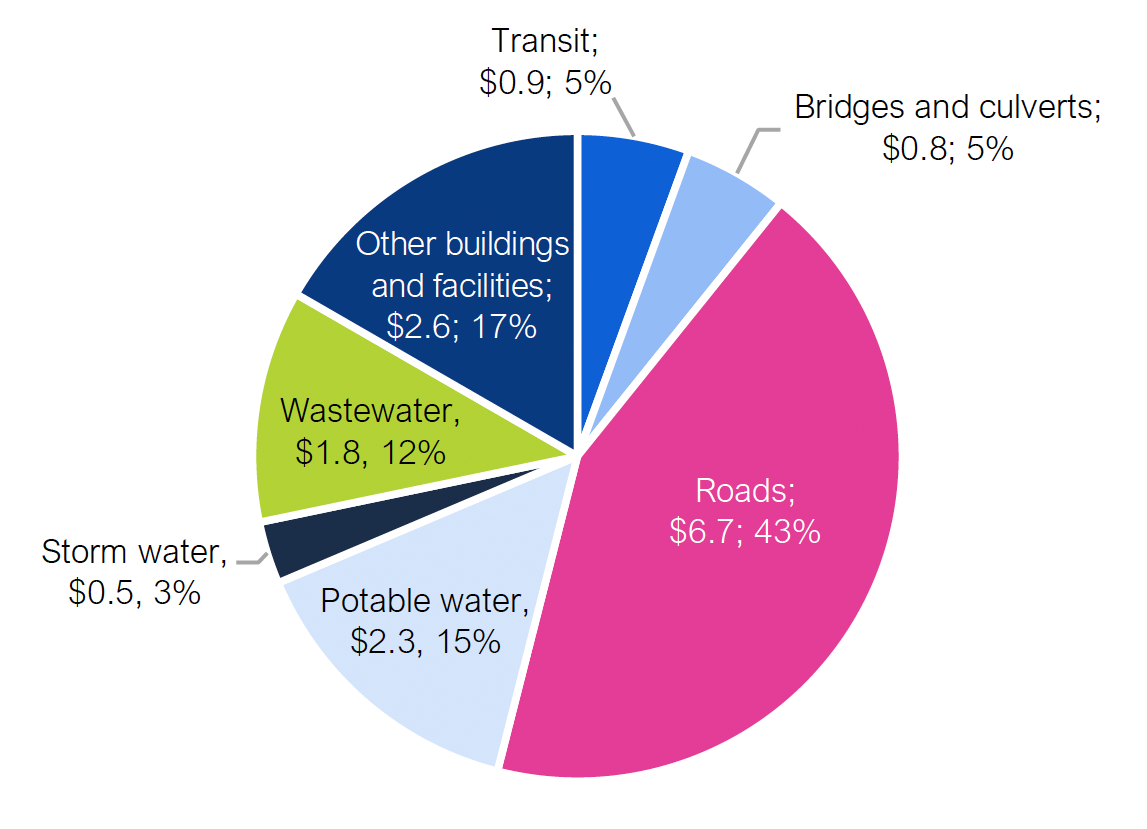
Infrastructure Backlog as a Share of CRV*
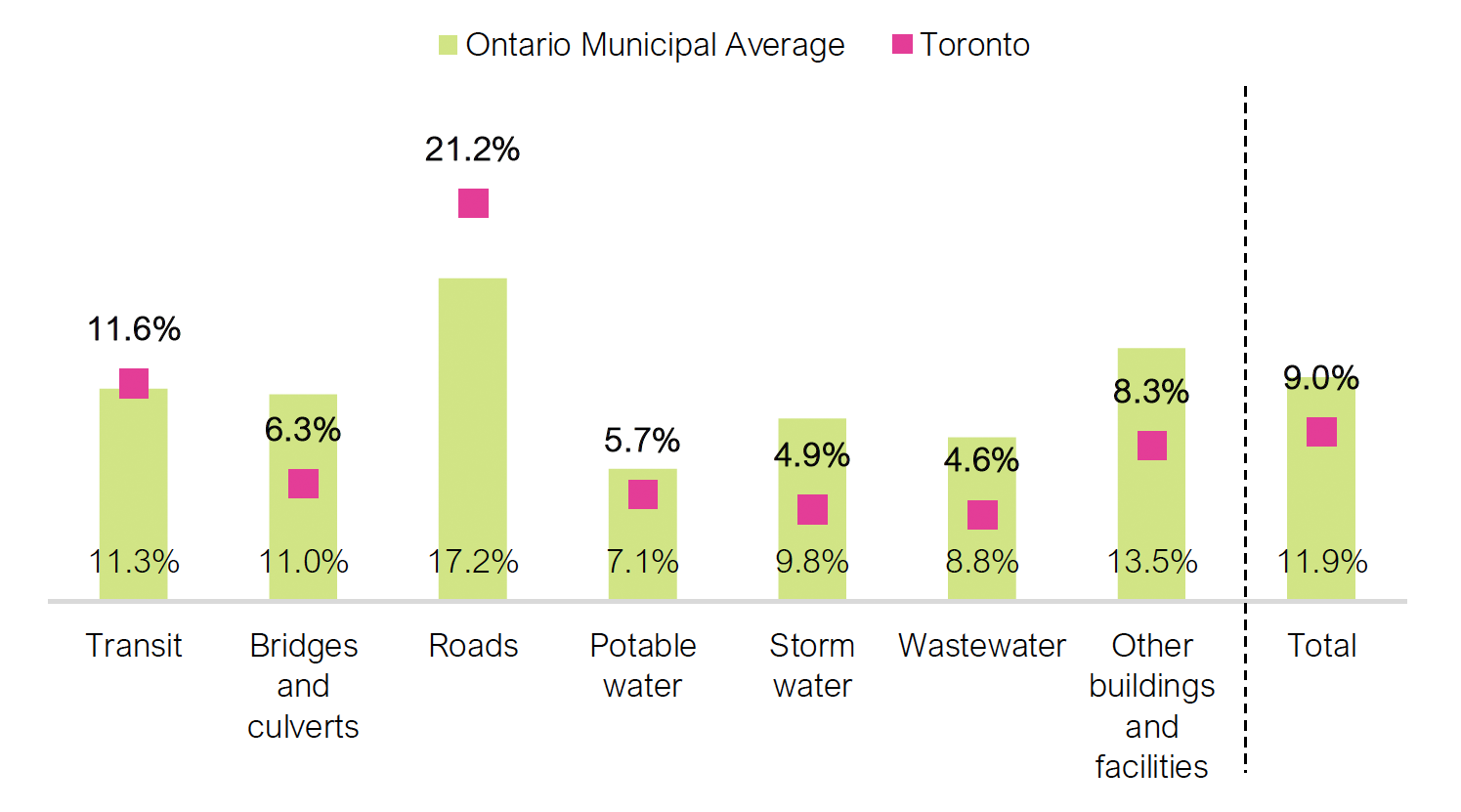
*Calculated as a share of the CRV of assets that have condition data.
Notes: The regional figures presented in these tables only encompass assets that have geolocations. The estimates presented under the state of repair and infrastructure backlog are the average values from the FAO’s Monte Carlo analysis.
Sources: Statistics Canada and FAO analysis of municipal data as detailed in Appendix D.
Accessible version
| Economic Region | Sector | Current Replacement Value of Assets ($ Billions) |
Infrastructure Backlog ($ Billions) |
Share of Assets in a State of Good Repair with Known Condition (Per Cent) |
Infrastructure Backlog as a Share of CRV with Known Condition (Per Cent) |
|---|---|---|---|---|---|
| Toronto | Transit | 7.5 | 0.9 | 45.5 | 11.6 |
| Toronto | Bridges and culverts | 13.2 | 0.8 | 56.7 | 6.3 |
| Toronto | Roads | 33.0 | 6.7 | 40.1 | 21.2 |
| Toronto | Potable water | 39.7 | 2.3 | 70.2 | 5.7 |
| Toronto | Storm water | 12.9 | 0.5 | 75.0 | 4.9 |
| Toronto | Wastewater | 45.3 | 1.8 | 79.4 | 4.6 |
| Toronto | Other buildings and facilities | 31.7 | 2.6 | 55.9 | 8.3 |
| Toronto | Total | 183.4 | 15.4 | 62.3 | 9.0 |
Profile of Municipal Infrastructure: Windsor-Sarnia
Key Facts
| Current Replacement Value (CRV, billions) | $29.7 |
|---|---|
| CRV share of municipal assets in Ontario | 6.1% |
| Municipal infrastructure backlog (billions) | $3.8 |
| Share of municipal Infrastructure backlog in Ontario | 7.3% |
| Population | 666,890 |
| Population share of Ontario | 4.6% |
| Land area (square km) | 7,324 |
| Land area share of Ontario | 0.8% |

$29.7 billion Current Replacement Value of Assets
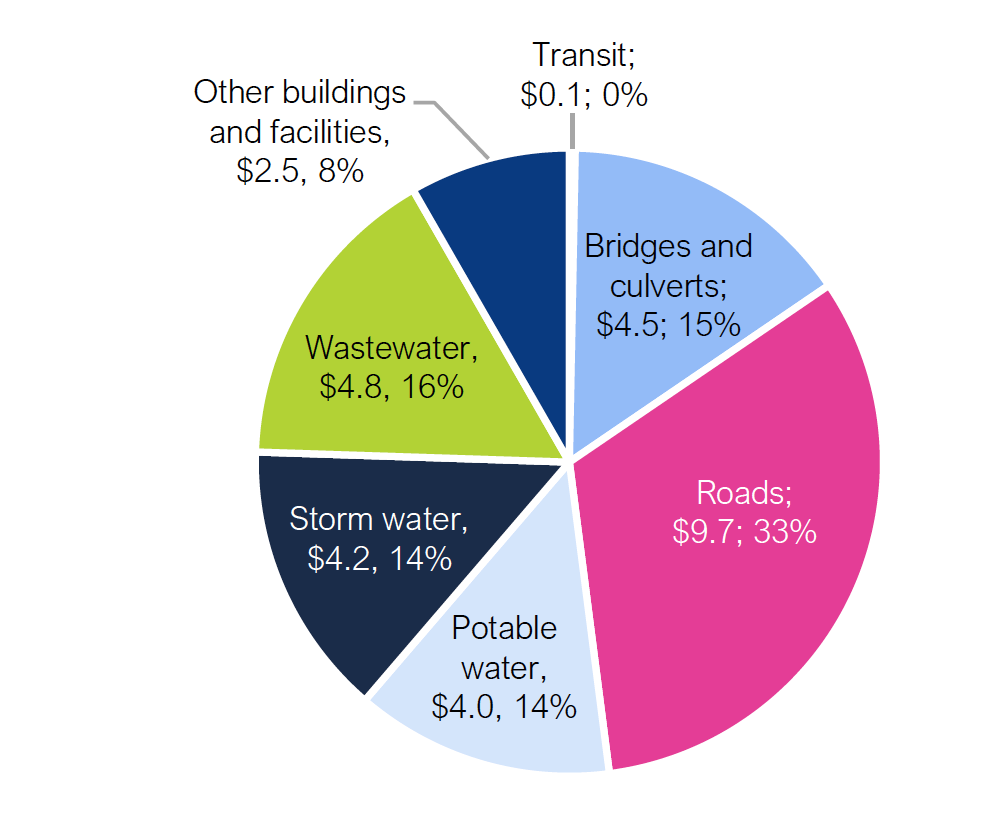
Share of Assets in a State of Good Repair*
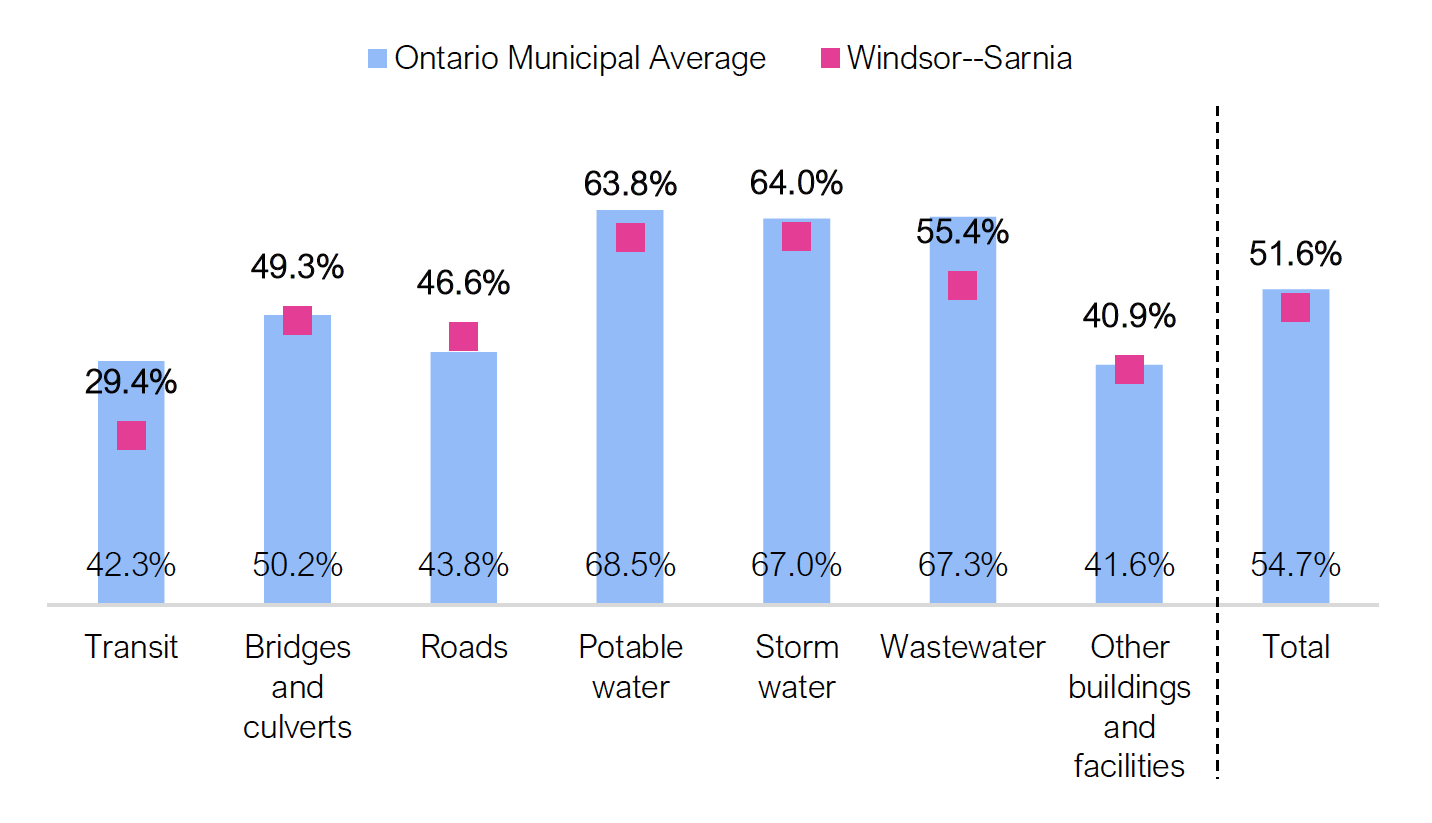
$3.8 billion Infrastructure Backlog
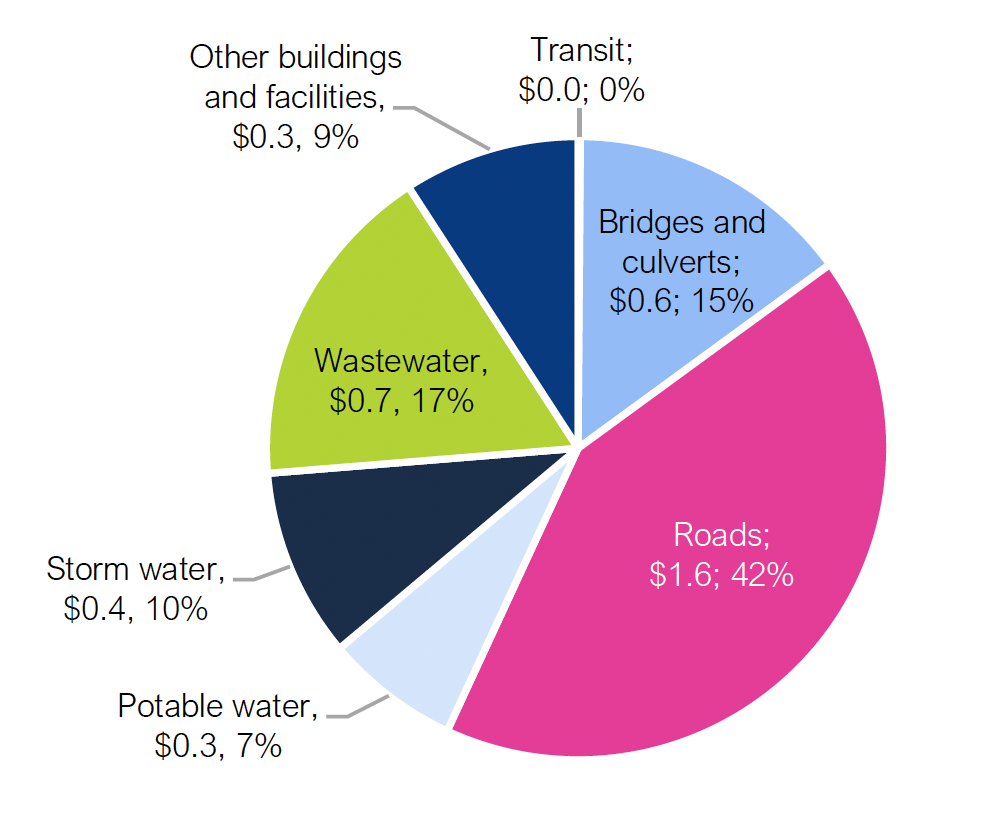
Infrastructure Backlog as a Share of CRV*
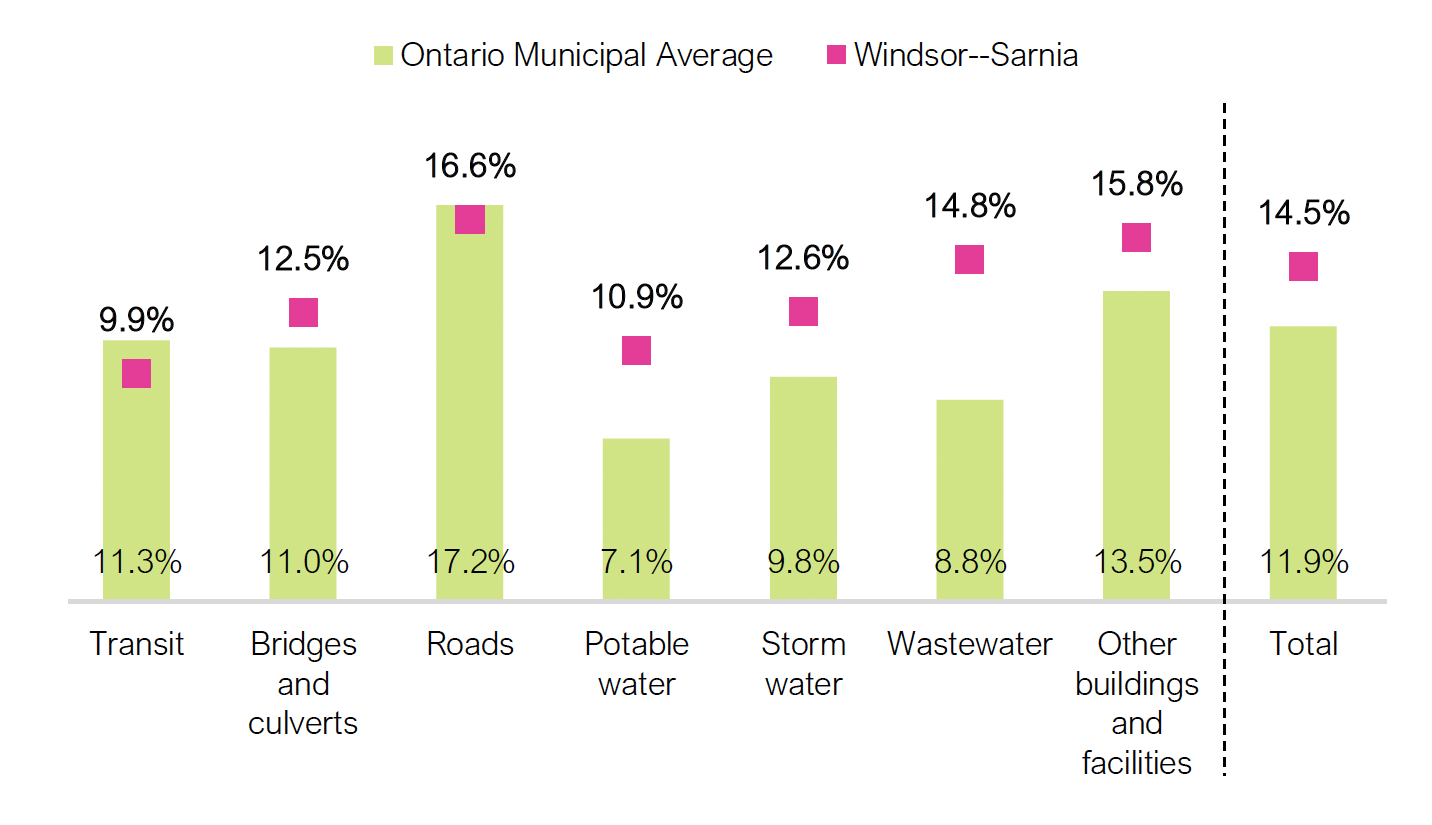
*Calculated as a share of the CRV of assets that have condition data.
Notes: The regional figures presented in these tables only encompass assets that have geolocations. The estimates presented under the state of repair and infrastructure backlog are the average values from the FAO’s Monte Carlo analysis.
Sources: Statistics Canada and FAO analysis of municipal data as detailed in Appendix D.
Accessible version
| Economic Region | Sector | Current Replacement Value of Assets ($ Billions) |
Infrastructure Backlog ($ Billions) |
Share of Assets in a State of Good Repair with Known Condition (Per Cent) |
Infrastructure Backlog as a Share of CRV with Known Condition (Per Cent) |
|---|---|---|---|---|---|
| Windsor–Sarnia | Transit | 0.1 | 0.0 | 29.4 | 9.9 |
| Windsor–Sarnia | Bridges and culverts | 4.5 | 0.6 | 49.3 | 12.5 |
| Windsor–Sarnia | Roads | 9.7 | 1.6 | 46.6 | 16.6 |
| Windsor–Sarnia | Potable water | 4.0 | 0.3 | 63.8 | 10.9 |
| Windsor–Sarnia | Storm water | 4.2 | 0.4 | 64.0 | 12.6 |
| Windsor–Sarnia | Wastewater | 4.8 | 0.7 | 55.4 | 14.8 |
| Windsor–Sarnia | Other buildings and facilities | 2.5 | 0.3 | 40.9 | 15.8 |
| Windsor–Sarnia | Total | 29.7 | 3.8 | 51.6 | 14.5 |
| Economic Region | List of Municipalities |
|---|---|
| Hamilton–Niagara Peninsula | City of Brantford, City of Burlington, City of Hamilton, City of Niagara Falls, City of Port Colborne, City of St. Catharines, City of Thorold, City of Welland, County of Brant, Regional Municipality of Halton, Regional Municipality of Niagara, Town of Fort Erie, Town of Grimsby, Town of Halton Hills, Town of Lincoln, Town of Milton, Town of Niagara-on-the-Lake, Town of Oakville, Town of Pelham, Township of Wainfleet, Township of West Lincoln, Haldimand County and Norfolk County |
| Kingston–Pembroke | City of Belleville, City of Kingston, City of Pembroke, City of Quinte West, County of Frontenac, County of Hastings, County of Lennox and Addington, County of Renfrew, County of Prince Edward County, Municipality of Centre Hastings, Municipality of Hastings Highlands, Municipality of Marmora and Lake, Municipality of Tweed, Town of Arnprior, Town of Bancroft, Town of Deep River, Town of Deseronto, Town of Greater Napanee, Town of Laurentian Hills, Town of Petawawa, Town of Renfrew, Township of Addington Highlands, Township of Admaston-Bromley, Township of Bonnechere Valley, Township of Brudenell, Lyndoch and Raglan, Township of Carlow-Mayo, Township of Central Frontenac, Township of Faraday, Township of Frontenac Islands, Township of Greater Madawaska, Township of Head, Clara and Maria, Township of Horton, Township of Killaloe, Hagarty and Richards, Township of Laurentian Valley, Township of Limerick, Township of Loyalist, Township of Madawaska Valley, Township of Madoc, Township of McNab-Braeside, Township of North Algona-Wilberforce, Township of North Frontenac, Township of South Frontenac, Township of Stirling-Rawdon, Township of Stone Mills, Township of Tudor and Cashel, Township of Tyendinaga, Township of Whitewater Region and Township of Wollaston |
| Kitchener–Waterloo–Barrie | City of Barrie, City of Cambridge, City of Guelph, City of Kitchener, City of Orillia, City of Waterloo, County of Dufferin, County of Simcoe, County of Wellington, Regional Municipality of Waterloo, Town of Bradford-West Gwillimbury, Town of Collingwood, Town of Erin, Town of Grand Valley, Town of Innisfil, Town of Midland, Town of Minto, Town of Mono, Town of New Tecumseth, Town of Orangeville, Town of Penetanguishene, Town of Shelburne, Town of Wasaga Beach, Township of Adjala-Tosorontio, Township of Amaranth, Township of Centre Wellington, Township of Clearview, Township of East Garafraxa, Township of Essa, Township of Guelph-Eramosa, Township of Mapleton, Township of Melancthon, Township of Mulmur, Township of North Dumfries, Township of Oro-Medonte, Township of Puslinch, Township of Ramara, Township of Severn, Township of Springwater, Township of Tay, Township of Tiny, Township of Wellesley, Township of Wellington North, Township of Wilmot and Township of Woolwich |
| London | City of London, City of St. Thomas, City of Woodstock, County of Elgin, County of Middlesex, County of Oxford, Municipality of Bayham, Municipality of Central Elgin, Municipality of Dutton-Dunwich, Municipality of Middlesex Centre, Municipality of North Middlesex, Municipality of Southwest Middlesex, Municipality of Thames Centre, Municipality of West Elgin, Town of Aylmer, Town of Ingersoll, Town of Tillsonburg, Township of Adelaide-Metcalfe, Township of Blandford-Blenheim, Township of East Zorra-Tavistock, Township of Lucan Biddulph, Township of Malahide, Township of Norwich, Township of South-West Oxford, Township of Southwold, Township of Zorra, Village of Newbury and Municipality of Strathroy-Caradoc |
| Northeast / Nord-est | City of Elliot Lake, City of Greater Sudbury, City of North Bay, City of Sault Ste. Marie, City of Temiskaming Shores, City of Timmins, Municipality of Callander, Municipality of Calvin, Municipality of Central Manitoulin, Municipality of Charlton and Dack, Municipality of French River, Municipality of Gordon-Barrie Island, Municipality of Huron Shores, Municipality of Killarney, Municipality of Magnetawan, Municipality of Markstay-Warren, Municipality of Mattawan, Municipality of Powassan, Municipality of St.-Charles, Municipality of Temagami, Municipality of Wawa, Municipality of West Nipissing, Municipality of Whitestone, Town of Blind River, Town of Bruce Mines, Town of Cobalt, Town of Cochrane, Town of Englehart, Town of Espanola, Town of Gore Bay, Town of Hearst, Town of Iroquois Falls, Town of Kapuskasing, Town of Kearney, Town of Kirkland Lake, Town of Latchford, Town of Mattawa, Town of Moosonee, Town of Northeastern Manitoulin and The Islands, Town of Parry Sound, Town of Smooth Rock Falls, Town of Spanish, Town of Thessalon, Township of Armour, Township of Armstrong, Township of Assiginack, Township of Baldwin, Township of Billings, Township of Black River-Matheson, Township of Bonfield, Township of Brethour, Township of Burpee and Mills, Township of Carling, Township of Casey, Township of Chamberlain, Township of Chapleau, Township of Chisholm, Township of Cockburn Island, Township of Coleman, Township of Dubreuilville, Township of Evanturel, Township of Fauquier-Strickland, Township of Gauthier, Township of Harley, Township of Harris, Township of Hilliard, Township of Hilton, Township of Hornepayne, Township of Hudson, Township of James, Township of Jocelyn, Township of Johnson, Township of Joly, Township of Kerns, Township of Laird, Township of Larder Lake, Township of Macdonald, Meredith and Aberdeen Additional, Township of Machar, Township of Matachewan, Township of Mattice-Val Cote, Township of McDougall, Township of McGarry, Township of McKellar, Township of McMurrich-Monteith, Township of Moonbeam, Township of Nairn and Hyman, Township of Nipissing, Township of Opasatika, Township of Papineau-Cameron, Township of Perry, Township of Plummer Additional, Township of Prince, Township of Ryerson, Township of Sables-Spanish Rivers, Township of Seguin, Township of South Algonquin, Township of St. Joseph, Township of Strong, Township of Tarbutt, Township of Tehkummah, Township of The Archipelago, Township of The North Shore, Township of Val Rita-Harty, Township of White River, Village of Burk’s Falls, Village of Hilton Beach, Village of South River, Village of Sundridge, Village of Thornloe and Township of East Ferris |
| Northwest / Nord-ouest | City of Dryden, City of Kenora, City of Thunder Bay, Municipality of Greenstone, Municipality of Neebing, Municipality of Oliver Paipoonge, Municipality of Red Lake, Municipality of Shuniah, Municipality of Sioux Lookout, Town of Atikokan, Town of Fort Frances, Town of Marathon, Town of Rainy River, Township of Alberton, Township of Chapple, Township of Conmee, Township of Dawson, Township of Dorion, Township of Ear Falls, Township of Emo, Township of Gillies, Township of Ignace, Township of La Vallee, Township of Lake of the Woods, Township of Machin, Township of Manitouwadge, Township of Morley, Township of Nipigon, Township of O’Connor, Township of Pickle Lake, Township of Red Rock, Township of Schreiber, Township of Sioux Narrows-Nestor Falls and Township of Terrace Bay |
| Muskoka–Kawarthas | City of Kawartha Lakes, City of Peterborough, County of Haliburton, County of Northumberland, County of Peterborough, District Municipality of Muskoka, Municipality of Brighton, Municipality of Dysart et al, Municipality of Highlands East, Municipality of Port Hope, Municipality of Trent Hills, Municipality of Trent Lakes, Town of Bracebridge, Town of Cobourg, Town of Gravenhurst, Town of Huntsville, Township of Algonquin Highlands, Township of Alnwick-Haldimand, Township of Asphodel-Norwood, Township of Cavan-Monaghan, Township of Cramahe, Township of Douro-Dummer, Township of Georgian Bay, Township of Hamilton, Township of Havelock-Belmont-Methuen, Township of Lake of Bays, Township of Minden Hills, Township of Muskoka Lakes, Township of North Kawartha, Township of Otonabee-South Monaghan and Township of Selwyn |
| Ottawa | City of Brockville, City of Clarence-Rockland, City of Cornwall, City of Ottawa, County of Lanark, Municipality of Casselman, Municipality of Mississippi Mills, Municipality of North Grenville, Town of Carleton Place, Town of Gananoque, Town of Hawkesbury, Town of Perth, Town of Prescott, Town of Smiths Falls, Township of Alfred and Plantagenet, Township of Athens, Township of Augusta, Township of Beckwith, Township of Champlain, Township of Drummond-North Elmsley, Township of East Hawkesbury, Township of Edwardsburgh-Cardinal, Township of Elizabethtown-Kitley, Township of Front of Yonge, Township of Lanark Highlands, Township of Leeds and the Thousand Islands, Township of Montague, Township of North Dundas, Township of North Glengarry, Township of North Stormont, Township of Rideau Lakes, Township of Russell, Township of South Glengarry, Township of South Stormont, Township of Tay Valley, United Counties of Leeds and Grenville, United Counties of Prescott and Russell, United Counties of Stormont, Dundas and Glengarry, Village of Merrickville-Wolford, Village of Westport, Municipality of South Dundas and The Nation Municipality |
| Stratford–Bruce Peninsula | City of Owen Sound, City of Stratford, County of Bruce, County of Grey, County of Huron, County of Perth, Municipality of Arran-Elderslie, Municipality of Bluewater, Municipality of Brockton, Municipality of Central Huron, Municipality of Grey Highlands, Municipality of Huron East, Municipality of Kincardine, Municipality of Meaford, Municipality of Morris-Turnberry, Municipality of North Perth, Municipality of Northern Bruce Peninsula, Municipality of South Bruce, Municipality of South Huron, Municipality of West Grey, Municipality of West Perth, Town of Goderich, Town of Hanover, Town of Saugeen Shores, Town of South Bruce Peninsula, Town of St. Marys, Town of The Blue Mountains, Township of Ashfield-Colborne-Wawanosh, Township of Chatsworth, Township of Georgian Bluffs, Township of Howick, Township of Huron-Kinloss, Township of North Huron, Township of Perth East, Township of Perth South and Township of Southgate |
| Toronto | City of Brampton, City of Mississauga, City of Oshawa, City of Pickering, City of Richmond Hill, City of Toronto, City of Vaughan, Municipality of Clarington, Regional Municipality of Durham, Regional Municipality of Peel, Regional Municipality of York, Town of Ajax, Town of Aurora, Town of Caledon, Town of East Gwillimbury, Town of Georgina, Town of Newmarket, Town of Whitby, Town of Whitchurch-Stouffville, Township of Brock, Township of King, Township of Scugog, Township of Uxbridge and City of Markham |
| Windsor–Sarnia | City of Sarnia, City of Windsor, County of Essex, County of Lambton, Municipality of Brooke-Alvinston, Municipality of Chatham-Kent, Municipality of Lambton Shores, Municipality of Leamington, Town of Amherstburg, Town of Essex, Town of Kingsville, Town of Lakeshore, Town of LaSalle, Town of Petrolia, Town of Plympton-Wyoming, Town of Tecumseh, Township of Dawn-Euphemia, Township of Enniskillen, Township of Pelee, Township of St. Clair, Township of Warwick, Village of Oil Springs and Village of Point Edward |
Appendix B : State of Repair by Sector
This section provides information on the state of repair and infrastructure backlog of municipal infrastructure by sector and asset-type.
| Sector | Current Replacement Value (CRV) ($ Billions) |
CRV of Assets with Condition Data ($ Billions) |
CRV of Assets in a State of Good Repair ($ Billions) |
Share of Assets in a State of Good Repair* (% CRV) |
CRV of Assets Not in a State of Good Repair ($ Billions) |
Share of Assets Not in a State of Good Repair* (% CRV) |
Infrastructure Backlog ($ Billions) |
Infrastructure Backlog as a Share of CRV* (% CRV) |
|---|---|---|---|---|---|---|---|---|
| Transit | 9.3 | 9.1 | 3.8 | 42.3% | 5.2 | 57.7% | 1.0 | 11.3% |
| Buildings | 1.8 | 1.6 | 0.7 | 42.2% | 0.9 | 57.8% | 0.1 | 6.9% |
| Engineering | 7.5 | 7.5 | 3.2 | 42.3% | 4.3 | 57.7% | 0.9 | 12.3% |
| Bridges and culverts | 40.4 | 38.8 | 19.5 | 50.2% | 19.3 | 49.8% | 4.3 | 11.0% |
| Roads | 130.1 | 122.7 | 53.7 | 43.8% | 68.9 | 56.2% | 21.1 | 17.2% |
| Potable Water | 81.5 | 74.7 | 51.1 | 68.5% | 23.6 | 31.5% | 5.3 | 7.1% |
| Buildings | 12.7 | 11.9 | 6.1 | 51.0% | 5.8 | 49.0% | 1.5 | 12.3% |
| Engineering | 68.9 | 62.8 | 45.1 | 71.8% | 17.7 | 28.2% | 3.8 | 6.1% |
| Storm water | 53.6 | 38.6 | 25.9 | 67.0% | 12.7 | 33.0% | 3.8 | 9.8% |
| Buildings | 0.9 | 0.7 | 0.5 | 62.5% | 0.3 | 37.5% | 0.1 | 7.2% |
| Engineering | 52.8 | 37.9 | 25.4 | 67.1% | 12.5 | 32.9% | 3.7 | 9.8% |
| Wastewater | 94.3 | 83.0 | 55.9 | 67.3% | 27.1 | 32.7% | 7.3 | 8.8% |
| Buildings | 23.2 | 22.1 | 9.7 | 44.0% | 12.4 | 56.0% | 3.1 | 14.0% |
| Engineering | 71.1 | 60.9 | 46.2 | 75.8% | 14.7 | 24.2% | 4.2 | 6.8% |
| Other Buildings and Facilities | 74.9 | 70.1 | 29.2 | 41.6% | 40.9 | 58.4% | 9.5 | 13.5% |
| Tourism, Culture and Sport | 19.3 | 17.6 | 5.6 | 32.0% | 12.0 | 68.0% | 3.6 | 20.2% |
| Social Housing | 23.1 | 22.6 | 8.9 | 39.2% | 13.7 | 60.8% | 2.4 | 10.7% |
| Government Admin | 19.2 | 18.0 | 9.1 | 50.3% | 9.0 | 49.7% | 1.9 | 10.7% |
| Waste Management | 1.5 | 1.4 | 0.9 | 65.7% | 0.5 | 34.3% | 0.1 | 8.3% |
| Other | 11.8 | 10.5 | 4.7 | 44.9% | 5.8 | 55.1% | 1.4 | 13.6% |
| Total | 484.2 | 437.0 | 239.2 | 54.7% | 197.8 | 45.3% | 52.1 | 11.9% |
| Buildings | 113.4 | 106.5 | 46.1 | 43.3% | 60.4 | 56.7% | 14.2 | 13.3% |
| Engineering | 370.8 | 330.5 | 193.0 | 58.4% | 137.5 | 41.6% | 38.0 | 11.5% |
Appendix C : Comparison between the State of Repair of Provincial and Municipal Assets
In a 2020 report, the FAO assessed the state of repair of the Province’s infrastructure assets.[41] Based on the FAO’s analysis, 34.7 per cent of the Province’s assets (valued at $92.1 billion) were not in a state of good repair and the total cost to bring Provincial assets into a state of good repair amounted to $16.8 billion. By comparison, an estimated 45.3 per cent of municipal assets (valued at $197.8 billion) were not in a state of good repair, resulting in an estimated backlog of $52.1 billion. For Provincial assets, the backlog to CRV ratio was estimated at 6.3 per cent, considerably lower than the estimated municipal backlog to CRV ratio of 11.9 per cent.
Importantly, the Province owns and controls different types of infrastructure than Ontario’s municipalities. For example, the province is responsible for Ontario’s hospitals and schools, while municipalities own the vast majority of Ontario’s water infrastructure (i.e., potable water, wastewater and storm water). Of the sectors and asset classes analyzed in this report, only transit, bridges and culverts and roads are owned by both levels of government. The comparisons of the state of repair and infrastructure backlog as a share of CRV of assets in these sectors (excluding the transit sector[42]) are presented below.
Bridges and culverts
- Types of bridges managed by municipalities in Ontario vary significantly compared to provincially owned bridges. Local bridges represent nearly 24 per cent of municipal bridges and culverts, compared to just 5 per cent for provincial bridges and culverts.
- An estimated 50.2 per cent of municipal bridges and culverts are in a state of good repair compared to 82.5 per cent of provincially owned bridges.
- The backlog for municipal bridges and culverts represents an estimated 11.0 per cent of their current replacement value, compared to just 1.0 per cent for provincially owned bridges and culverts.
Roads
- The types of municipally managed roads vary significantly compared to provincially managed roads. More than half of the municipally owned road network are local, while only 22 per cent of the provincially managed roads are local.
- Only an estimated 43.8 per cent of municipal roads are in a state of good repair, compared to 74.7 per cent of provincially owned roads.
- The backlog for municipal roads represents an estimated 17.2 per cent of their current replacement value, compared to just 2.8 per cent for provincial roads.
Figure C‑1 Provincial and Municipal State of repair by sector

Note: The estimates presented under the state of repair and infrastructure backlog for municipal infrastructure are the average values from the FAO’s Monte Carlo analysis.
Sources: FAO Provincial Infrastructure report and FAO analysis of municipal data as detailed in Appendix D.
Accessible version
| Share of Assets in a State of Good Repair (Per cent) |
Municipal | Provincial |
|---|---|---|
| Bridges and culverts | 50.2 | 82.5 |
| Roads | 43.8 | 74.7 |
| Infrastructure Backlog as a Share of CRV (Per cent) |
Municipal | Provincial |
|---|---|---|
| Bridges and culverts | 11.0 | 1.0 |
| Roads | 17.2 | 2.8 |
Appendix D : Data and Methodology
Municipal Asset Inventory
This section describes how the FAO compiled a Municipal Asset Inventory (MAI) from multiple data sources.
To estimate the state of repair of municipally owned infrastructure, a detailed asset inventory that includes the current replacement value, condition and age of individual assets owned by the 444 municipalities in Ontario is necessary. However, there is no comprehensive or standardized inventory for Ontario’s municipal assets. At the time of preparing this report, only partial information about municipal infrastructure was available across multiple sources, described in Table D-1.
| Source | Description | Challenges |
|---|---|---|
| Municipal Asset Datasets | Asset level data on municipal infrastructure assets collected by municipalities. Includes the CRV, condition, and age of assets, among other information. |
|
| Asset Management Plans (AMPs) | Most Ontario municipalities have an AMP. AMPs generally contain the key components outlined in the Ontario’s 2012 Guide for Municipal Asset Management Plans,[43] such as replacement values and condition ratings. |
|
| Canada’s Core Public Infrastructure Survey (CCPI) Public Use Microdata File 2018 | Statistics Canada’s CCPI 2018 survey contains information on the stock and condition of municipally owned core infrastructure.[44] |
|
| Financial Information Return 2018 (FIR) | FIR is a data tool used by the Ontario Ministry of Municipal Affairs and Housing to collect standardized financial and statistical information from municipalities. Schedule 51 of the FIR collects the net book value of tangible capital assets from municipalities.[45] |
|
| Ontario Ministry of Infrastructure Municipal Asset Inventory | Ontario’s Ministry of Infrastructure created its own municipal infrastructure database using multiple sources including AMPs and the FIR. This data source provides condition and CRV estimates for the majority of municipal infrastructure. |
|
The FAO compiled the MAI by analyzing and consolidating information from all these available sources. However, due to the differing coverage and quality of the data sources, the methodology the FAO used to compile the MAI varied based on the types of assets and municipalities. The following sections present the detailed approach used by the FAO to create the dataset.
Asset Groupings
The FAO divided municipally owned infrastructure into linear and non-linear groups to maximize the strengths of each data source with the fewest assumptions.
Linear Infrastructure
Linear infrastructure categories include roads, bridges and tunnels, linear transit (bridges, roads, tracks and tunnels), potable water pipes, storm water (pipes, ditches and culverts), and wastewater (sanitary force mains and pipes) assets. While information on linear infrastructure was available from different sources, the FAO used the CCPI microdata file to obtain the length/quantity and categorical condition data, as CCPI contained the most current length[46] and categorical[47] condition of the highest number of asset subtypes in a consistent format.
As the CCPI data does not contain CRV estimates, the FAO developed replacement value unit costs for each different asset subtype by geographic regions (Central, Southeast, Southwest, Northwest, and Northeast). The unit costs were estimated in the following manner:
| Sector | Method/Source |
|---|---|
| Roads |
|
| Bridges and tunnels |
|
| Transit |
|
| Potable water |
|
| Storm water |
|
| Wastewater |
|
The CRV of the various linear asset types was calculated by multiplying a municipality’s asset length/quantity obtained from CCPI with the region-specific unit cost for the asset. However, when an individual municipality’s unit cost was available, the municipality’s asset length/quantity from CCPI was multiplied by that municipality-specific unit cost. To use the most detailed data possible, the CCPI-based dataset was supplemented with data collected from individual municipalities wherever available.
At this stage of development, all linear-engineering infrastructure assets have been compiled, which include quantity and CRV estimates and numerical/categorical condition assessments.
Non-Linear Infrastructure
Non-linear infrastructure categories include buildings and facilities in tourism, culture and recreation, social housing, solid waste, health, justice, government administration, transit, potable water, storm water and wastewater sectors. The various data sources had information on different sectors of buildings and facilities. For example, the CCPI did not have any data on buildings and facilities in government administration, health or justice sectors since these sectors are not included in the definition of “core” infrastructure.
The FAO combined numerous data sources for vertical assets in the MAI. Due to the different reporting formats used by the various sources, a reliable estimate of the total count of all municipally owned buildings and facilities in Ontario was not available. Given these limitations, the FAO collected and merged information from the sources listed below to obtain the best possible estimate of the total CRV and condition of municipally owned buildings and facilities in the province.
- Information Requests: The FAO obtained highly detailed, individual asset-specific CRV, condition and age data of buildings and facilities from numerous municipalities directly, allowing the FAO to assess the state of repair of non-linear infrastructure assets that provide service to approximately 3.7 million Ontarians (nearly 27.4 per cent of Ontario’s population).
- Asset Management Plans: The FAO analyzed AMPs, collecting CRV, condition, and age data from 27 Ontario municipalities.
- Ontario Ministry of Infrastructure’s Municipal Asset Inventory: The FAO used MOI’s dataset for any information that was not obtained through information requests or AMPs.
- CCPI: This survey had condition information for several municipalities that were not available elsewhere. However, there was no CRV for these assets. The FAO used MOI’s CRV estimation process[48] to impute CRVs for those municipalities.
- Financial Information Return (FIR): The FIR was used for the remaining municipalities with no data. Asset age and condition was estimated based on amortization schedules, while CRV was estimated from the reported historical costs which were inflation-adjusted based on asset age.
Summary of CRV by Source
A summary of the share of both linear and non-linear assets by data source is presented below. The majority (70.9 per cent) of the CRV data in the FAO’s MAI is based on the estimated unit costs.
| Source of CRV | Source of Condition | CRV ($ Billions) |
Share of Assets by CRV (Per Cent) |
|---|---|---|---|
| Unit Cost | CCPI | 343.3 | 70.9 |
| Information Request | Information Request | 43.0 | 8.9 |
| AMP | AMP | 33.0 | 6.8 |
| MOI | CCPI | 18.2 | 3.8 |
| MOI | FIR | 14.0 | 2.9 |
| MOI | MOI | 13.3 | 2.7 |
| Information Request | CCPI | 10.1 | 2.1 |
| Estimated | CCPI | 9.1 | 1.9 |
| FIR | FIR | 0.2 | 0.0 |
| Total | 484.2 | 100.0 |
Standardizing Infrastructure Condition Ratings
The FAO found three major types of condition metrics used by different municipalities, presented in the table below.
| Type | Description |
|---|---|
| Categorical Condition | Condition categories, typically presented as: Very Good, Good, Fair, Poor, Very Poor. |
| Condition Score | On a scale of 0-100, with 100 indicating an asset that needs no renewal or repair. |
| Facility Condition Index (FCI) | FCI ranges from 0 to 1, with 0 indicating an asset that needs no renewal or repair. |
Numerical Conditions
The first step the FAO took was to standardize numerical conditions that were taken from either condition scores or FCIs. The FAO standardized all numeric condition data so that measurements range from 100 to 0, with 100 indicating the highest condition asset and zero the lowest. For municipalities that report FCI, this measure was taken as a proxy of the condition and converted to the 100 to 0 scale. These numerical conditions were used directly in the FAO’s model and did not need further adjustment.
Categorical Conditions
Next, the FAO standardized categorical conditions. Municipalities use different condition categories to describe the state of their assets. Some municipalities use the five standard condition categories which include Very Good, Good, Fair, Poor, and Very Poor, while others used alternative categories, such as Average, Critical, or Past Due. The FAO analyzed the AMPs of the municipalities that use non-standard assessments to understand the definition of their conditions and aligned these measurements to the five standard categories.
During this process, the FAO found two major sources of uncertainty in the condition data:
- There was often no way of knowing how asset conditions were determined. In some cases, reported condition data was based on engineering site inspections, while in other cases the data may have been imputed based on the asset’s age, or may simply reflect the municipality’s judgement in the absence of a site inspection.
- The categorical conditions across municipalities were not directly comparable. Even when municipalities use the same label, these could mean different things. For example, a ‘Good’ condition asset in one municipality may not mean the same thing as a ‘Good’ condition asset in another municipality.
To account for this uncertainty, the FAO defined a broader boundary for each reported condition category. For instance, an asset reported as ‘Good’ could take on a condition from ‘Very Good’ to ‘Fair’. The broadened categories are described in Table D-5.
| Reported Condition | Upper Condition Limit | Lower Condition Limit |
|---|---|---|
| Very Good | Very Good | Good |
| Good | Very Good | Fair |
| Fair | Good | Poor |
| Poor | Fair | Very Poor |
| Very Poor | Poor | Very Poor |
To assess the state of repair of infrastructure and the corresponding infrastructure backlog, point estimates of the condition of infrastructure are necessary. Categorical conditions (such as Good, Fair, etc.) must be converted to numerical conditions. To do this, the FAO used the CCPI definition of the five condition categories and mapped the categories to numeric condition ranges based on the performance standards of asset categories used in the FAO’s deterioration model described in Table D-8. These conversions are presented in Table D-6.
| Condition | Definition | Condition Range* |
|---|---|---|
| Very poor | Immediate need to replace most or all of the asset. There are health and safety hazards that present a possible risk to public safety, or the asset cannot be serviced or operated without risk to personnel. Major work or replacement is urgently required. The operating asset has less than 10 per cent of its expected service life remaining. | Below failure threshold |
| Poor | Failure likely and substantial work required in the short term. Asset barely serviceable. No immediate risk to health or safety. The operating asset has less than 40 per cent of its expected service life remaining. | Above failure threshold to below the midpoint between repair target and failure threshold |
| Fair | Significant deterioration is evident. Minor components or isolated sections of the asset currently need replacement or repair, but the asset is still serviceable and functions safely at an adequate level of service. The operating asset has at least 40 per cent of its expected service life remaining. | Below repair target to above the midpoint between repair target and failure threshold |
| Good | Acceptable physical condition with minimal short-term failure risk, but has potential for deterioration in the long term. Only minor work required. The operating asset has at least 80 per cent of its expected service life remaining. | Above repair target to below the midpoint between perfect condition and repair target |
| Very good | Sound physical condition. The asset is likely to perform adequately. The operating asset has at least 95 per cent of its expected service life remaining. | Perfect condition to above the midpoint between perfect condition and repair target |
Figure D-1 presents an illustrative example of how the five condition categories were converted to a range of numeric condition.
Figure D‑1 Example of numeric condition ranges based on an asset deterioration curve
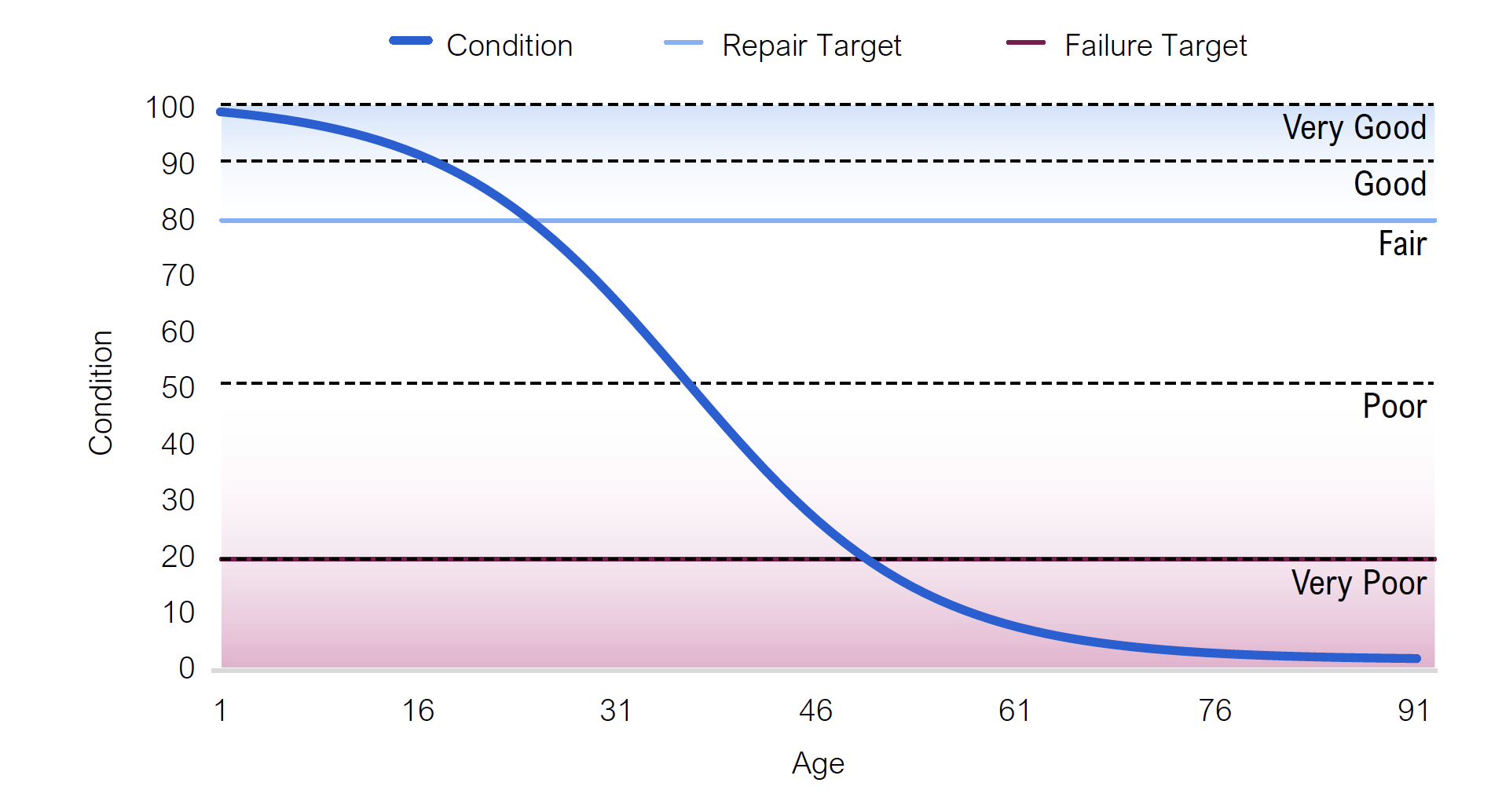
Source: FAO.
Accessible version
The figure illustrates how numeric condition ranges were assigned to five condition categories (Very Good, Good, Fair, Poor, and Very Poor) based on an asset deterioration curve.
To account for the uncertainty in asset condition data, the FAO conducted a Monte Carlo analysis where numerical condition estimates were generated from between the upper and lower categorical ranges presented in Table D-5.
For example, if a municipal building asset has a categorical condition of ‘Good’, the FAO assumes that the asset could be in any condition from ‘Very Good’ to ‘Fair.’ The highest condition score of a ‘Very Good’ municipal building is 100 while the lowest condition of a ‘Fair’ municipal building is 50. Assuming the asset has equal probability of having any condition score within this range, a random condition score was generated from this range of 50 to 100.
This process was repeated for each asset 5,000 times to generate a range of possible condition scores. The state of repair and infrastructure backlog was calculated based on these randomly generated condition estimates. The average result of the simulations has been presented throughout the report.
Estimating State of Repair and Infrastructure Backlog
The methodology used in this report to determine the state of repair of infrastructure and estimate the infrastructure backlog is largely based on infrastructure modelling techniques developed by Ontario’s Ministry of Infrastructure (MOI), which were further adapted by the FAO to include water engineering infrastructure (potable water, storm water and wastewater assets).
The state of repair framework uses infrastructure deterioration modelling which, through a series of simplified asset management decisions, estimates the current state of repair and infrastructure backlog.
The FAO’s estimates of the state of repair and the infrastructure backlog are sensitive to the data and methodology used in this report. Because there is no consensus on the definitions of the infrastructure backlog and the state of good repair, it is necessary to make assumptions while recognizing that the definitions are subject to debate.[49]
Measuring the State of Repair and Calculating the Infrastructure Backlog
Once the MAI was assembled and the condition values were generated based on the framework defined in the section above, the asset data was assessed in the infrastructure deterioration model to determine whether each asset is in a state of good repair based on the performance standards outlined in Table D-8 below. If the asset was not in a state of good repair, the FAO then determined if that asset required capital spending, including the type and amount of capital spending needed to bring each asset into a state of good repair (i.e., the infrastructure backlog). The process is outlined in Table D-7 and is based on decision rules developed by MOI.
| If the Asset’s… | Asset’s State of Repair | Capital Spending Required | Type of Capital Spending | Infrastructure Backlog |
|---|---|---|---|---|
|
In a State of Good Repair | No | N/A | Zero |
|
Not in a State of Good Repair | Yes | Rehabilitation | Amount necessary to bring asset’s condition to Repair Target[50] |
|
Not in a State of Good Repair | No | N/A | Zero. These assets will be allowed to deteriorate until Failure Threshold, at which point they will be renewed. |
|
Not in a State of Good Repair | Yes | Renewal | Amount equal to CRV |
The information and performance standards used to determine an asset’s state of good repair and infrastructure backlog are described below.
- Condition – See Standardizing Infrastructure Condition.
- Age – The actual age of an asset when available. When the actual age was not available, an implied age was calculated based on condition.
- Current Replacement Value – The current cost of rebuilding an asset with the equivalent capacity, functionality and performance as the original asset.
- Asset-type – The type of asset, such as building, transit engineering infrastructure, potable water pipe, etc.
- Repair Target – The condition which, at or above, an asset does not require any current capital spending and is considered acceptable from both an engineering quality assessment and cost management perspective. Assets with conditions at or above the repair target are considered to be in a state of good repair.
- Failure Threshold – The condition which, at or below, an asset must be replaced with a new asset (i.e., renewal) to bring that asset into a state of good repair.
- Design Life – The number of years which an asset is designed to remain in operation. Assets typically remain in use for longer than their design life.
- Useful Life – The number of years which an asset typically remains in operation. The FAO assumes an asset’s useful life is twice its design life.
The following table includes the performance standards used by the FAO to determine whether an asset is in a state of good repair and estimate its respective infrastructure backlog. However, municipalities may adopt different targets and consider other factors when making their actual capital spending decisions.[51] Importantly, estimates of the share of assets in a state of good repair and the infrastructure backlog will vary depending on the targets used.[52]
| Sector | Asset Class | Asset Type | Repair Target | Failure Threshold | Design Life (Years) |
|---|---|---|---|---|---|
| Transit | Buildings | 90 | 35 | 17 | |
| Engineering | 90 | 35 | 21 | ||
| Bridges and culverts | Engineering | 76 | 40 | 52 | |
| Roads | Engineering | Arterial Roads | 80 | 35 | 31 |
| Collector Roads | 75 | 40 | 31 | ||
| Freeways | 80 | 55 | 32 | ||
| Local Roads | 70 | 35 | 31 | ||
| Potable Water | Buildings | Potable Water Facilities | 70 | 15 | 67 |
| Engineering | Local Pipes | 45 | 15 | 66 | |
| Transmission Pipes | 45 | 15 | 71 | ||
| Pipes of Unknown Diameter | 45 | 15 | 62 | ||
| Storm Water | Buildings | Storm water facilities | 70 | 15 | 67 |
| Engineering | Small Pipes | 55 | 25 | 60 | |
| Medium Pipes | 55 | 25 | 64 | ||
| Large Pipes | 55 | 25 | 73 | ||
| Unknown Pipes | 55 | 25 | 63 | ||
| Ditch | 55 | 25 | 52 | ||
| Culvert | 55 | 25 | 43 | ||
| Wastewater | Buildings | Wastewater Facilities | 70 | 15 | 67 |
| Engineering | Small Pipes | 60 | 30 | 67 | |
| Medium Pipes | 60 | 30 | 70 | ||
| Large Pipes | 60 | 30 | 74 | ||
| Pipes of Unknown Diameter | 60 | 30 | 63 | ||
| Sanitary Mains | 60 | 30 | 64 | ||
| Other buildings and facilities | Buildings | Municipal Buildings and facilities | 80 | 20 | 49 |
| Government Administration | 70 | 15 | 67 | ||
| Courthouses | 85 | 20 | 56 | ||
| Correctional facilities | 85 | 20 | 49 | ||
| Long-term care buildings | 79 | 20 | 39 |
Footnotes
[1] Municipalities may have more accurate data on the replacement cost and condition of their infrastructure than the FAO was able to obtain. Additionally, municipalities may evaluate their assets through different performance standards and asset management practices than used by the FAO. For more details on the FAO’s municipal data and methodology see Appendix D.
[2] For more information about Ontario’s municipalities see Ministry of Municipal Affairs and Housing: List of Ontario municipalities.
[3] Table 3-1 summarizes the scope of municipal infrastructure assets examined in this report.
[4] Appendix D provides details on the performance standards the FAO used in this report to determine “state of good repair”.
[5] State of good repair thresholds are defined based on modelling performance standards developed by Ontario’s Ministry of Infrastructure and further supplemented by the FAO. For more information see Appendix D.
[6] There is no common definition of the infrastructure backlog. See Appendix D for a description of how the infrastructure backlog is calculated in this report.
[7] Investing in Canada — Canada’s Long-Term Infrastructure Plan, Infrastructure Canada, Government of Canada, 2018.
[8] For a technical discussion on what constitutes public infrastructure see Baldwin, John R. and Dixon, Jay, Infrastructure Capital: What is it? Where is it? How Much of it is There? (March 12, 2008). Canadian Productivity Review Research Paper No. 16.
[9] Statistics Canada, “Table 36-10-0608-01 Infrastructure Economic Accounts, investment and net stock by asset, industry, and asset function (x 1,000,000).”
[10] See the FAO’s 2020 Provincial Infrastructure report.
[11] Based on analysis of the Ontario Ministry of Municipal Affairs’ Financial Information Return. The figures represent average shares from 2009 to 2018.
[12] See O. Reg. 588/17: Asset Management Planning for Municipal Infrastructure and Ontario’s Regulatory Registry.
[13] For a detailed description of how the FAO compiled its municipal asset inventory, see Appendix D.
[14] In this report, state of good repair depends on performance standards of acceptable asset conditions (i.e., repair targets), which vary across asset-types. Appendix D provides details on the repair targets used in this report.
[15] 2017 Long-term Infrastructure Plan: Technical Appendix, Ministry of Infrastructure, Government of Ontario.
[16] There is no common definition of the infrastructure backlog. For example, some infrastructure assessments describe the backlog as the capital spending required to address deferred renewal investments, while others consider the costs associated to bring and maintain existing assets to a “perfect” condition over the next three years. Some assessments of the backlog may also include costs to satisfy the future demand for infrastructure capacity and service improvements. See Appendix D for a description of how the infrastructure backlog is calculated in this report.
[17] Rehabilitation is the repair of all or part of an asset, extending its life beyond that of the original asset, without adding to its capacity, functionality or performance. Rehabilitation is different from maintenance, which is the routine activities performed on an asset that maximize service life and minimize service disruptions. Assets are rehabilitated to a state of good repair (the repair target) and not to a new condition.
[18] Renewal is the replacement of an existing asset, resulting in a new or as-new asset with an equivalent capacity, functionality and performance as the original asset. Renewal is different from rehabilitation, as renewal rebuilds the entire asset.
[19] The FAO’s estimates of the state of repair and the infrastructure backlog are sensitive to the data and methodology used in this report. Appendix D include more information on the sources and quality of data as well as the methodology used in the FAO’s analysis.
[20] See The State of Ontario’s Water and Wastewater Infrastructure, Provincial-Municipal Fiscal and Service Delivery Review , and Canadian Infrastructure Report Card 2016 for details.
[21] Based on analysis of the Ontario Ministry of Municipal Affairs and Housing’s Financial Information Return, Public Accounts of Ontario, and Public Accounts of Canada the FAO estimates that municipalities own roughly 52 per cent of public infrastructure assets in Ontario, while the Government of Ontario owns 38 per cent and the federal government owns 10 per cent. These estimates include only tangible capital assets that are consolidated on government balance sheets and exclude non-consolidated assets. Importantly, since these estimates are based on accounting information they will not align with the current replacement value estimates presented in this report or the FAO’s 2020 Provincial Infrastructure report.
[22] Different municipalities deliver different services depending on their tier. See Ontario Municipalities for details on services provided by different tiers of municipalities in Ontario.
[23] See O. Reg. 588/17: Asset Management Planning for Municipal Infrastructure.
[24] Statistics Canada defines core public infrastructure assets to include: roads, bridges and tunnels; storm water, wastewater, and potable water; culture, recreation and sports facilities; public social and affordable housing; public transit and solid waste.
[25] Current replacement value also accounts for improvements in construction technology and materials, which would deliver equivalent service capacity for an equal or lesser cost, slightly offsetting increased costs due to inflation.
[26] 2017 Long-term Infrastructure Plan: Technical Appendix, Ministry of Infrastructure, Government of Ontario.
[27] The term “state of good repair” is used by some entities to refer to an asset operating as intended, delivering the services which the asset was placed into operation to provide. In this report, state of good repair depends on performance standards of acceptable asset conditions (i.e., repair targets), which vary across asset-types. Appendix D provides details on the repair targets used by the FAO in this report.
[28] 2017 Long-term Infrastructure Plan: Technical Appendix, Ministry of Infrastructure, Government of Ontario.
[29] Asset managers may also use alternative targets to evaluate their infrastructure assets. For example, one municipality may use different standards to measure the condition of its assets relative to another municipality. For this report, the FAO has applied a standardized methodology to calculate the state of good repair for all municipal assets based on performance targets provided by the Ontario Ministry of Infrastructure and further developed by the FAO.
[30] The repair target is the condition which, at or above, an asset is considered in a state of good repair. The failure threshold is the condition which, at or below, an asset must be replaced with a new asset (i.e., renewal) to bring that asset into a state of good repair. The useful life is the number of years that an asset typically remains in operation. Appendix D provides additional details on the methodology used in this report.
[31] For details, see Appendix D.
[32] There is no common definition of the infrastructure backlog. For example, some infrastructure assessments describe the backlog as the capital spending required to address deferred renewal investments, while others consider the costs associated to bring and maintain existing assets to a “perfect” condition over the next three years. Some assessments of the backlog may also include costs to satisfy the future demand for infrastructure capacity and service improvements. See Appendix D for a description of how the infrastructure backlog is calculated in this report.
[33] Rehabilitation is the repair of all or part of an asset, extending its life beyond that of the original asset, without adding to its capacity, functionality, or performance. Rehabilitation is different from maintenance, which comprises the routine activities performed on an asset that maximize service life and minimize service disruptions. Assets are rehabilitated to a state of good repair (the repair target) and not to a new condition.
[34] Renewal is the replacement of an existing asset, resulting in a new or as-new asset with an equivalent capacity, functionality, and performance as the original asset. Renewal is different from rehabilitation, as renewal rebuilds the entire asset.
[35] The FAO’s estimates of the infrastructure backlog are sensitive to the data and methodology used in this report. Municipalities manage a diverse portfolio of assets and may use different methodologies to determine the state of repair and infrastructure backlog of their assets, which may not align with the estimates presented in this report. Appendix D include more information on the sources and quality of data and the methodology used in the FAO’s analysis.
[36] The poorer the condition of an asset, the higher the ratio of infrastructure backlog to CRV.
[37] Defined by Statistics Canada, Ontario’s economic regions are groupings of census divisions used to create a standard geographical unit for analyzing regional economic activity. For more information, see Statistics Canada’s Standard Geographical Classification – Economic Regions.
[38] See Table A-2, for a list of all municipalities under each economic regions of Ontario.
[39] While the physical location of municipal infrastructure is within economic regions, many assets serve residents beyond the boundaries of economic regions. For example, roads in the Toronto economic region serve anyone driving in this region, not only the residents of the region.
[40] The estimates presented include only those assets which have geographic and condition information.
[41] Provincial Infrastructure: A Review of the Province’s Infrastructure and an Assessment of the State of Repair.
[42] The transit sector was excluded due to a lack of comparable data.
[43] For details, see Archived – Building together – Guide for municipal asset management plans.
[44] See Canada’s Core Public Infrastructure Survey (CCPI).
[45] See Financial Information Return.
[46] Except for bridges and tunnels for which quantity information was available.
[47] The CCPI condition categories are Very Good, Good, Fair, Poor, and Very Poor. Every municipality reports the distribution of the assets in different condition groups.
[48] MOI’s CRV estimation involved using available data to estimate CRV based on three demographic characteristics: per capita, per household and per usual household. The average of these three estimates is used for the final CRV estimate.
[49] Municipalities manage a diverse portfolio of assets and may use different methodologies to determine the state of repair of their assets and the associated infrastructure backlog, which may not align with the estimates presented in this report.
[50] To estimate the cost of rehabilitation, the FAO assumes that there is a direct relationship between an asset’s measured condition and the current replacement value of an asset. For example, if an asset’s condition index is 70 and its Repair Target is 85, rehabilitation costs are calculated by multiplying the asset’s CRV by the difference between the Repair Target and current condition, that is, CRV x [(85-70)/100]. For assets measured with a Facility Condition Index (FCI), this is true based on the definition and calculation of FCI. However, for assets measured
using a Pavement Condition Index (PCI), Bridge Condition Index (BCI) or other technique this relationship is assumed. Additionally, municipalities may use different approaches to address the rehabilitation and renewal needs of their assets, which may not align with the simplified approach taken in this report.
[51] For example, municipalities may have different targets for the state of repair of their assets than those used in this report. It is also unlikely that municipalities use the same targets as one another. This report evaluates all municipal infrastructure using a consistent framework.
[52] If the repair targets were higher than those in Table D-8, the share of assets in a state of good repair would be lower and the infrastructure backlog would be higher than the estimates presented in this report. In contrast, if the repair targets were lower, the share of assets in a state of good repair would be higher and the backlog would be lower.

